New School Fall Gardening Stretegies
By Katherine Placzek
With fall approaching, many of you are getting ready to put your garden beds and other portions of the landscape to bed. With a more eco-friendly mindset, we would like to suggest a couple of tweaks to your typical routine.
Old school: Raking and bagging leaves, tossing them out for the trash.
New school: Rake leaves from below trees, and use them as mulch around your perennials, shrubs, or on top of your vegetable garden beds. You can also run these over with a lawn mower to mulch them into your grass.
Why: Organic matter, including yard waste, is the most prolific item in United States landfills. Consequently, this unsustainable practice directly contributes to greenhouse gas emissions. Conversely, organic material returned to the soil reduces your environmental impact while providing a useful garden resource. These local sources of organic material and nutrition (from your own yard’s leaves) will feed and insulate your yard all winter long! Decomposing leaf matter enriches the soil, adding carbon and nitrogen to the soil, while plants “sleep.” Leaves also create safe places for native bees and other pollinators. Did you know that almost three-fourths of Colorado’s native bees nest and overwinter underground? Tip: Deeply water the leaf litter in after it has been placed. This creates a wet decomposing mat that will not blow away as easily.
If you have excess leaves that you are not going to be using, please feel free to bring your bagged leaves by our nursery gate (located at 600 N. 18th St. Colorado Springs, CO 80904). This is a community pile that other members come to gather for their own gardening usage.
Old School: Trim any perennials and remove them before the first snow.
New School: Leave all of your woody stalks, leaf matter, and ornamental grasses all winter long!
Why: This allows for winter interest and provides shelter for any hibernating insects. This is especially true for native plants that act as habitat for many native and beneficial insects. Larger life forms, including birds and mammals, will also benefit from grass seed heads left standing, and other plants that provide shelter in the harshest months. If this is unsightly for you, trim your plants, but leave the stems and other leaf matter on the ground to help create shelter throughout the winter. When soil temperature has reached 50 degrees Fahrenheit it’s the preferred time to begin trimming these perennials in the spring, after many insects have completed their wintering cycle.
Old School: Let the winter snows water your outdoor plants.
New School: Water trees, shrubs, and perennials on nice days throughout the winter.
Why: Unfortunately Colorado Springs does not get enough reliable winter moisture to overwinter many plants. This is especially true for newer plants that do not have an established root system yet. Many trees and shrubs, even those that are well-established, should continue to be watered on warm winter days from October through March. When it gets up to 40 degrees Fahrenheit, pull out a hose or dust off your watering can and soak up some of those winter rays, yourself, while you water. Make sure you unhook any hoses after use, as temperatures can cause freezing in the hose bib and other hardware.
Old School: Say goodbye to gardening until spring.
New School: Fall and winter sow, including vegetable and perennial flower seeds.
Why: Many annual vegetables and perennial flowers have a natural cycle where they drop seeds or fruit in the fall. Mimic nature and plant some of your own seeds in the fall to see what comes up earlier and hardier in the spring! In the vegetable garden, this especially works for cold hardy greens. Think spinach, lettuce, arugula, radicchio, etc. For perennial flowers, like wildflowers, it is recommended to put these seeds down in the fall, as many of our native flowers require a cold stratification period. While many people may set up sections in their freezer and fridge for cold stratification processes, direct seeding in the fall eliminates the juggling of space in your fridge/ freezer. Let the ice cream stay where it is!
Old School: Wait until spring to amend any of your garden beds.
New School: Amend your garden beds in the fall so you can plant right away in the spring.
Why: Fall is a good time to test your soil so you know how to amend your beds. Our soils typically fall in the basic pH range here in the greater Colorado Springs area. This can impact how readily available nutrients are to our plants. Do your research and get your soil properly in shape for your spring! Remember that you can also amend with what nature provides; leaves, manure, compost, and other organic matter. These sources do not have a precise N-P-K (macronutrients: nitrogen, phosphorus, potassium), nor spelled out micronutrients (calcium, magnesium, iron, etc) so it is recommended to test your soil in the spring again to see how your soil has changed due to any unregulated organic material. We offer pH and N-P-K, testing in-store, but the CSU extension office also offers a wide range of soil tests.
Now that you know these new school techniques, you might just try other new gardening techniques in the growing season. I know, I know- I am getting ahead of myself! Happy gardening!
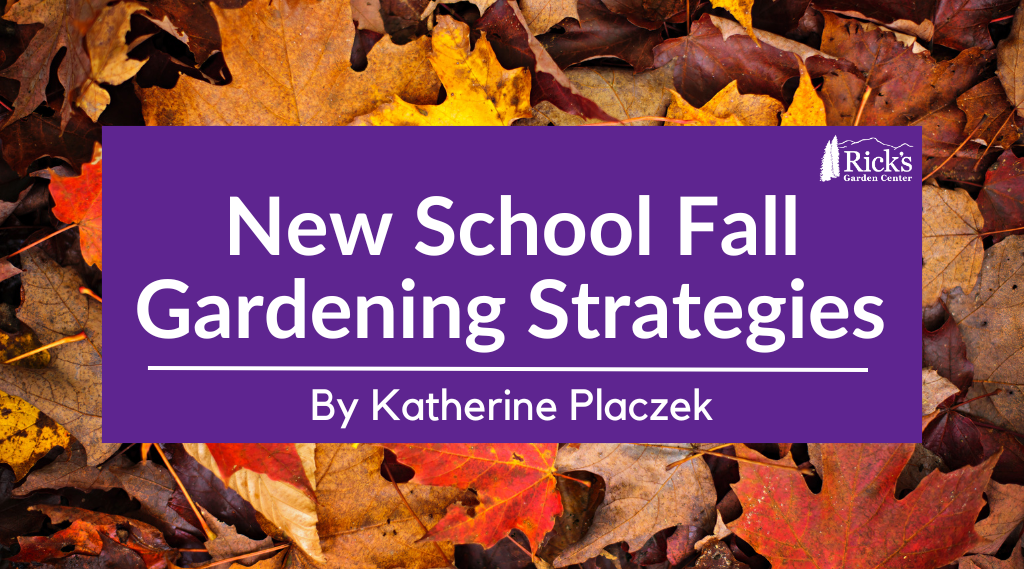
Coco Coir vs Peat Moss
By Katherine Placzek
Dear reader,
This article began initially with a straightforward trajectory. I was going to lay out why using peat moss in soil mixes is environmentally harmful and that we all should make the switch to using coco coir. But as I continued my research, I found it was not that simple and the subject required lots of continued digging to find accurate information. Instead, I am going to try to educate you on both substrates to the best of my ability.
Peat Moss:
Why is it used:
Peat moss has an incredible water retention capability- holding 20 times its weight in water. It also has a small but not insignificant amount of nutrients. You can pot a plant directly in peat moss and it will grow due to these nutrients. It is light and fluffy, used by many gardeners to lighten existing soils. It is highly acidic if not amended with lime, and shrubs like hydrangeas or blueberries can successfully be planted into peat. It also can be used as a pea/bean inoculant. It was not until the 1970s that peat became commonplace as a planting substrate for plant people.
How is it harvested/manufactured:
Peat bogs have centuries (possibly more) worth of plants and decomposing peat/sphagnum peat growing and compacting in a dynamic cycle and ecosystem. It is estimated that peat bogs contain more than 44% of all the Earth’s soil carbon and thus are considered a carbon sink (where carbon is stored and absorbed from the atmosphere). Harvesting practices vary in different bogs and countries. The majority of the peat sold in the United States is harvested in Canada. 95% of all peat in Canada is harvested in partnership with the Canadian Sphagnum Peat Moss Association (CSPMA). The CSPMA has strict regulations that they follow, and are involved in many ecological restorations, as well as scientific research behind peat bogs, and the living organisms that use the bogs as habitat. Many of their practices publicize that they attempt to reduce harm, prevent overharvesting, protect habitats, and replant as part of their aim toward sustainability. While this sounds good, in 2021, it was reported that peat harvesting released 2.1 megatonnes of carbon dioxide into the environment. That’s the equivalent emissions of the annual emissions of five gas-fired power plants. Critics also point out that rehabilitated peat bogs are unable to become a carbon-accumulating ecosystem (or a carbon sink) until roughly 20 years after harvesting. Harvesting in other countries is not regulated and they are likely not as concerned with any harm associated with their practices. All harvesting is mechanical due to utilizing fossil fuels. The UK has banned all peat sales for personal gardens beginning in 2024.
Factors to consider:
- Peat bogs house diverse and intricate habitats for all sorts of living organisms. Harvesting, regardless of practice, disrupts this environment.
- Peat bogs are considered carbon sinks- absorbing carbon from the atmosphere. Harvesting peat releases carbon into the atmosphere, causing concern that this practice contributes to climate change.
- Fossil fuels are used in the harvesting process and are used in the shipping of this product to garden centers and other plant/ home improvement stores.
Coco Coir:
Why is it used:
Coco Coir also has a high water retention rate, retaining 8-9 times its weight in water. It does not have any innate nutrients or pH implications, so it is a neutral starting point as a substrate. Coco coir is a waste product from all other food-grade products made from the meat/ milk of the coconut. Before the 1980s, millions of tons of coco coir were left to decompose in large piles, often taking close to 20 years to decompose. Now there is a market for this “waste product,” as a soil substrate.
How is it harvested/manufactured:
Many coconut plantations are based in the poorest countries, Sri Lanka, India, Vietnam, the Philippines, and more recently, in Central and South America and even Mexico. Coconut plantations are often monocultures that reduce natural biodiversity and cause displacement of living organisms. Coconut trees produce a lot of coconuts but do so at the cost of soil degradation. The coconut hull first is soaked in water (freshwater or saltwater) for a long time to break down the fibers on the hull. This process is called retting. The retting process generates water pollution. Among the major organic pollutants are pectin, fat, tannin, toxic polyphenols, and several types of bacteria including salmonella. While scientists are experimenting with treatment options, there does not seem to be a broad-scale accepted solution at this time. This wastewater is often returned to the local community’s water supply or the ocean. Then, either the coconut hulls can be highly processed through mechanical mastication, or beaten and broken down further by hand. This manual process creates a lot of dust, and workers are typically not provided any PPE (Personal Protective Equipment). Reports indicate an increase in respiratory illnesses in communities with coco coir processing. Many of the following processes, if mechanized, are achieved with fossil fuels. There are currently no regulations on the industry’s standards. I also found conflicting information on whether a second rinse with chemicals is necessary, so that is an additional set of pollution outputs to consider. In general, it’s harder to find reputable sources explicitly sharing information about coco coir. This makes me concerned about the transparency of the industry, as well as possible offenses that are intentionally hidden from the public’s knowledge.
Factors to consider:
- Many coconut plantations are monocultures, created by destroying native habitats for diverse organisms, thus causing soil degradation.
- Pollution of the environment due to wastewater from retting processes.
- The lack of regulations concerning this product allows for humanitarian abuses to occur, including health hazards for workers and the surrounding community.
- Fossil fuels are used in portions of the manufacturing process and in transporting this product to your local garden center.
I think continuing to use coco coir or peat moss warrants extra research. Dig into the companies that you are supporting. Do they have certifications, and third-party ratings that indicate that they care about their staff’s health and wellbeing? The environment and the community they impact? Their carbon footprint? Other points that you are passionate about?
All of this makes me consider, there have been gardeners and plants people before me who did not have access to these substrates. What did they use before? Compost. Manure. Leaves. Green manures/ cover crops. Aged forest products (humus). Straw. None of these probably have the water retention that peat moss or coco coir boast, but they all have higher nutrition, which means prior plants people did not have to fertilize in the same manner that we do when we utilize a peat or coco coir base. Many of these local inputs are also free. All of this is interesting and will lead to further research on my part.
The most honest conclusion that I can make is that, when we are removed from the product we are buying, we also become naïve of the ultimate cost and any negative impacts of the product. Perhaps, the point here is to grow plants that are acclimated to our growing habitat (for instance, native plants do not need peat or coco coir to thrive), or to build soil from what nature provides in our local vicinity. While this is easy to say, it is harder to do. I think this new knowledge is powerful, though. We can always experiment and try new things in hopes of finding replacements that have a lesser negative impact. Good luck with your own decisions ahead of you!
Soils that we carry that do not contain peat moss or coco coir:
Back to Earth-
- Composted Cotton Burrs (Acidified and Non-acidified)
EKO-
- Clay Buster
- Top Dressing
Happy Frog-
- Soil Conditioner
Rocky Mountain Soils-
- Top Soil
- Humus
- Compost Cow
- Tree and Shrub
Yard Care-
- Soil Pep
Note: We also carry a variety of only coco coir or only peat-based soils, if you decide you prefer one over the other.
Resources to utilize in your own research:
I think that Gardener Scott (A gardener in CO, who has an excellent library of YouTube videos on vegetable gardening) has a comprehensive video on the pros and cons of both of these substrates.
The link to the website that Gardener Scott references: https://www.gardenmyths.com/coir-ecofriendly-substitute-peat-moss/
Canada’s National Observer on the carbon footprint of peat harvesting: https://www.nationalobserver.com/2023/07/07/news/canadas-carbon-storing-peat-digs-climate-dilemma#:~:text=According%20to%20Environment%20Canada%2C%20about,of%20growth%20within%20those%20sites.
21 report on carbon sinks and greenhouse sources in Canada: https://publications.gc.ca/collections/collection_2023/eccc/En81-4-2021-1-eng.pdf
A Q&A with the Canadian Sphagnum Peat Moss Association (CSPMA):
The CSPMA’s website (includes the history of peat, how their manufacturers harvest peat, industry reports, and more) https://peatmoss.com/
Generalized information on how coco coir is made: https://www.madehow.com/Volume-6/Coir.html
Another source on how coir is made: https://coir.com/utility/how-to-make-coconut-coir-the-manufacturing-process/
A study linking coco coir to impaired respiratory function: https://www.thepharmajournal.com/archives/2023/vol12issue3/PartAR/12-3-455-522.pdf
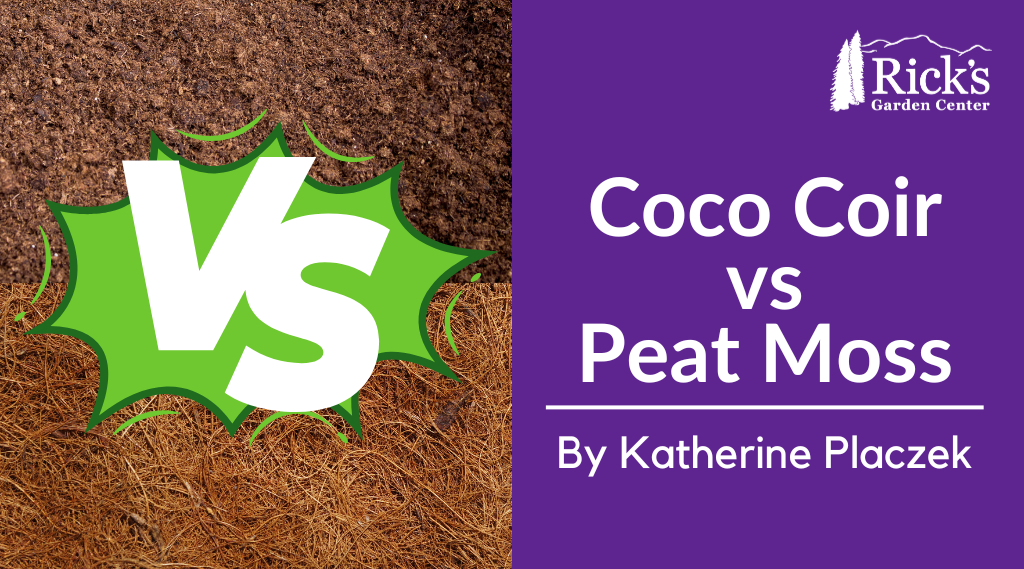
Protecting Our Watershed While Gardening & Landscaping
By Katherine Placzek
Every item that we use in our green spaces– fertilizers, pesticides, sprays, powders and granules, etc. all make their way into the water, after it rains or when we water our plants. This means a myriad of compounds, organic and synthetic, are making their way in our or someone’s drinking water. Yes, most of our drinking water is filtered, but this also impacts lakes, streams, aquifers, wells, and other sources of water that can be a habitat for other living organisms, big and small. While this may feel overwhelming initially, we have the power to make little meaningful changes in the way we manage our landscapes.
Lawn and Garden Fertilization
Three things make a difference here. Quantity, quality and timing:
Quantity: When you use fertilizer, always use the instructed amount of fertilizer or a diluted/ lesser amount. This ensures that your plants can take up the applied fertilizer and that excess is not making its way into our waterways. Excess fertilization can stress plants and negatively impact water quality. Over fertilizer use through agriculture, golf course maintenance, and community landscaping have contributed to dead zones in waterways. A dead zone is where all aquatic life ceases to exist. First, expansive algae blooms occur that crowd out sunlight, which choke oxygen out of the environment, causing inhabitable levels for any life, plant or animal. While some dead zones do occur naturally, the second largest one in the world is in the Gulf of Mexico, where many of North America’s waterways meet. This dead zone is widely attributed to human causes.
Quality: When choosing a fertilizer, it is advisable to read the ingredients, similar to reading food labels. If you cannot recognize an ingredient, know it is likely synthetic. Not all things that are human made are bad, but do your research. You may decide that you do not want some of these ingredients in your garage, home, yard, and local ecosystem. This is why Rick’s is proud to continue to carry our Organic Lawn and Garden fertilizers. Both of these are gentle fertilizers, with low nitrogen levels, and contain ingredients such as chicken manure, bone meal and blood meal.
Timing: Never fertilize before a severe rainstorm where run-off can take the majority of your fertilizer downstream. This is also cost prohibitive. If you plan on putting fertilizer down before predicted moisture, consider prior to a snowfall, where the melting snow can bring the fertilizer into the ground gently. Also read the instructions. Many fertilizers recommend a fertilizing schedule. Follow this, or see if you can stretch the schedule out further, to reduce the amount of fertilizer that you have to buy and apply throughout the year. Never fertilize more than what is recommended, this can stress the plant, and excess product will be absorbed into the waterways.
Pesticide Use
Pesticides include insecticides, herbicides, and fungicides. Similar to fertilizing, follow the same wisdom regarding quantity, quality and timing. We have said it before, but just to remind you: “While pesticides are convenient and sometimes necessary especially when mitigating invasive plant species, pesticides negatively impact pollinator numbers…. It is important to remember that while applying control products at night can reduce pesticide exposure to several pollinators/ beneficial species, this does not protect nocturnal pollinators such as moths and bats. When we use pesticides there is no current method that does not negatively affect pollinators or their second tier predators, who are further up the food chain (Excerpt from our March 2024 newsletter).” All of these pesticides reach water sources that are drinking water for pollinators and larger organisms: birds, fish, fox, deer, etc. Many of the chemicals used in popular pesticides, including glyphosate do not break down with water. This means the problem is washed downstream, but never away, and can exist in our waterways indefinitely. Manual removal of weeds is no fun- we all know this. When we choose conventional pesticides, we give up clean water. Limiting the amount of pesticides we use in our yards is one step to keeping our watershed less polluted.
General Maintenance
When you mow your lawn, consider mulching the cut grass instead of bagging it unless you use the cut grass in your compost. Mulched grass that has been chopped by the mower multiple times and is spread evenly over the lawn acts as a wonderful additive of organic material to the soil. This method improves water retention, and overall soil health, decreasing your need for fertilizer. If you mulch the cut grass, but leave large clumps of thatch, this can burn your grass and be swept away into a waterway. This process can act similarly to over fertilization, causing algae blooms downstream. Use the same logic with fall leaves. Mulch leaf litter and either use it on your lawn or in your garden, to add nutrition to the soil. Avoid abandoning leaves in gutters, and storm drains, as it increases excess nitrogen in the watershed. In the winter, make sure you are using a low saline and non-toxic ice melt as well. Water guardianship takes place in all four seasons!
Plant Selection
Finally, the fun stuff! Select plants and grasses for your landscape that are resilient to the Rocky Mountain circumstances. When we do this, we automatically reduce the need for mowing, fertilizing and the use of pesticides. Native plants especially, have been living here in the Colorado landscape much longer than any human lifespan. They have been taking care of themselves without any of our human care measures, such as fertilization, and will continue to do so into the future. I believe that by choosing to plant native plants in a landscape, you are actually simplifying your overall workload in the yard. You will fertilize less, you will use pesticides less, and regarding grass, you will mow less. That means more money in your pocket and more sitting on the back porch, sipping on a cold beverage. Cheers!
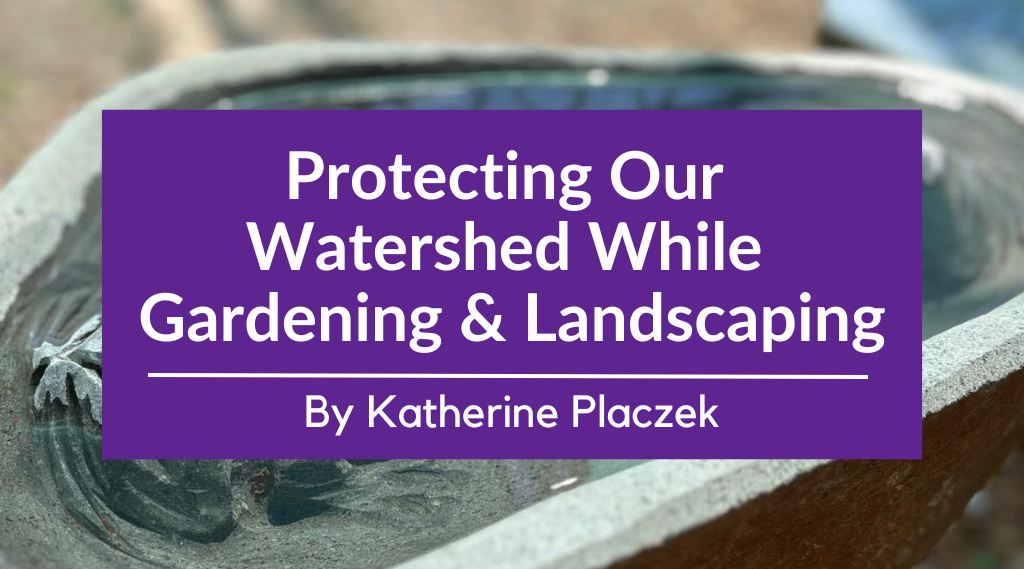
ECO-BRAN BRAN FOR GRASSHOPPERS DIRECTIONS
DIRECTIONS PULLED FROM PEACOCK INDUSTRIES BOOKLET ON ECO-BRAN
WE CLAIM NO OWNERSHIP OF GUIDE
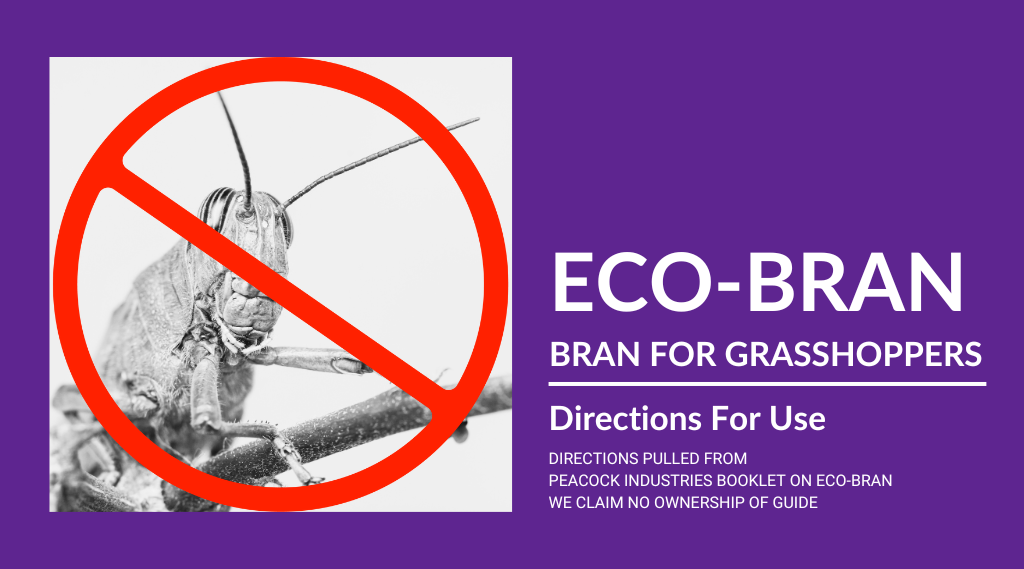
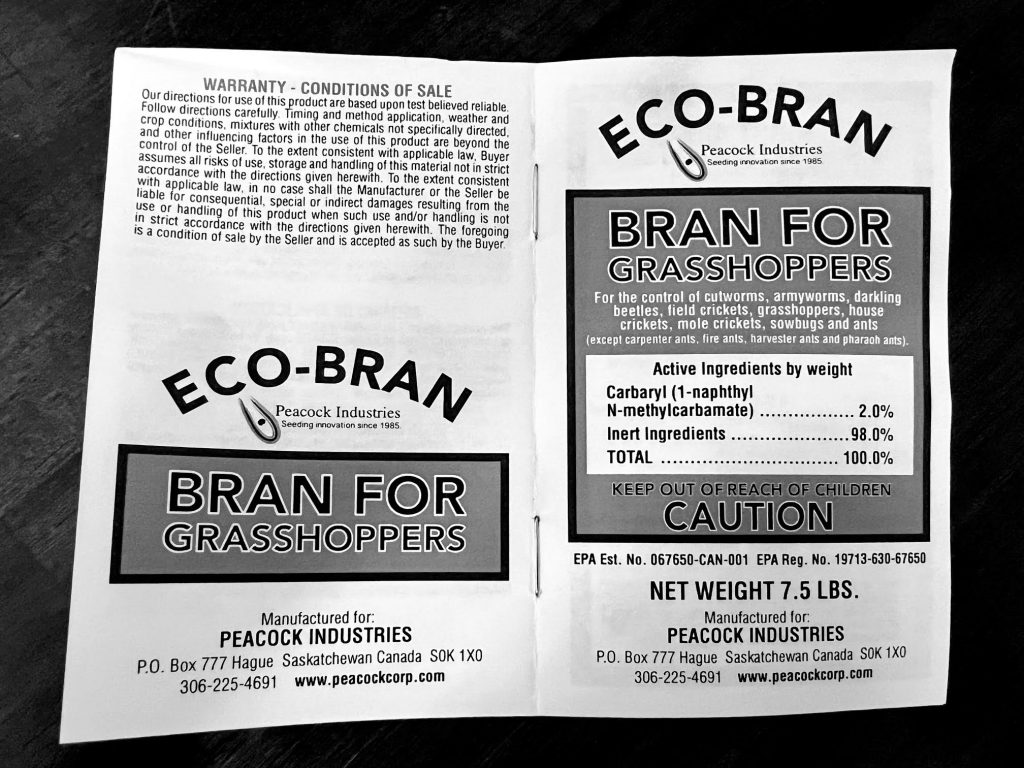


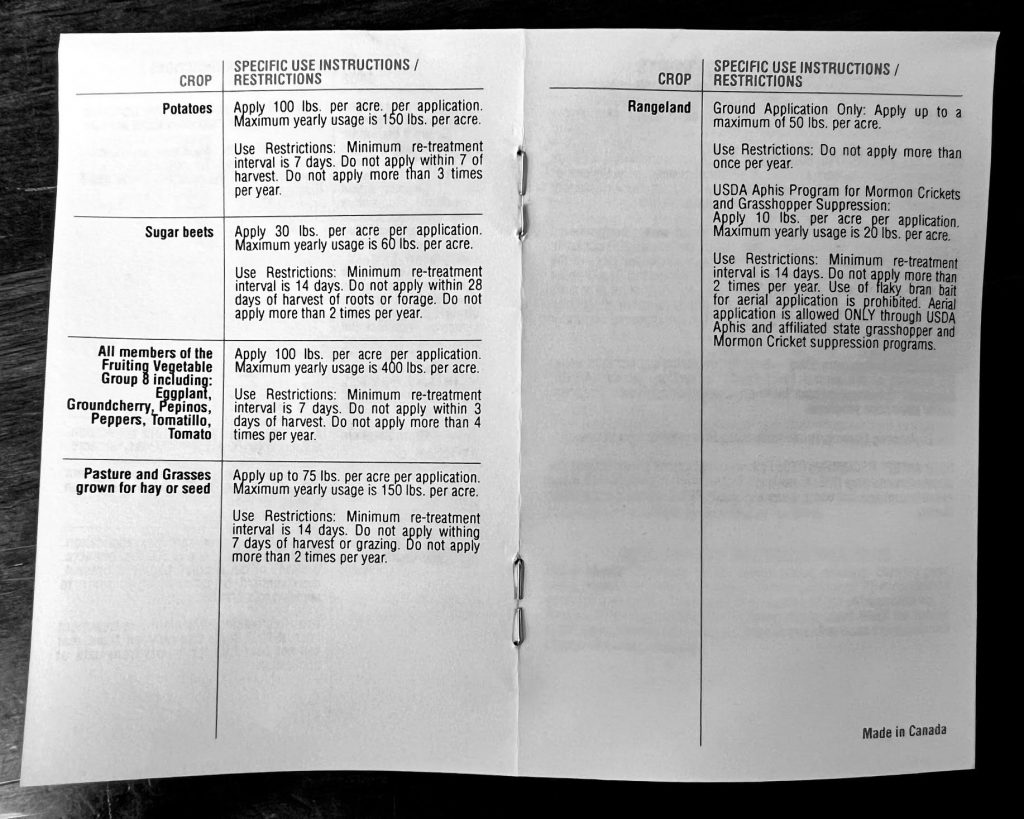

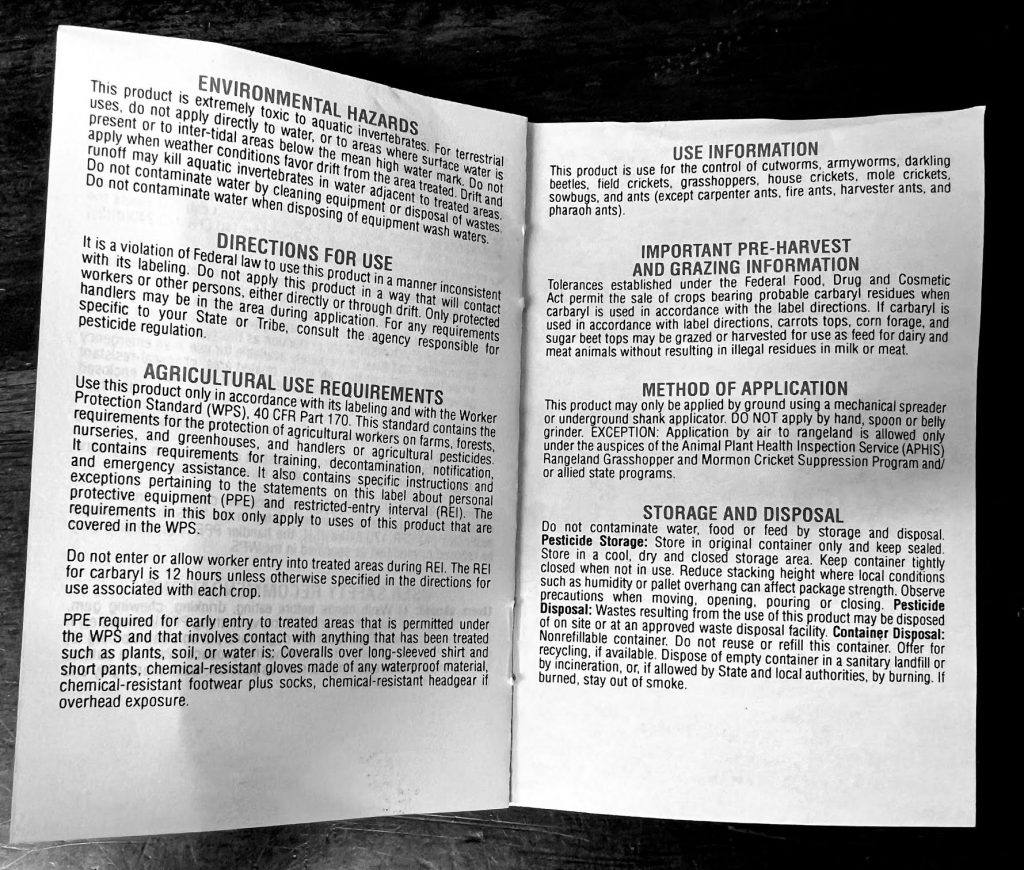

Blossoms on Your Plate
Are you ready to elevate your gardening game to a whole new level of deliciousness? Well, we’re about to dive into the vibrant world of edible flowers that will not only make your garden pop but also your plate! Many of them are easy to grow, forgiving of rookie mistakes, and will reward you with an explosion of colors and flavors.
Nasturtiums (Tropaeolum majus): These deep burgundy to buttery yellow blooms have a peppery kick, perfect as a spicy twist to salads, tacos, and avocado toasts. Bonus: They’re easy to grow, thriving in poor soil and other neglect. These flowers are high in vitamin C. The entire plant is edible- so try out the lily pad-like leaves also! Deer resistant.
Calendula (Calendula officinalis): Often called “poor man’s saffron,” the golden petals of calendula add a subtle saffron flavor to rice dishes and soups. They’re sun lovers and can tough it out in the Rocky Mountain soil. This flower is also known for its skin-healing properties, consider making a toner with calendula flowers. Deer are typically not a fan of these flowers.
Pansies (Viola tricolor): These adorable flowers come in an array of colors and have a slightly sweet, grassy taste. Scatter them over desserts after dipping them in water and then sugar for a delicate but sweet touch. Or freeze them in ice cubes for fancy drinks. Pansies are cold-hardy and can withstand our unpredictable mountain weather. We had a pot of pansies survive the entire winter, even when temperatures dipped below 20 degrees!
Lavender (Lavandula angustifolia): Known for its calming aroma, lavender adds a delicate floral flavor to desserts, teas, and even cocktails. It thrives in well-drained soil, making it a great match for rocky gardens. We have several varieties that will survive year-round in our nursery area. Look for varieties such as Munstead, Hidot Blue, and Phenomenal. Due to the fragrance of these flowers, deer typically leave them alone.
Rose (Rosa spp.): Beyond being a symbol of romance, roses can be used in various culinary creations. Make tea with their dried petals, infuse honey with their fragrance, or toss the petals into desserts. The rose hips that are produced in the fall are also edible and high in vitamin C. You can make tea from the rosehips as well. We have several varieties of roses, some more bred for their blooms, others are cultivated to be hardy for our mountainous climate.
Borage (Borago officinalis): With its brilliant blue flowers, borage adds a refreshing cucumber taste to salads, drinks, and desserts. The best part? Borage is a self-seeding annual, making it a low-maintenance addition to your garden. The pollinators will also feast on these blooms! Deer typically avoid this plant.
Chamomile (Matricaria chamomilla): Beyond being a bedtime tea, chamomile flowers can be used in salads or infused into syrups that go well in cocktails, over ice cream, or on pancakes. These sun-loving plants will thrive in our bright sun. Deer tend to avoid this plant due to its fragrance.
Dianthus (Dianthus spp.): Also known as pinks, or sometimes recognized as carnations, these flowers have a mild clove-like flavor. Add them to fruit salads, and desserts, or dry them and add them to various spice blends (za’atar, is a great example). Dianthus are hardy perennials, returning year after year. They are also deer-resistant.
Hibiscus (Hibiscus rosa-sinensis): Hibiscus flowers make a delightful and tropical addition to beverages, jams, and desserts. We carry gorgeous hardy hibiscus that will winter as a perennial shrub. Hibiscus also has high levels of vitamin C and is an excellent herb for overall health.
Daylilies (Hemerocallis spp.): Despite their fleeting beauty, daylilies are edible and offer a slightly sweet flavor. Stuff the blossoms with a soft cheese, or add them to stir-fries. Do your research on whether you have a daylily, before digging into a meal. Not all species of lilies are edible. These hardy perennials are a reliable choice in our climate.
Elderflower (Sambucus nigra): Fragrant elderflowers can be used to make refreshing beverages like elderflower cordial or add a subtle floral note to desserts. Elderflowers come from elderberry bushes, so you will also be able to eat elderberries if the birds don’t beat you to it! These shrubs are well-suited for the mountain environment, making them a great choice for your garden.
So, whether you’re a seasoned horticulturist or a budding green thumb, dive into the world of edible flowers and turn your garden into a culinary masterpiece. After all, why just stop and smell the roses when you can toss them in a dish too? Happy gardening and bon appétit!
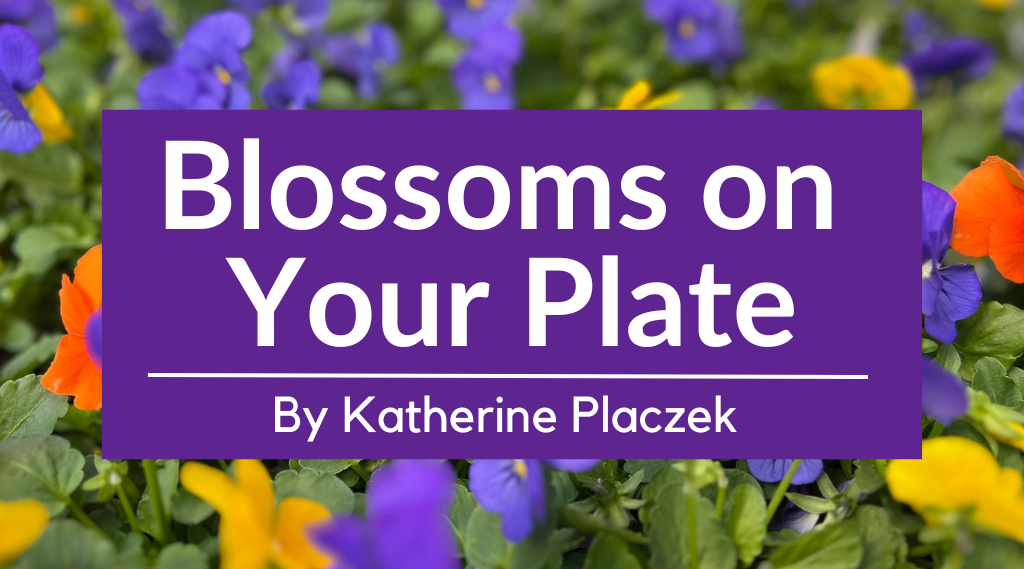
Embracing Nature’s Way: Integrated Pest Management
Integrated Pest Management is like the Gandalf of gardening – a wise, all-encompassing strategy that balances the forces of nature to keep your greenery flourishing. At its core, IPM is a holistic approach that combines biological, cultural, and physical/ mechanical control methods to manage pests and diseases. Instead of reaching for a pesticide or other control products, we tap into the power of Mother Nature herself to maintain a thriving and balanced ecosystem.
Some of our IPM practices include:
- Biological: Releasing ladybugs or other beneficial insects inside our greenhouses, or hoop houses to feast on those insects that are a bother; aphids, scale, mealy bugs, leafhoppers, etc. We also let spiders do their good work eating larger insects, like grasshoppers.
- Cultural: Reducing watering if fungal or pest problems crop up.
- Mechanical: Manually removing bugs from plants by hand or with water (aphids, mealy bugs, scale, potato bugs, etc)
While we lean into biological, cultural, or mechanical solutions, the last part of IPM is responsibly utilizing chemical products to rid of pests. This means we use more natural controls, such as Neem oil or Spinosad Soap, before other products. It is also important for us to factor in when pollinators or other beneficial insects may be around. So we try to spray when these individuals are not active. We also follow recommended application methods to avoid pollution of our environment or incur undue costs.
Why does Rick’s Garden Center Choose IPM Over Pesticides?
Environmental Harmony:
- Pesticides can disrupt your garden’s delicate ecosystem – effective, but with unintended consequences. IPM, on the other hand, dances with nature rather than against it. By embracing natural predators, beneficial insects, and environmentally friendly practices, we create a harmonious balance that keeps the pests at bay without harming the environment. By mostly avoiding synthetic chemicals, we reduce the environmental impact and create a garden that’s both beautiful and a haven for beneficial insects and wildlife.
Economic Sense:
- Let’s face it – pesticides can burn a hole in our pockets. IPM, however, is cost-effective in the long run. By relying on natural solutions, we reduce the need for constant reapplication of expensive chemicals, improving our bottom line.
Happy and Healthy Plants:
- Picture this: a garden where plants are not only surviving but thriving. That’s the magic of IPM. By addressing the root causes of pest problems and fostering a healthy soil environment, we ensure that your green companions are resilient and ready to face whatever life throws their way.
Community Connection:
- We believe in building a community that shares our love for the earth. By choosing IPM, we invite our customers to join us in creating a garden that is a testament to the power of working hand in hand with nature.
At Rick’s Garden Center, IPM isn’t just a gardening strategy – it’s a philosophy. It is about embracing the rhythms of nature and inviting others to join us toward a more sustainable future. So, next time you visit, know that you are not just buying plants; you are becoming a part of our eco-minded family.
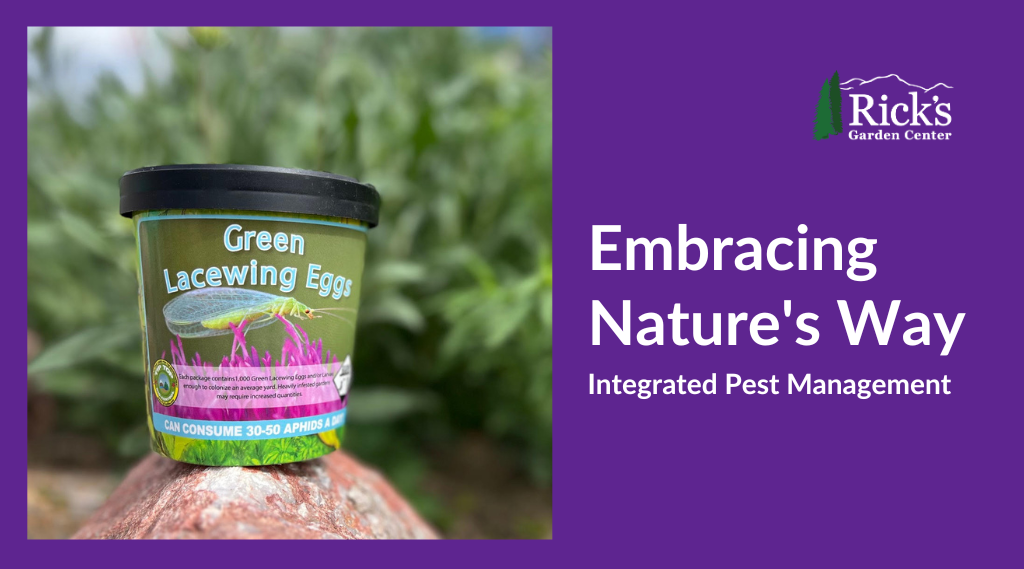
2024 Pepper Book
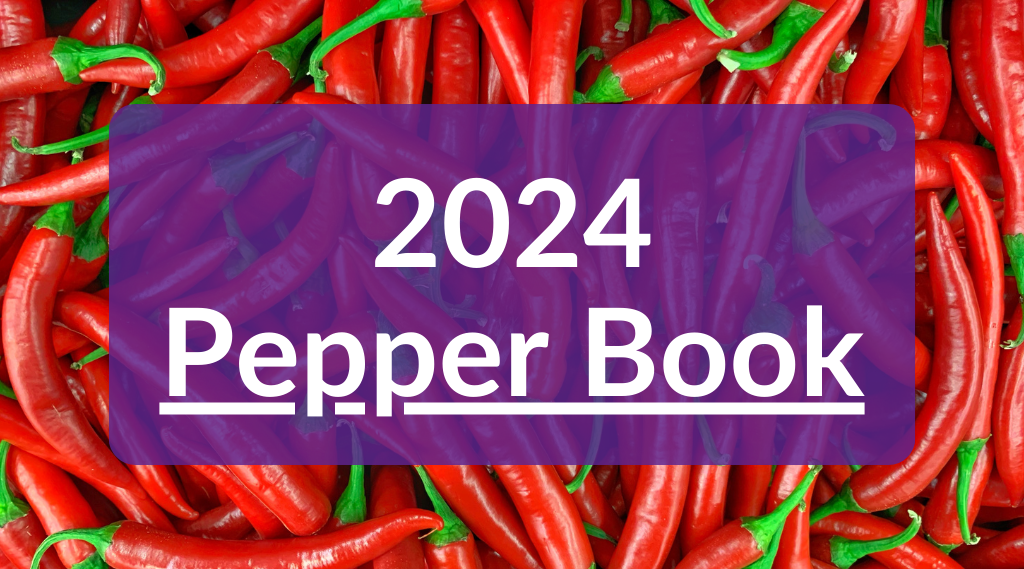
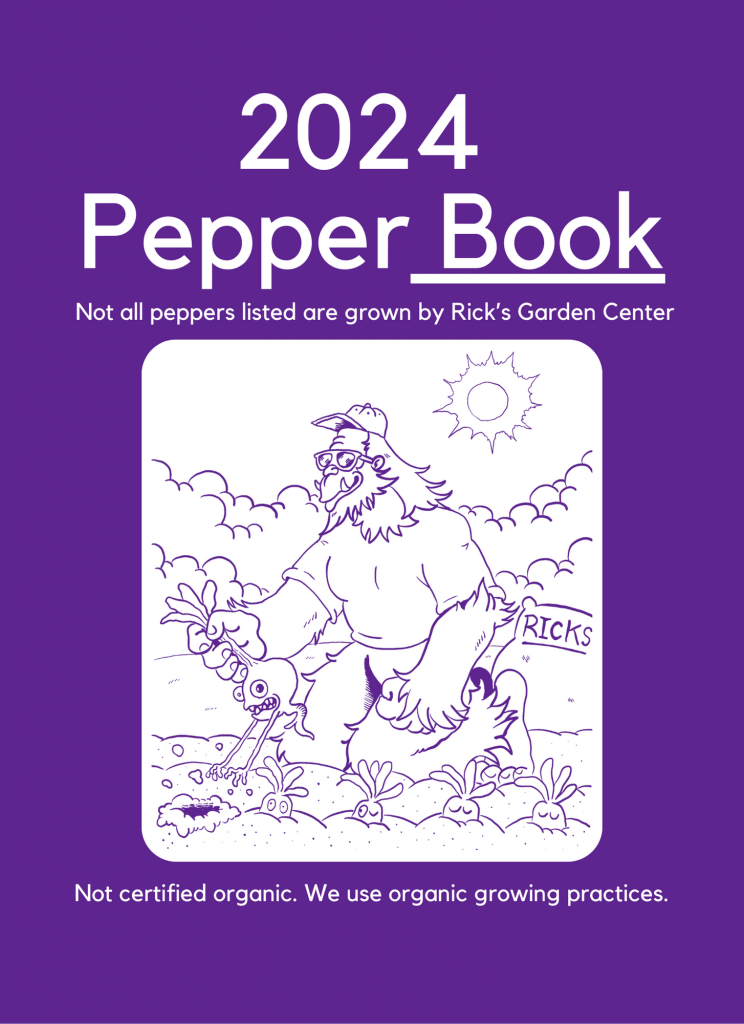
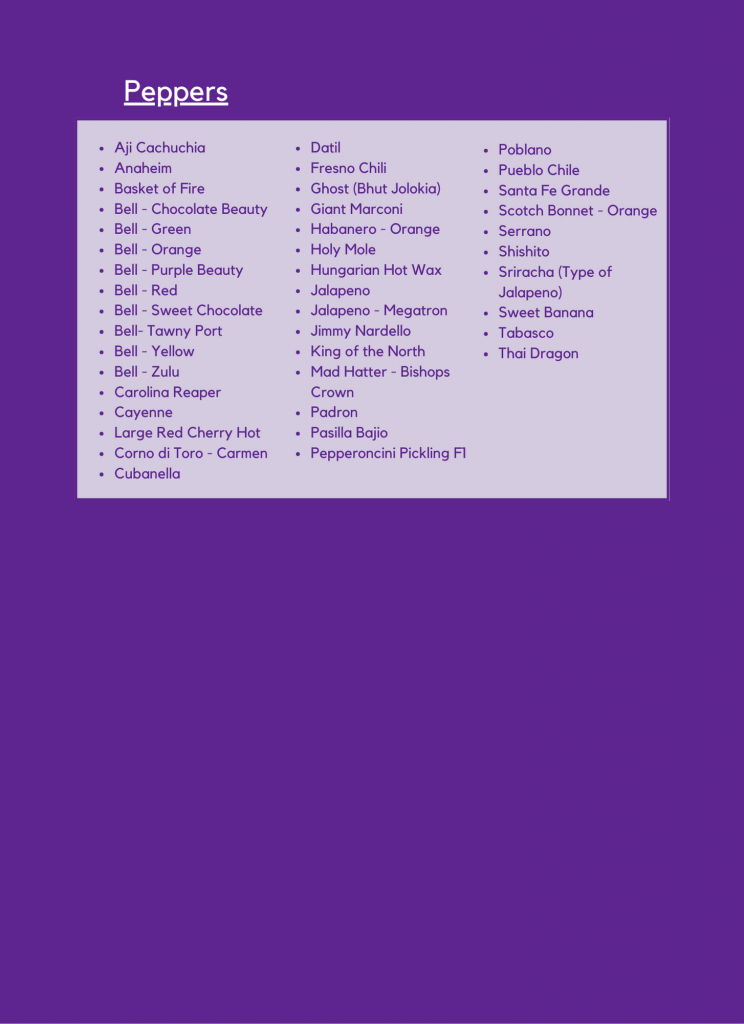
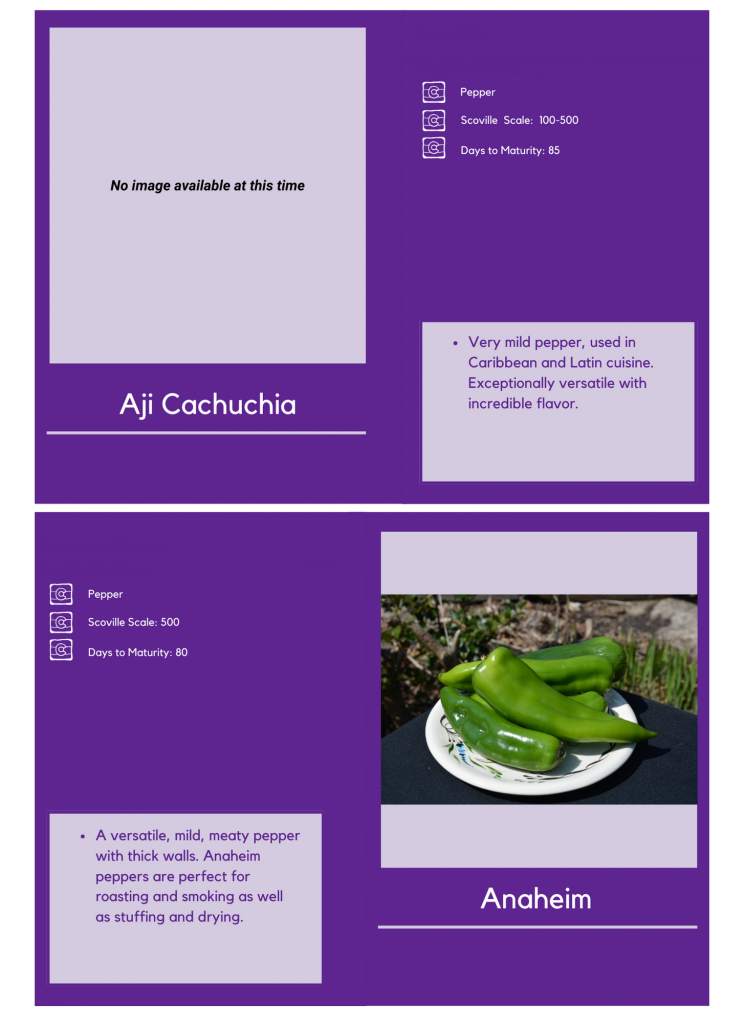
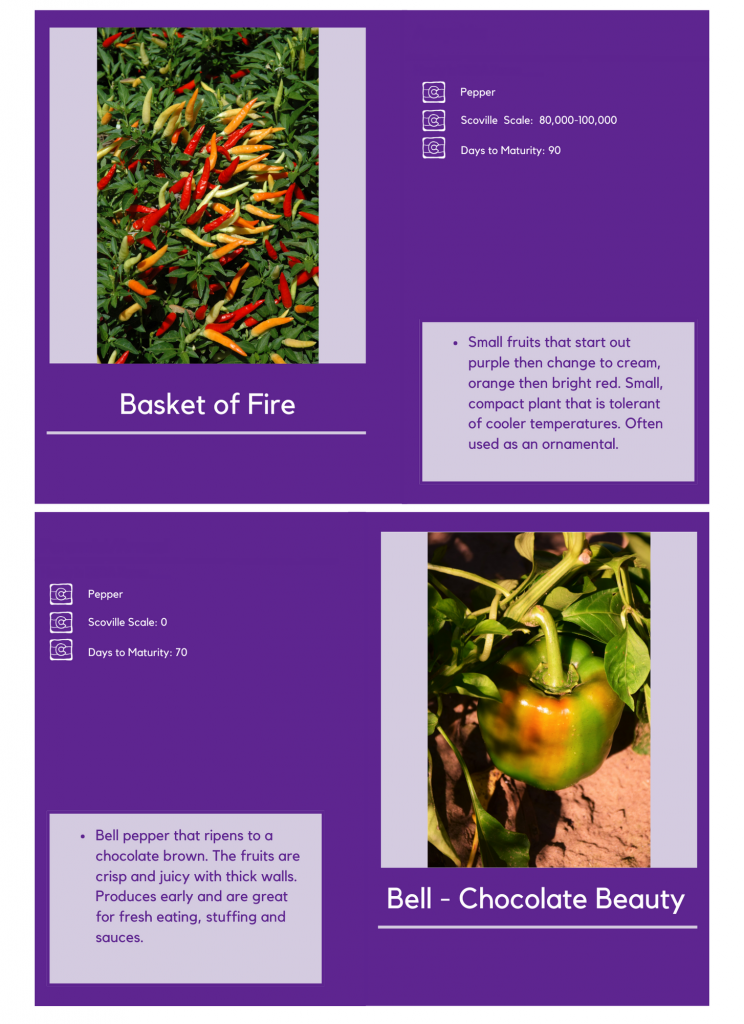
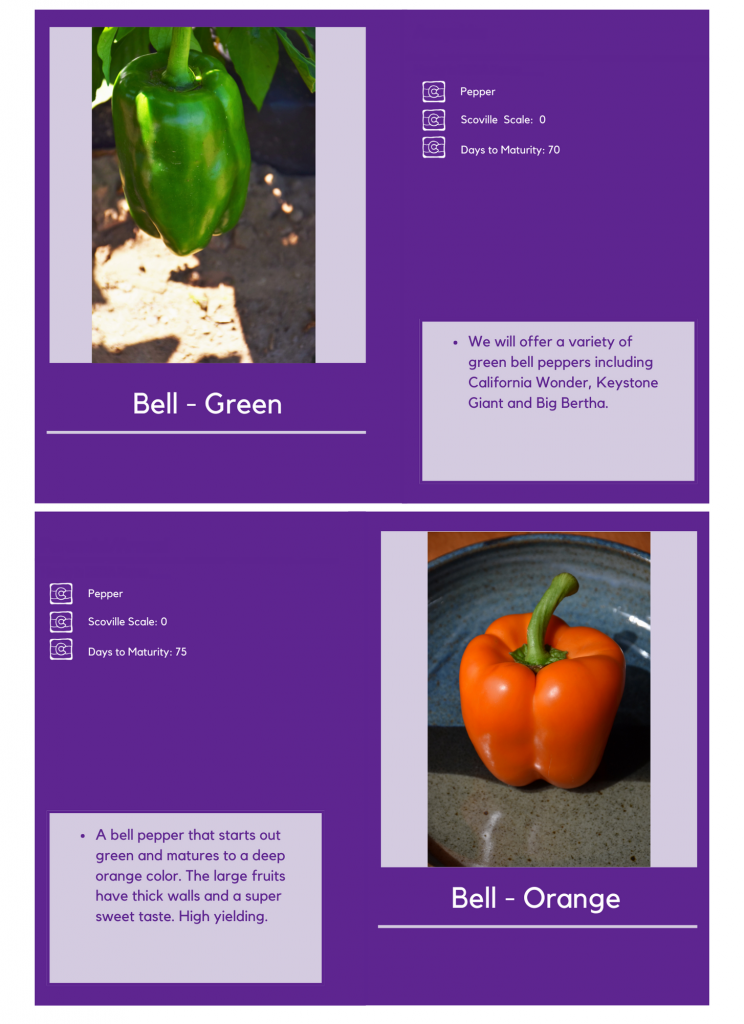
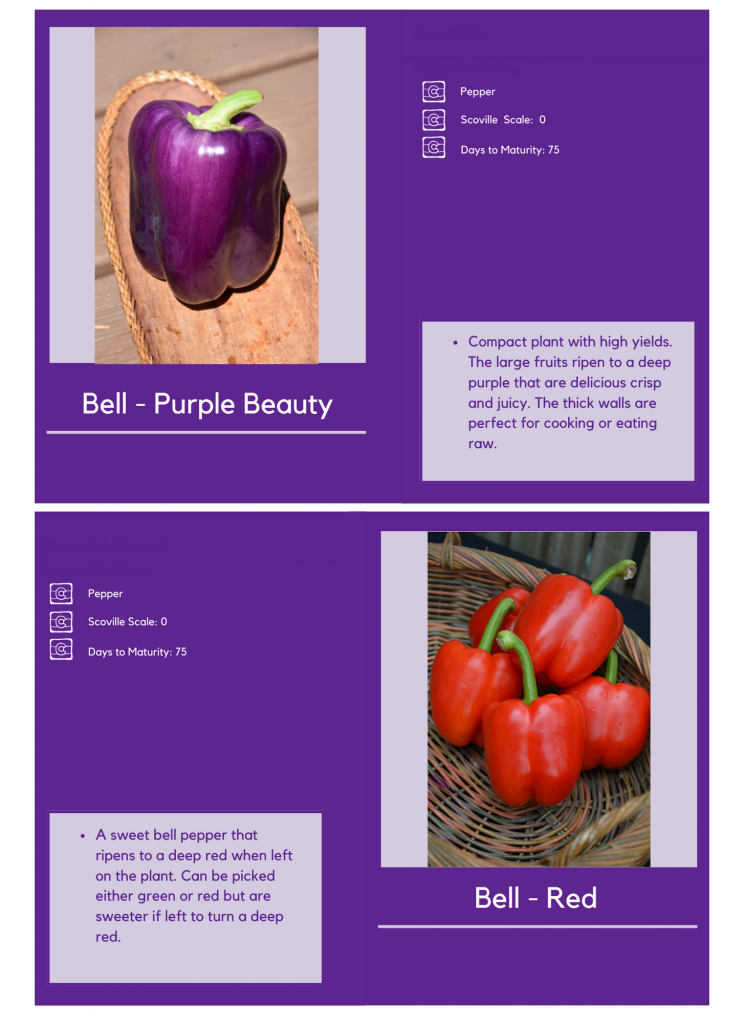
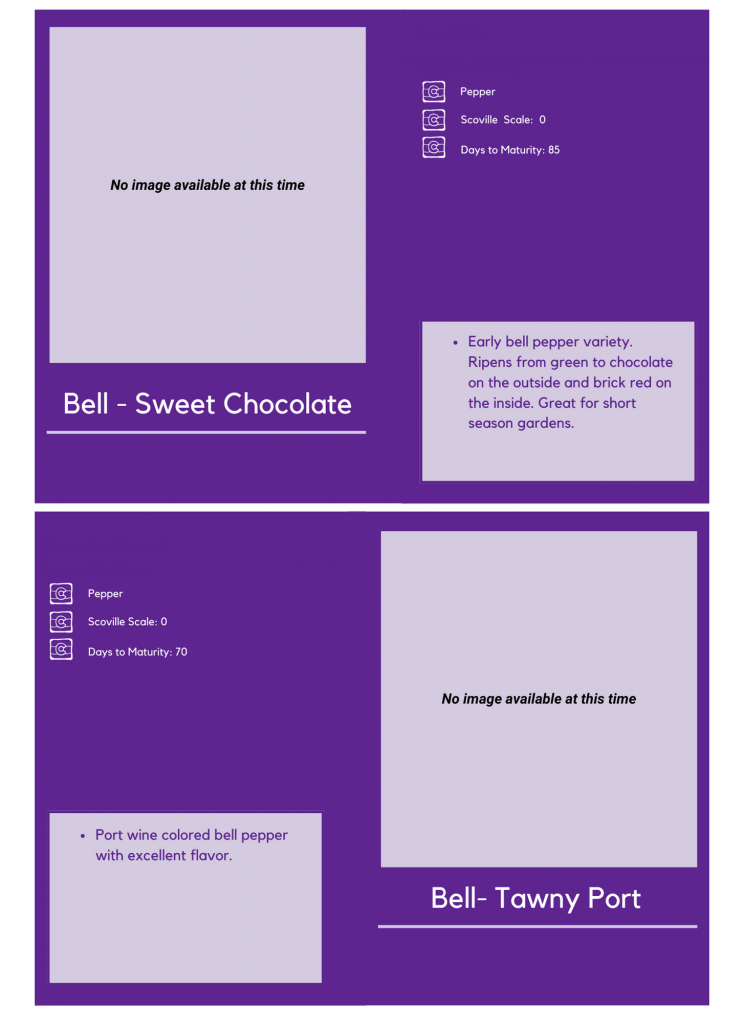
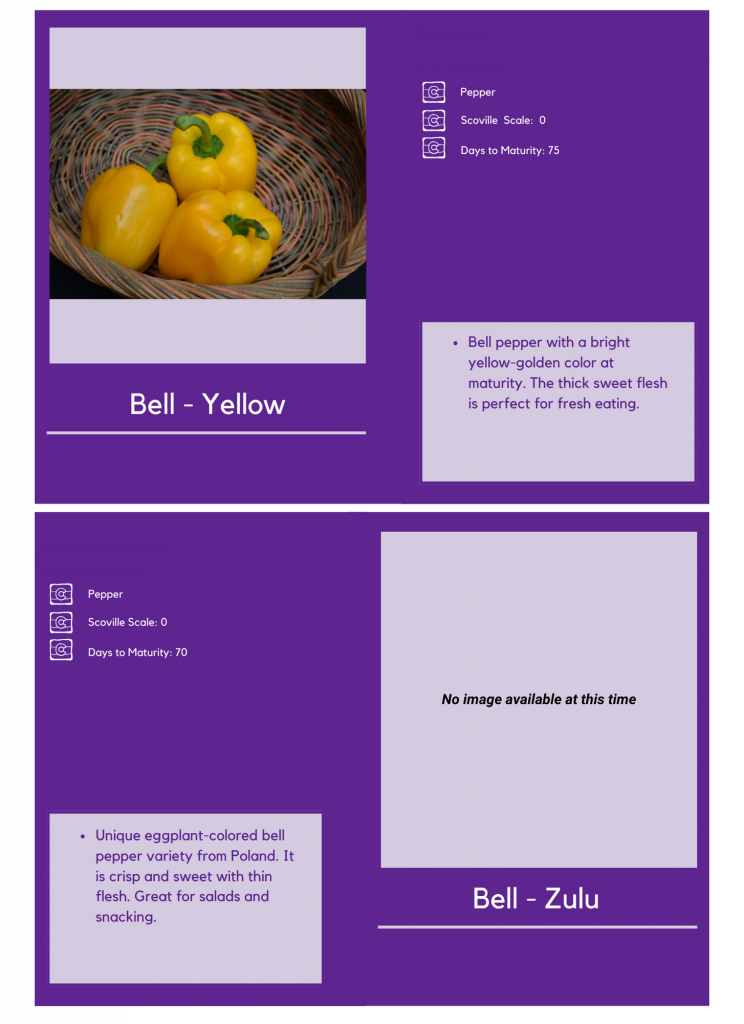
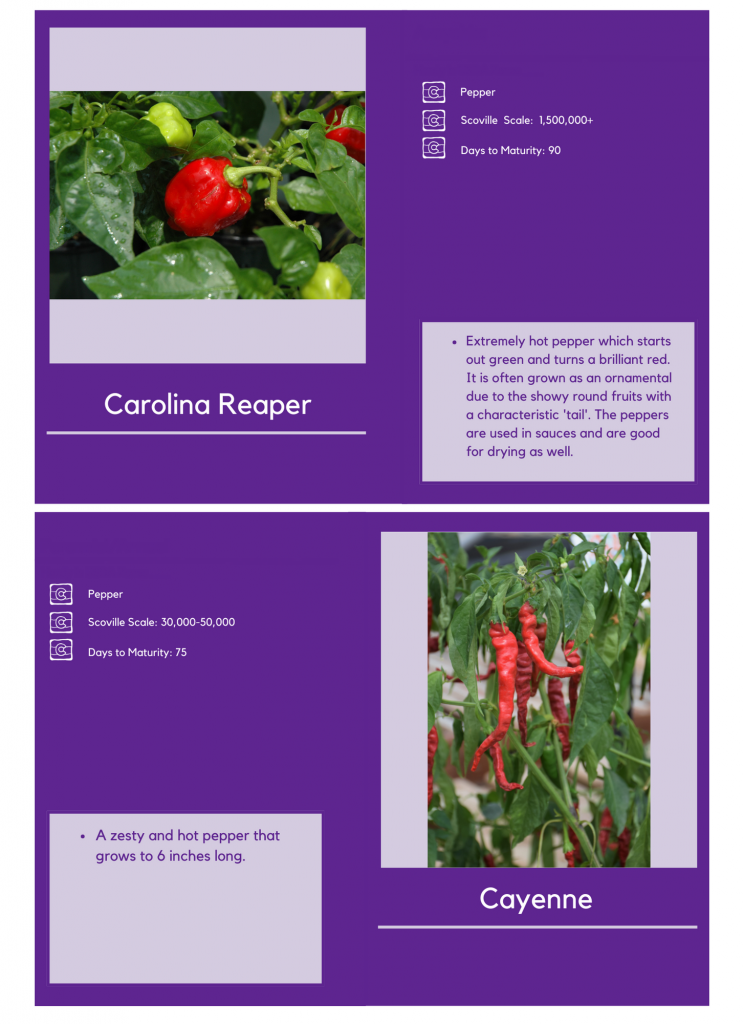
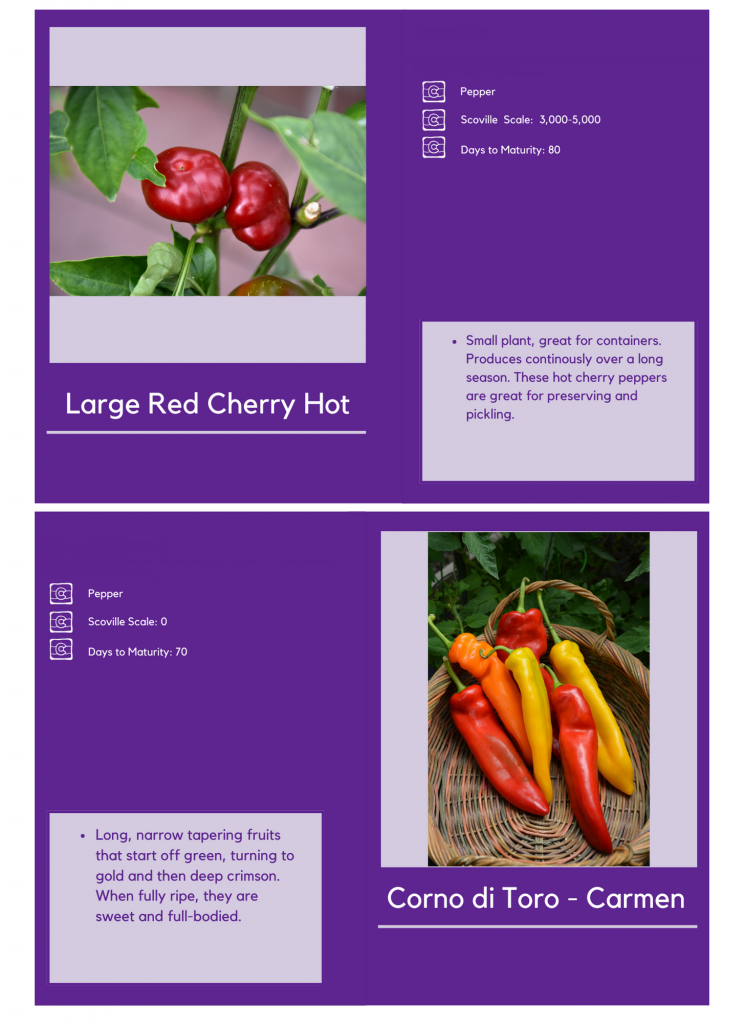
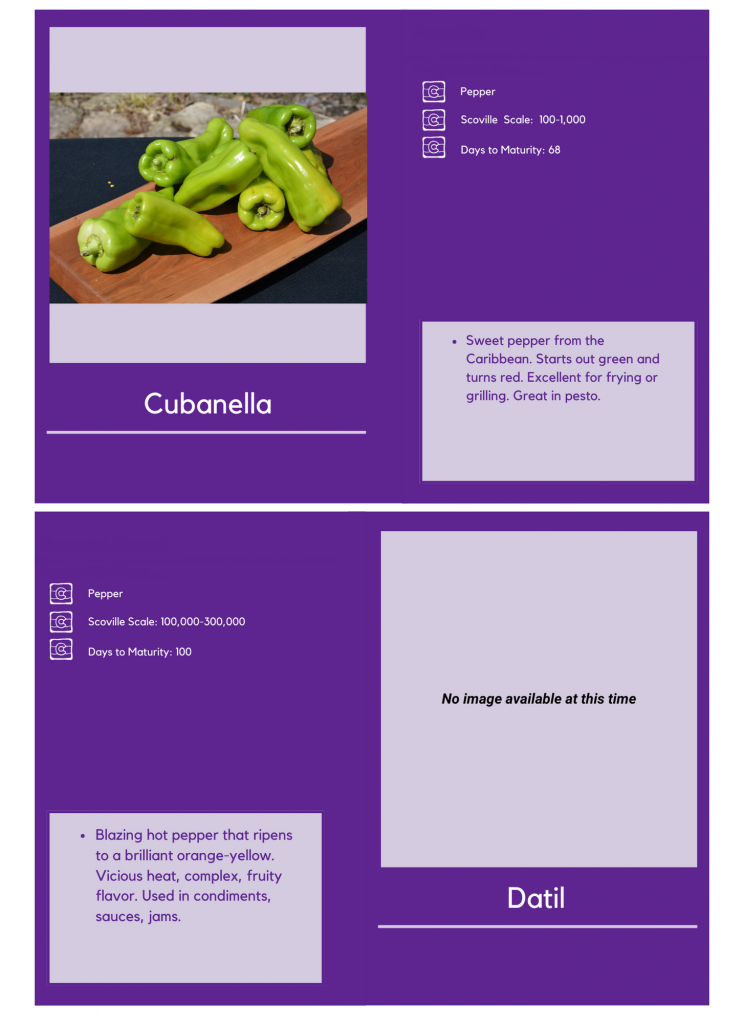
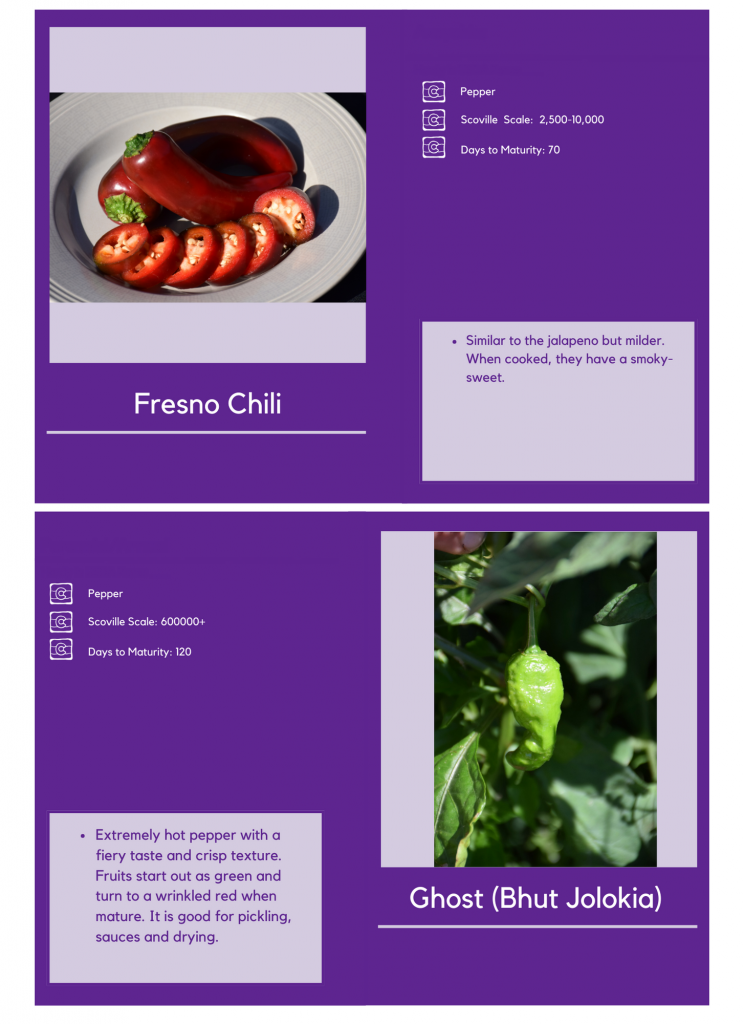
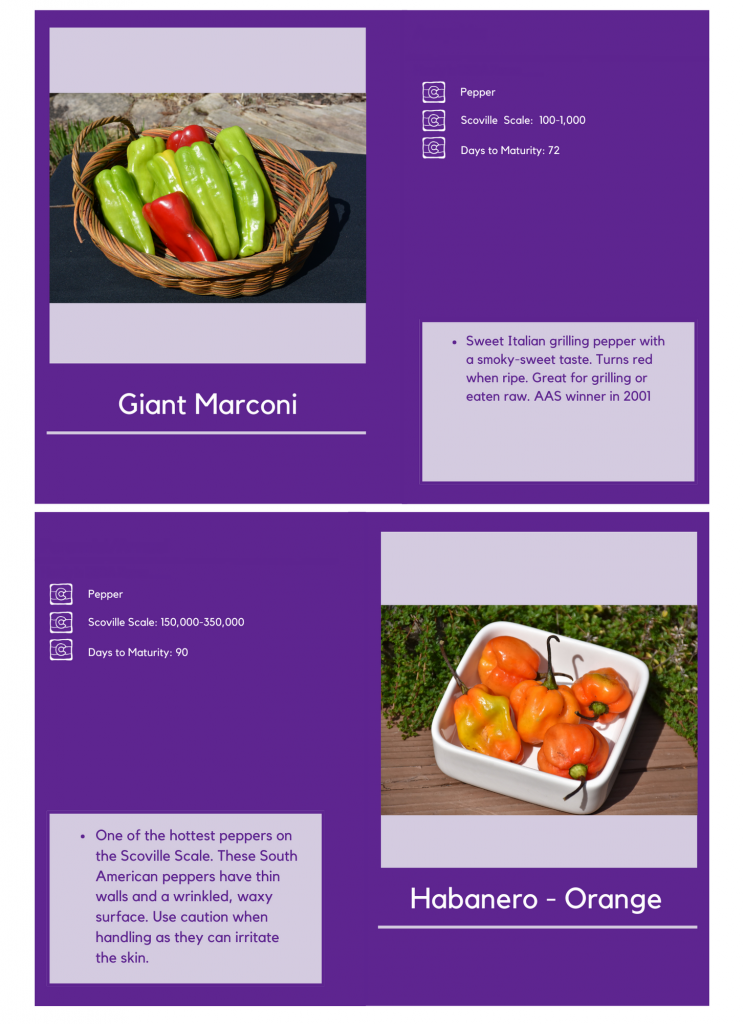
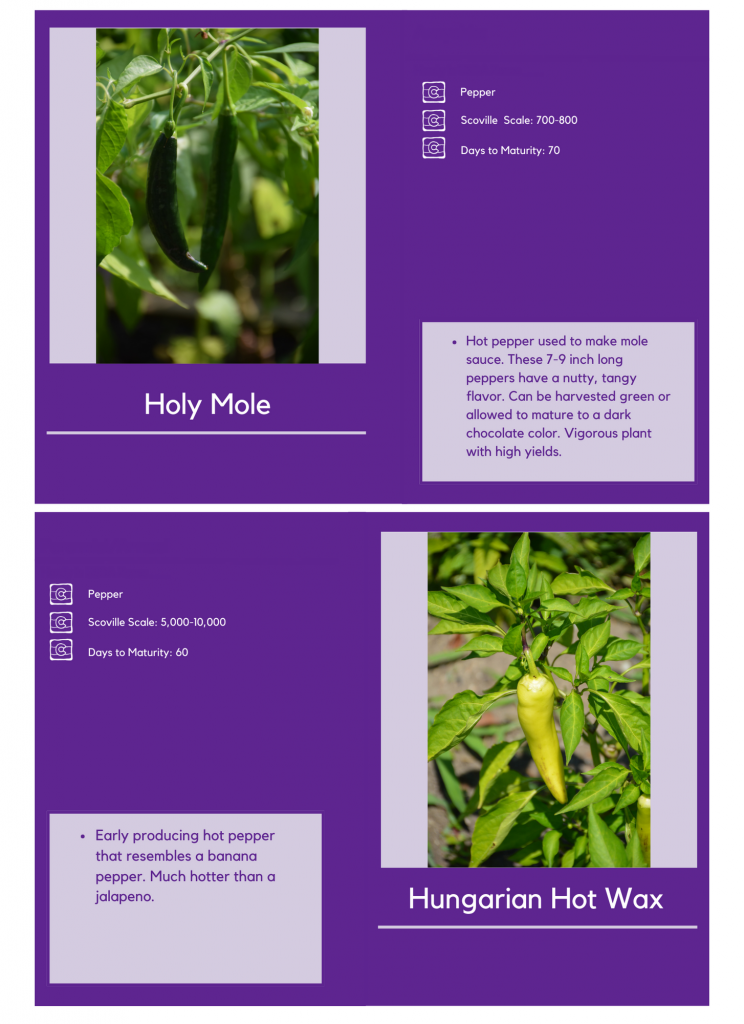
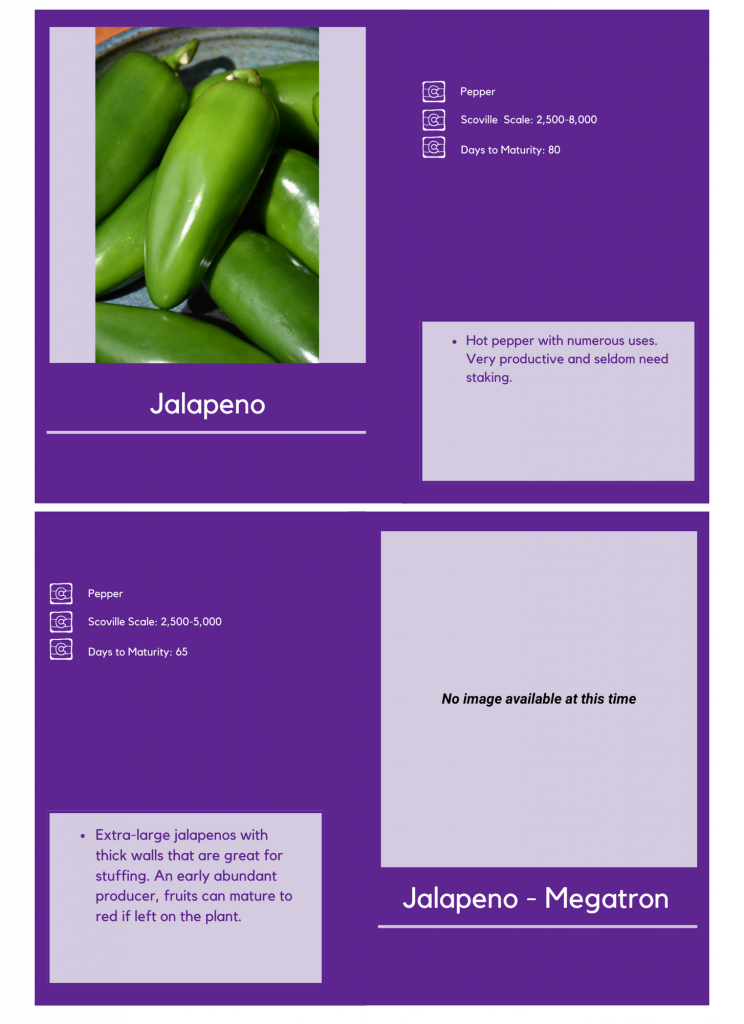
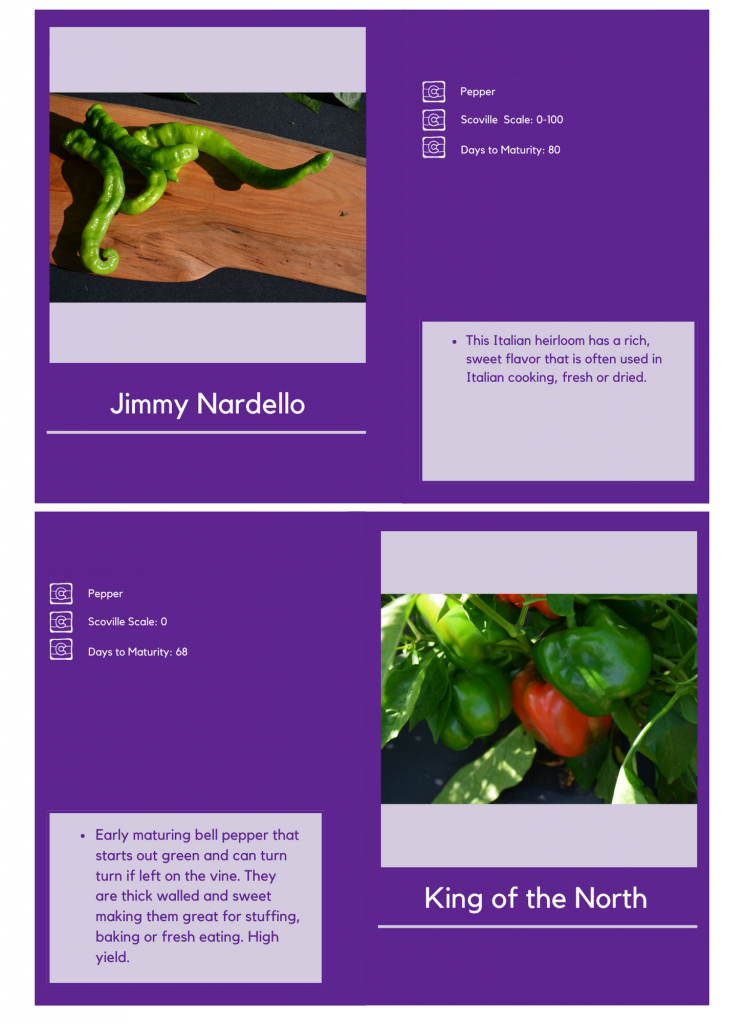
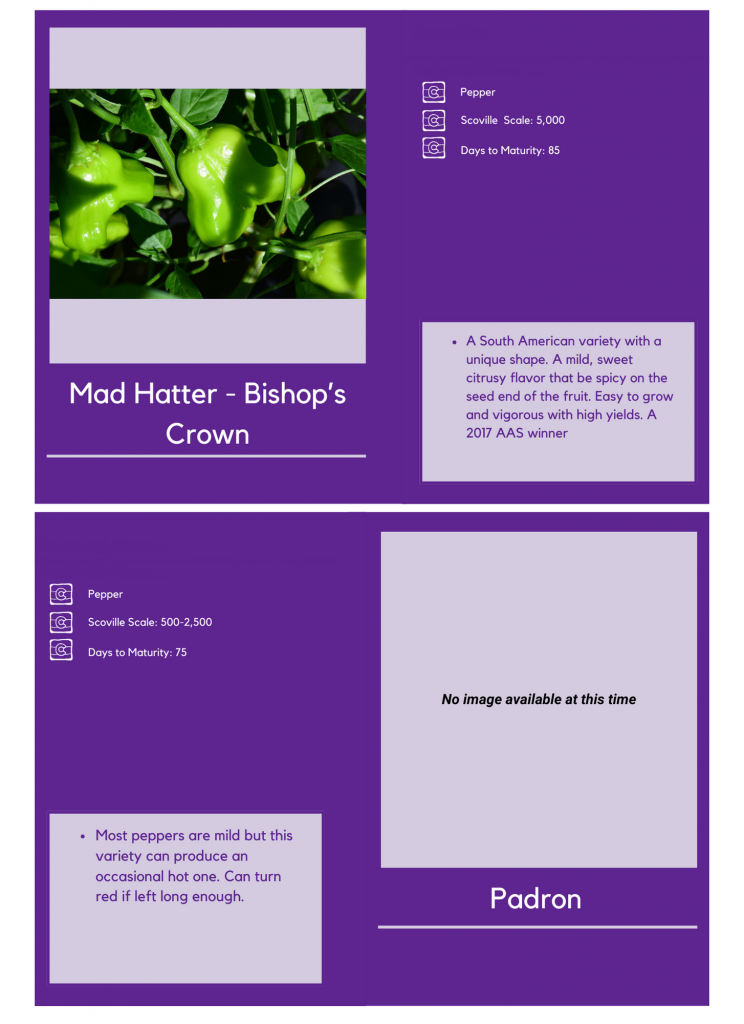
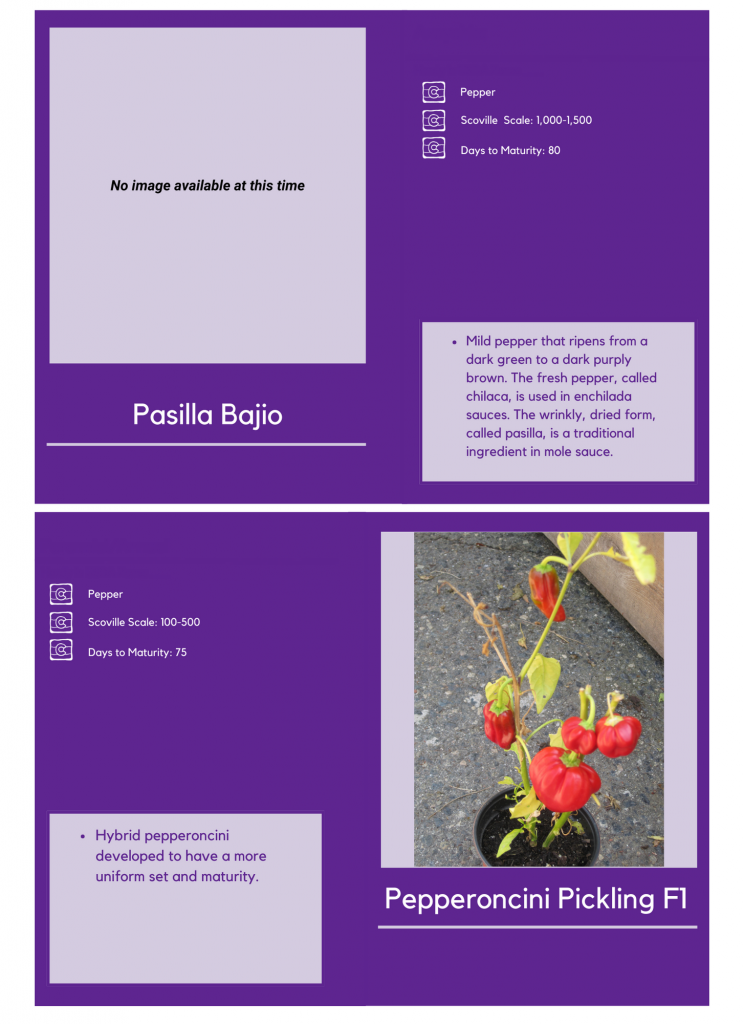
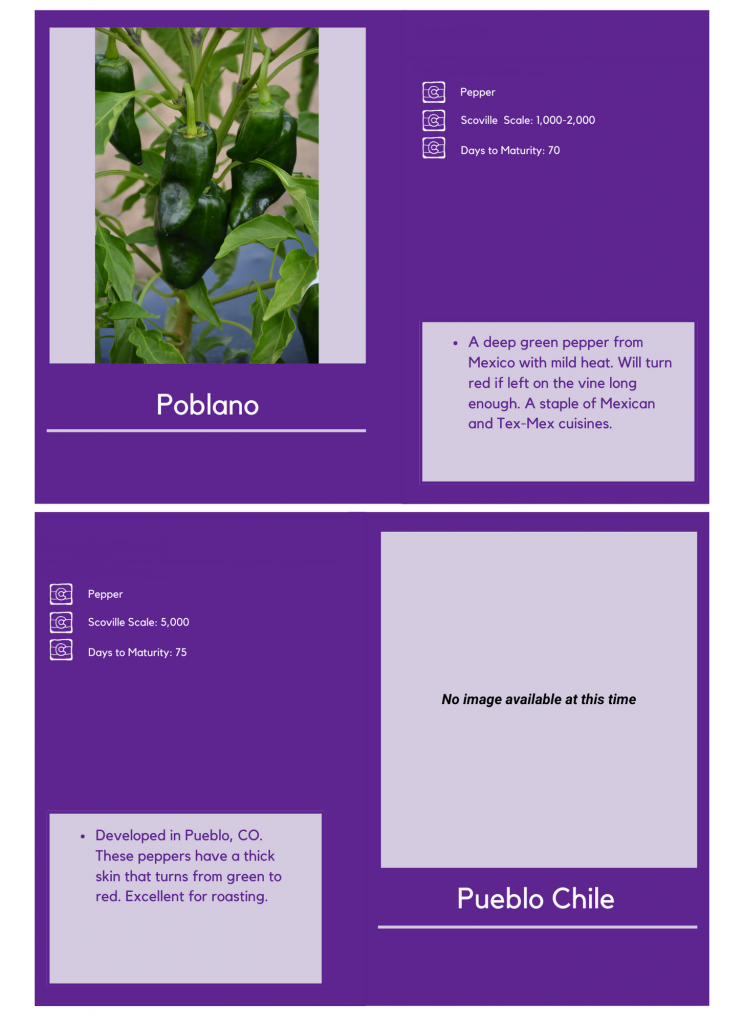
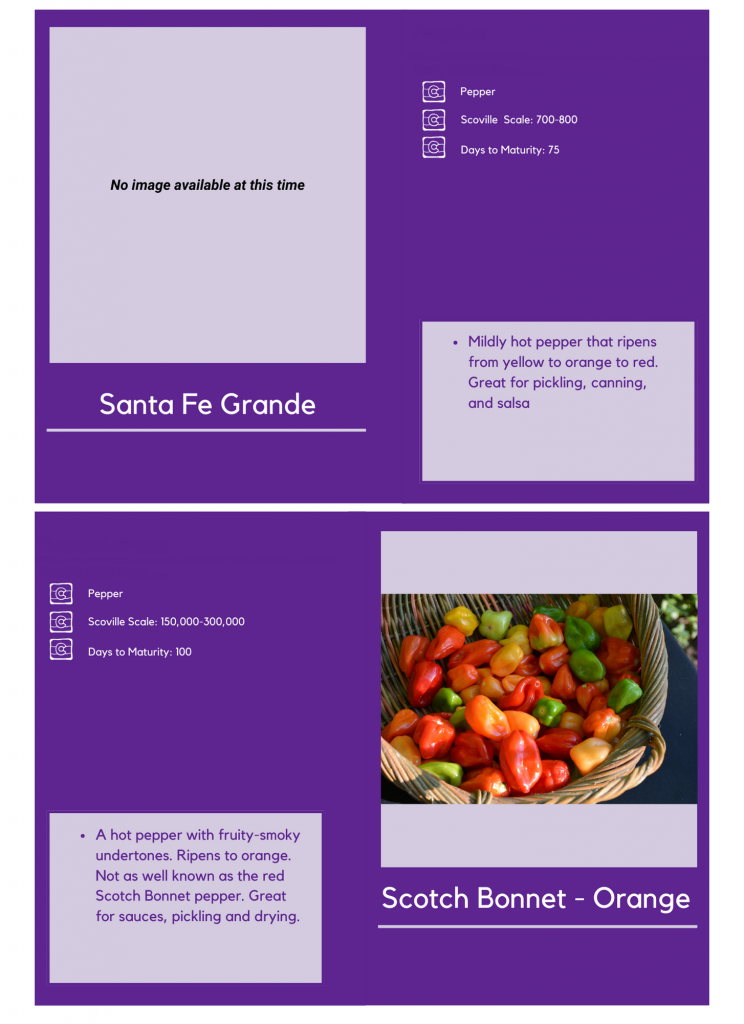
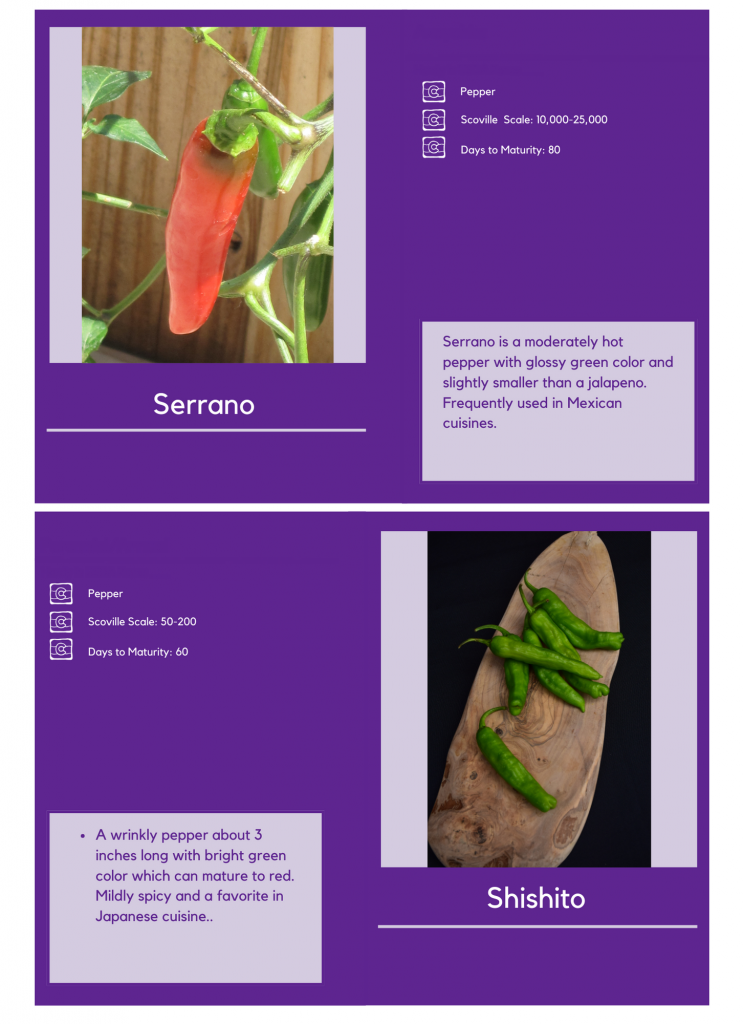
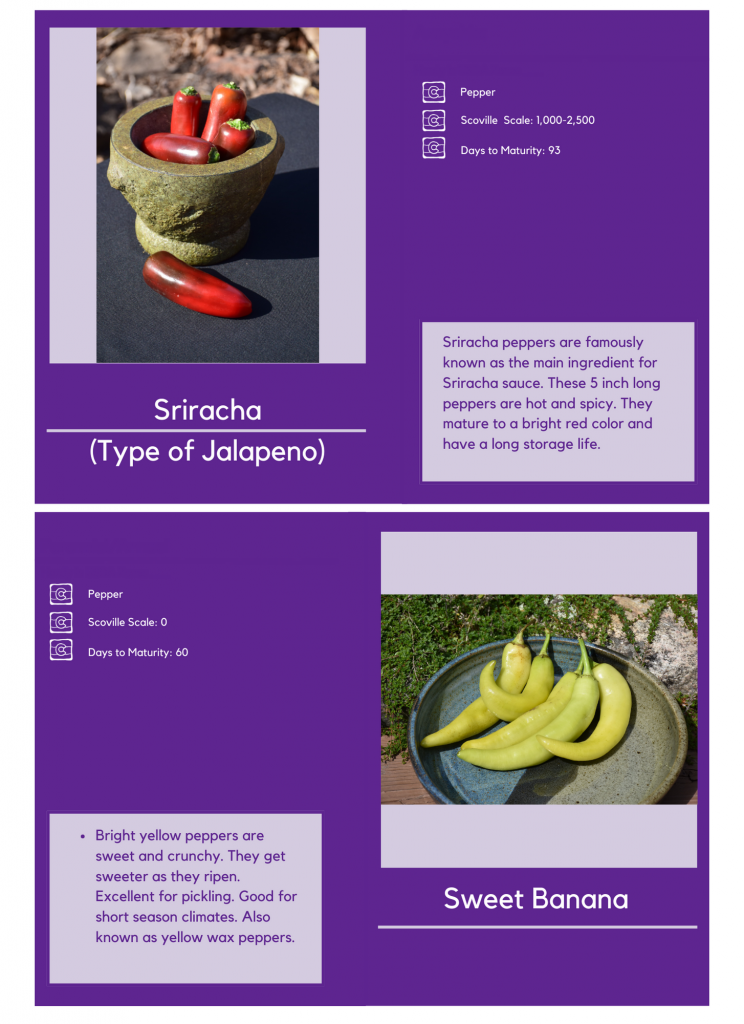
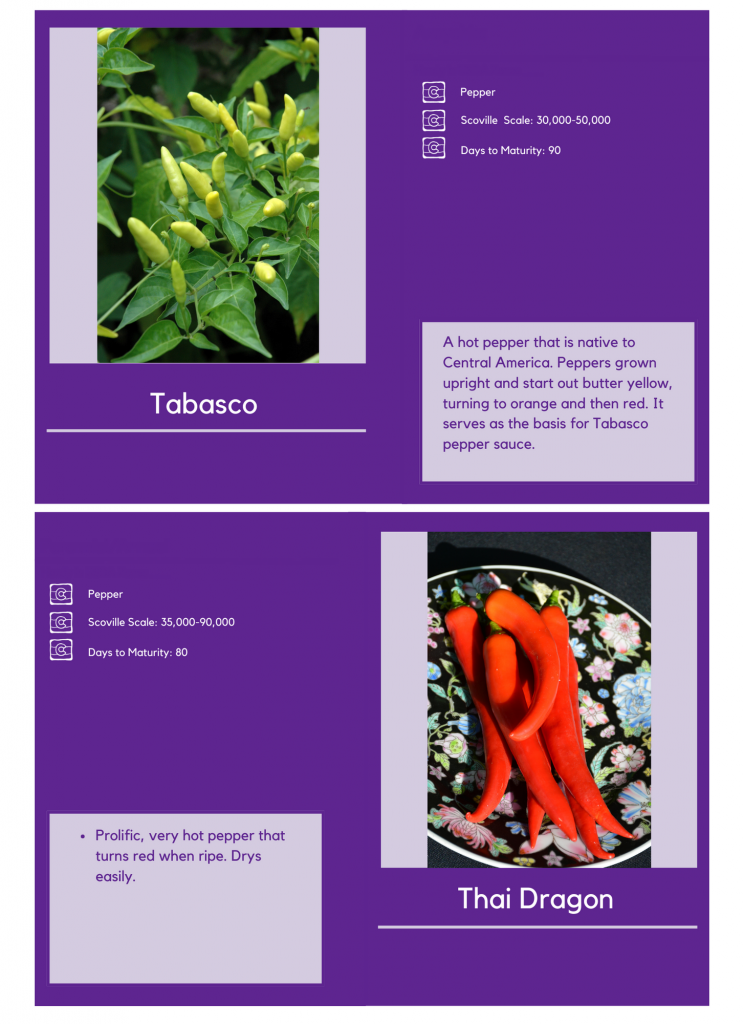

2024 Tomato Book
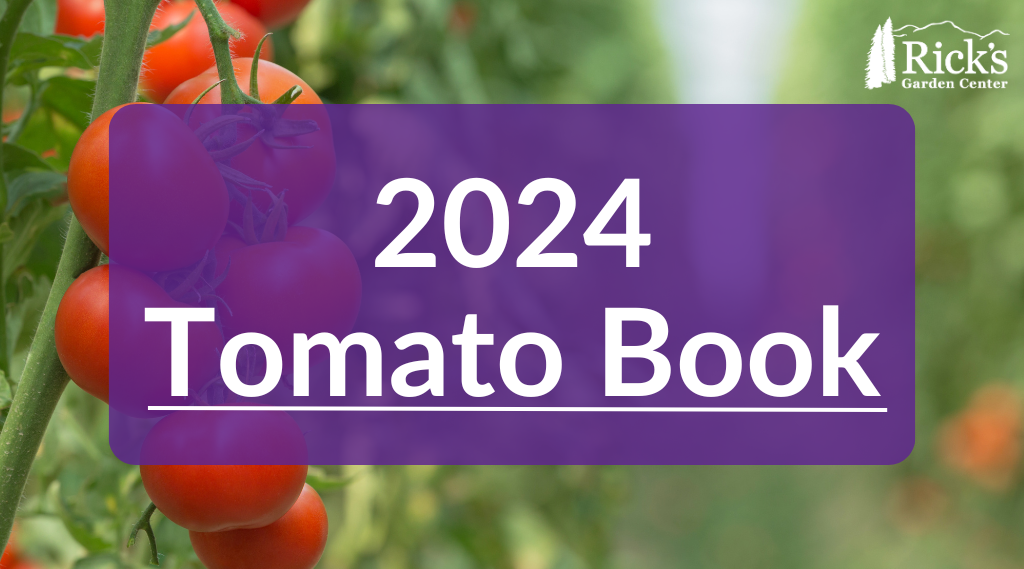
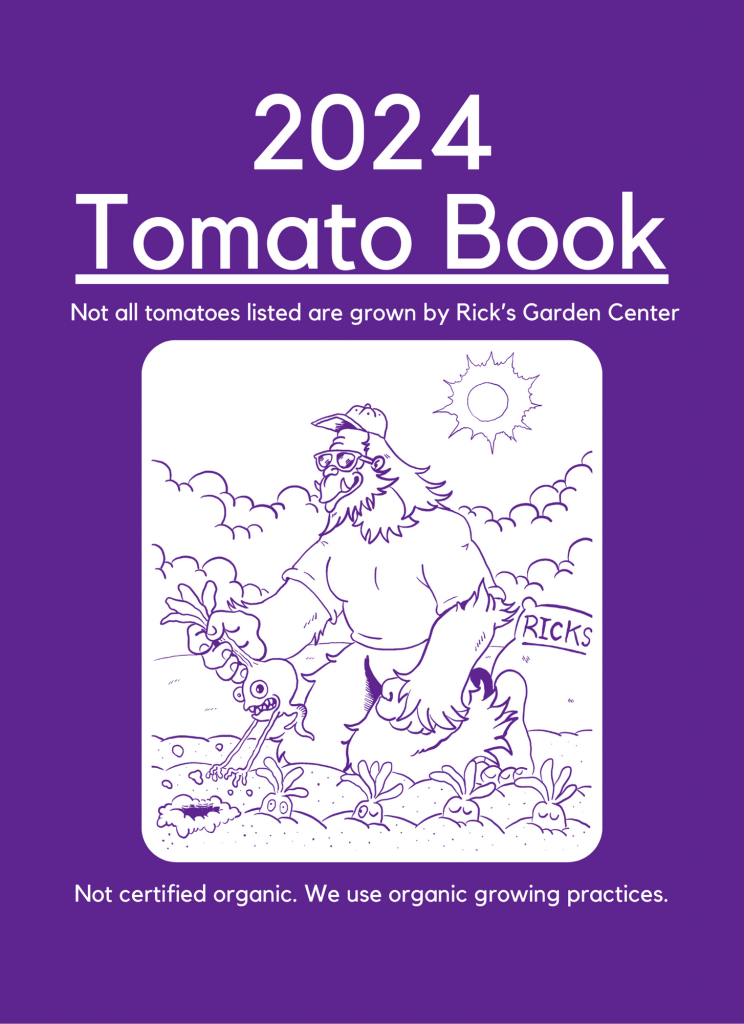
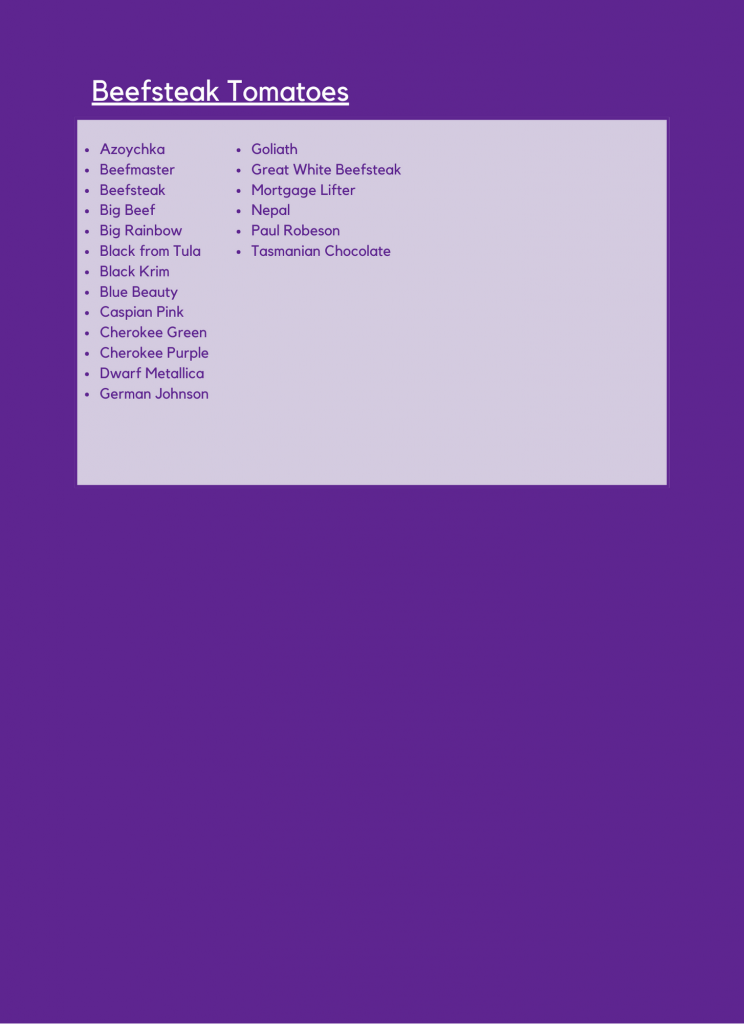
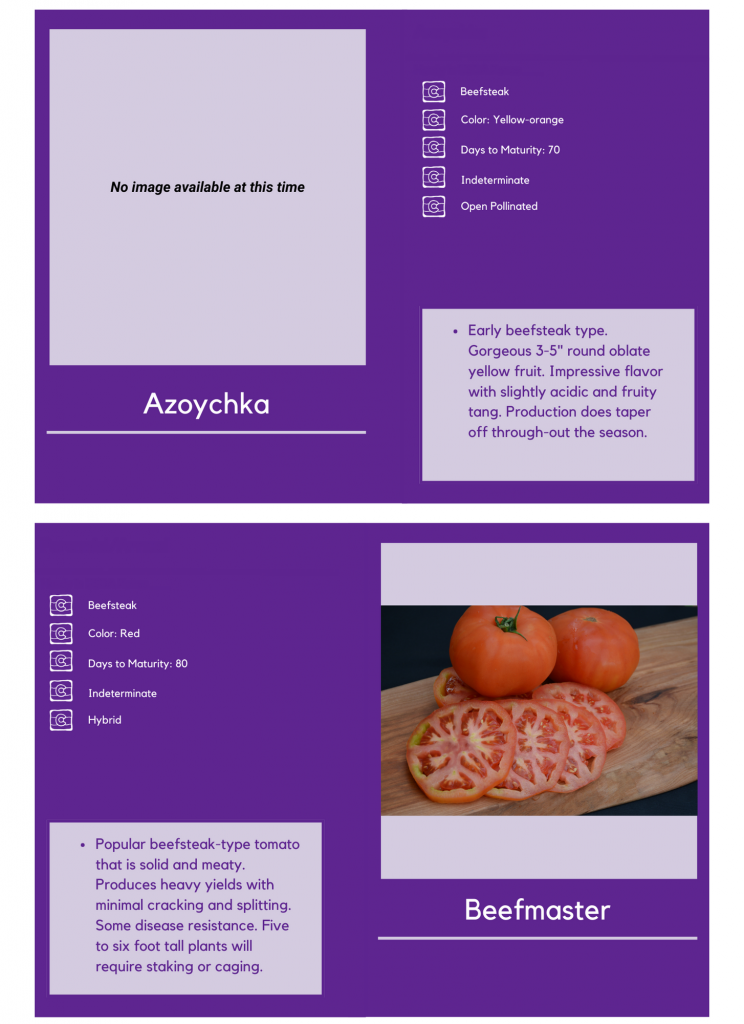
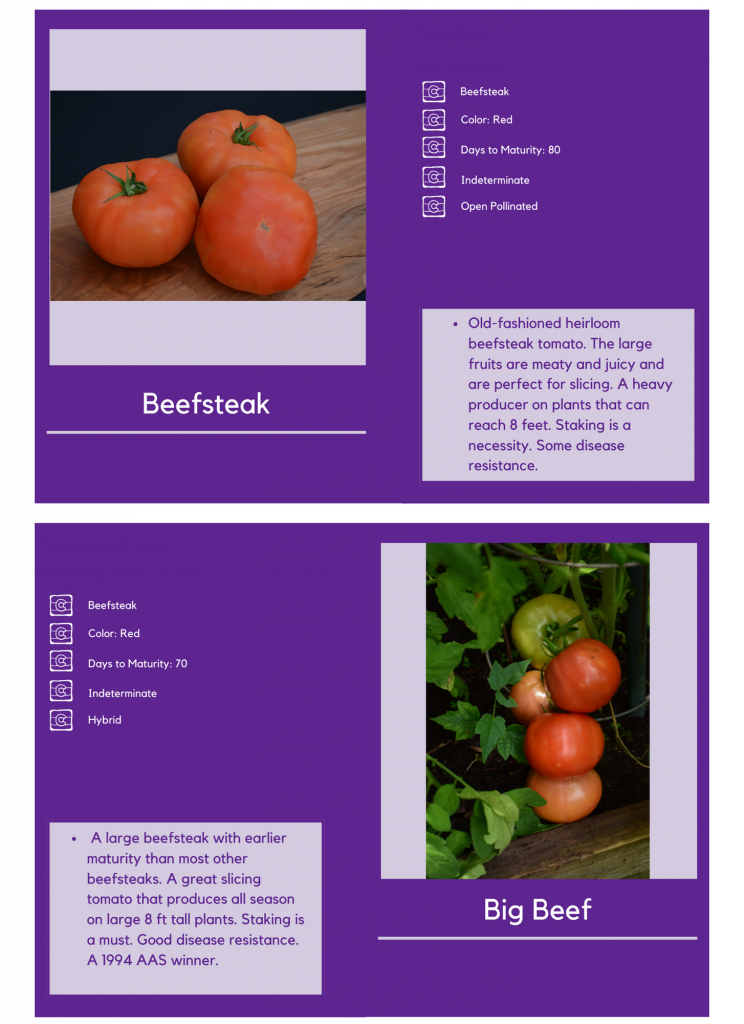
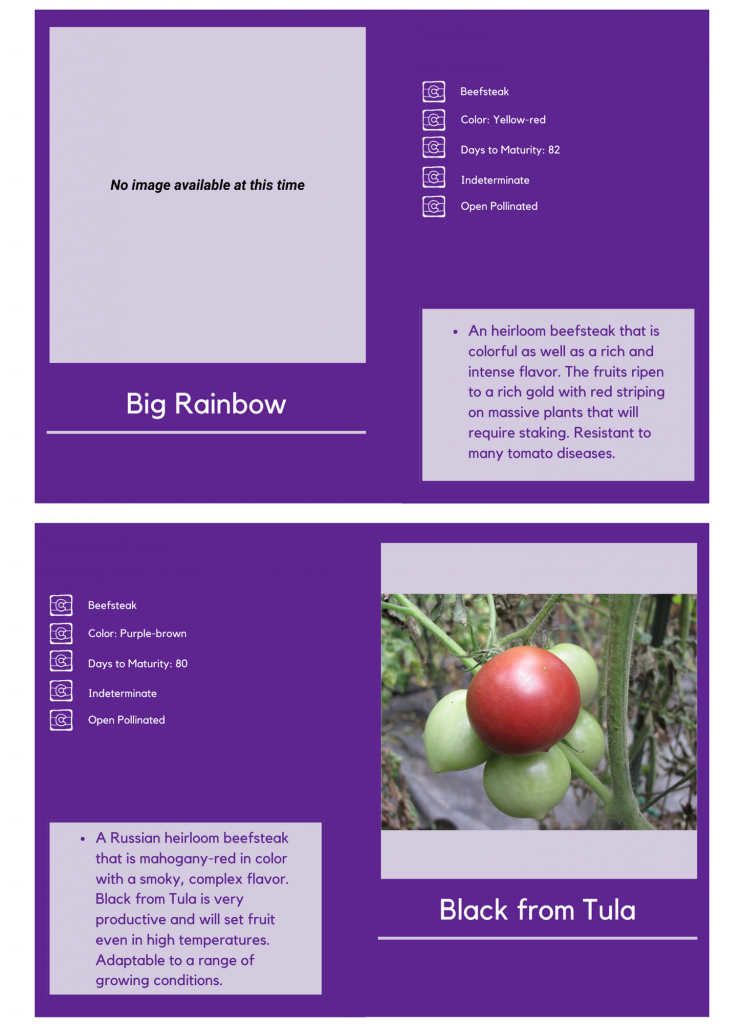
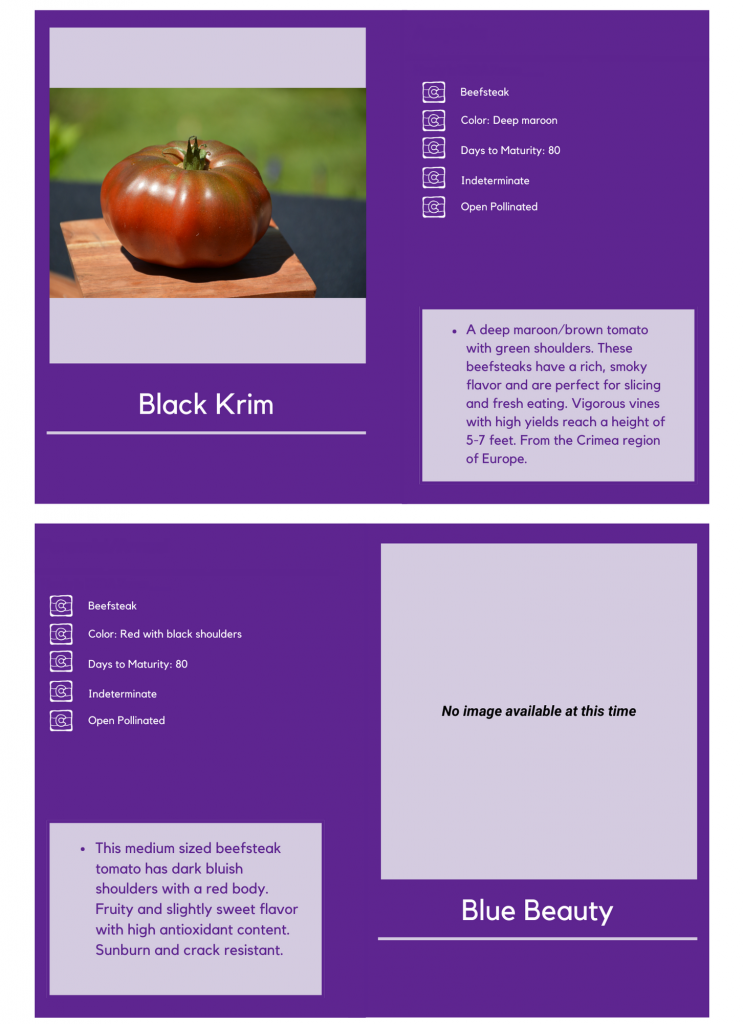
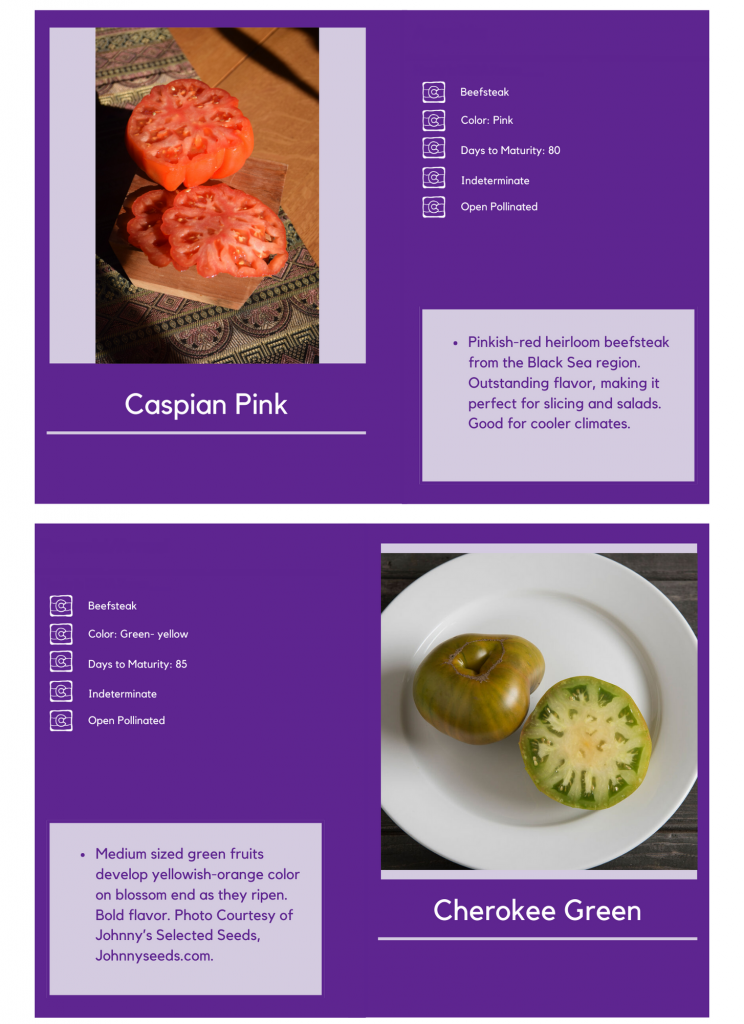
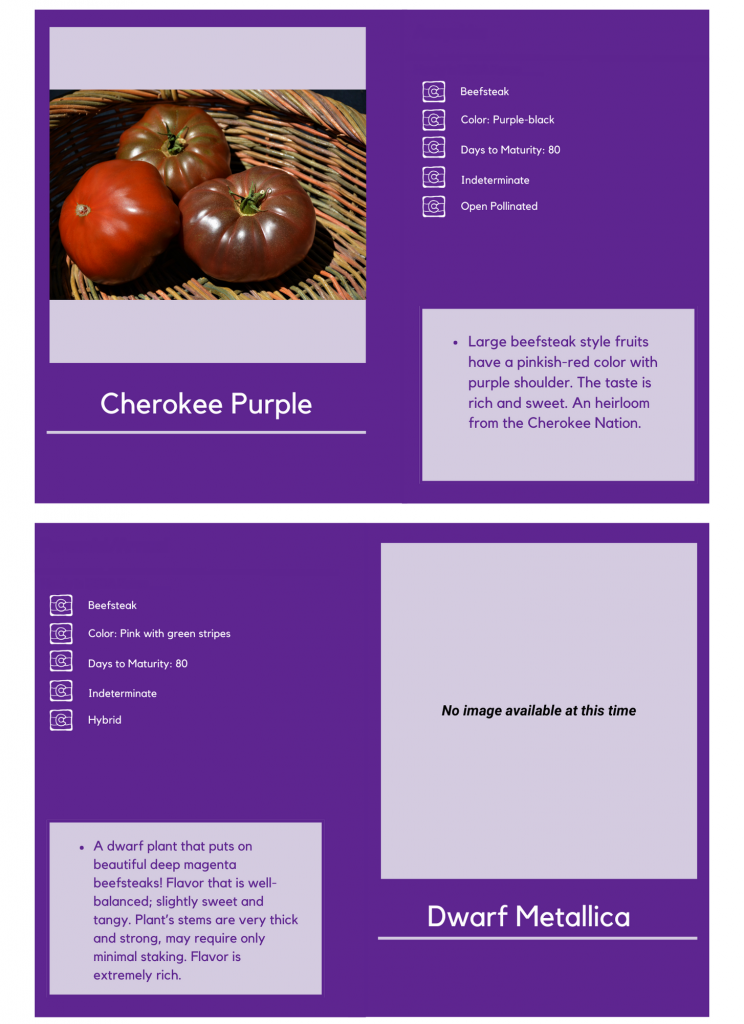
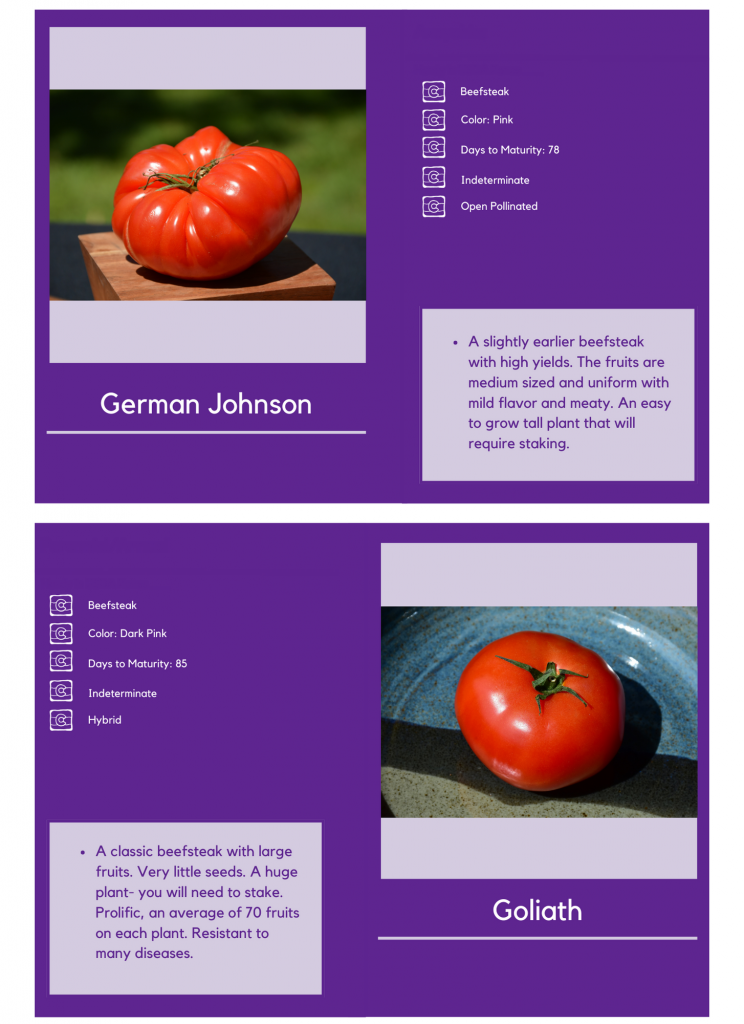
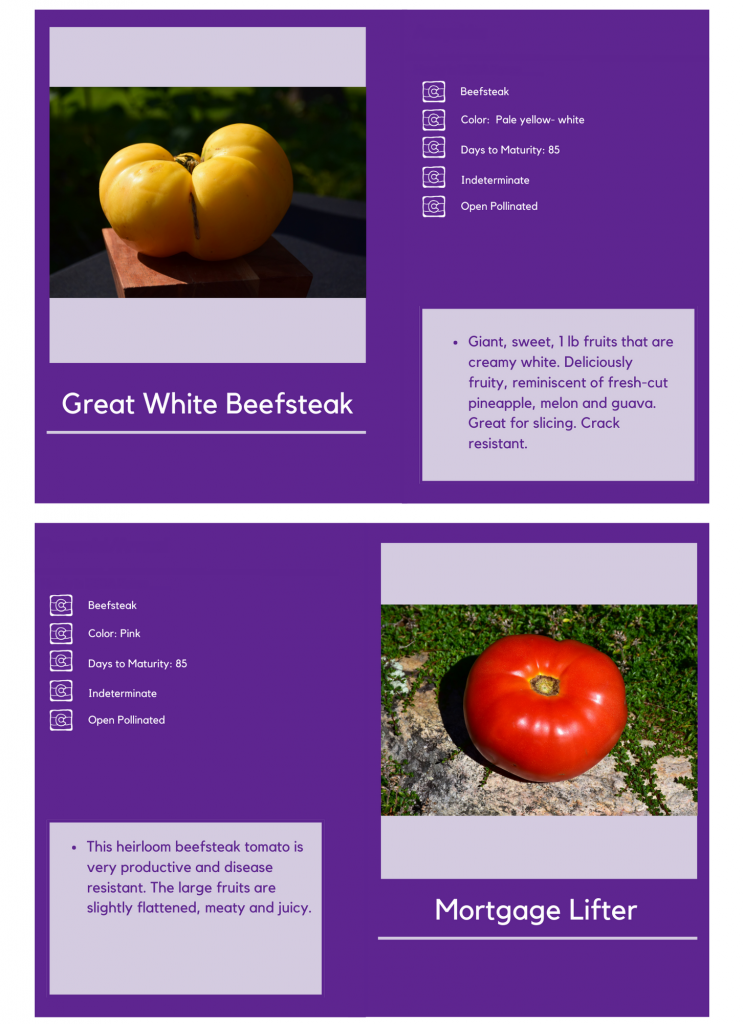
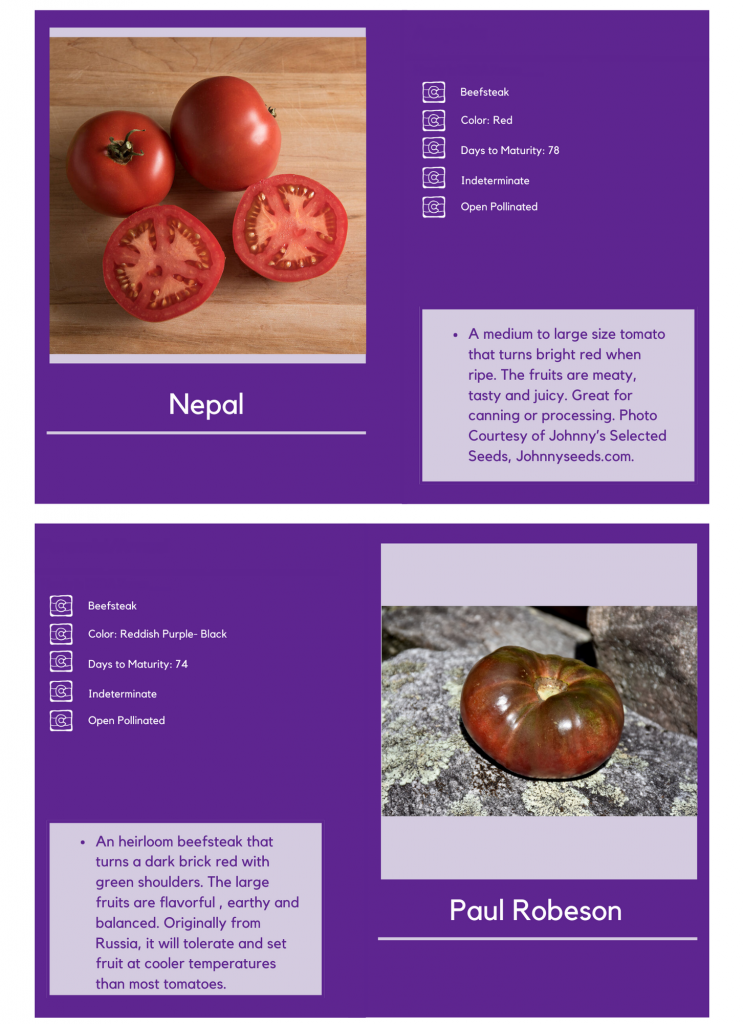
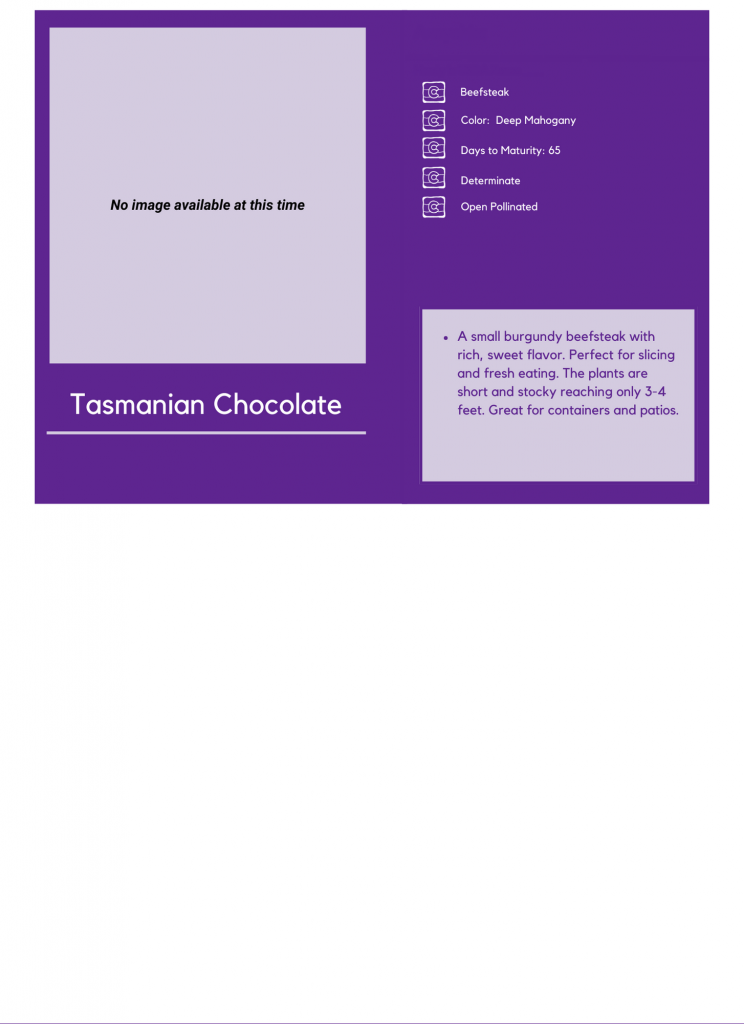
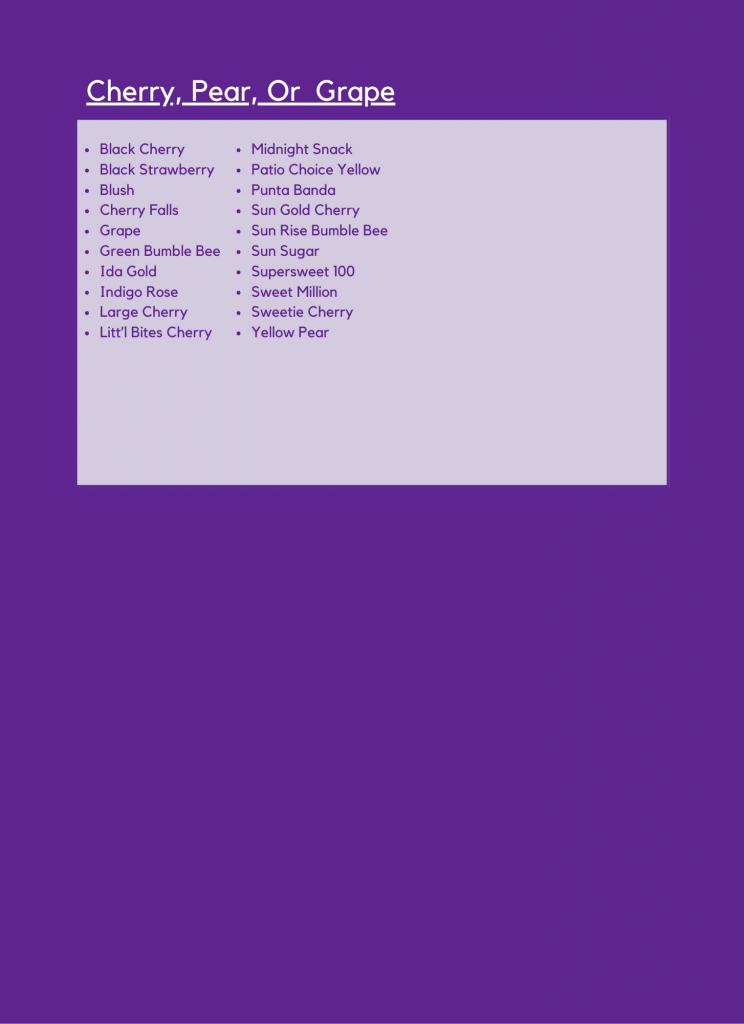
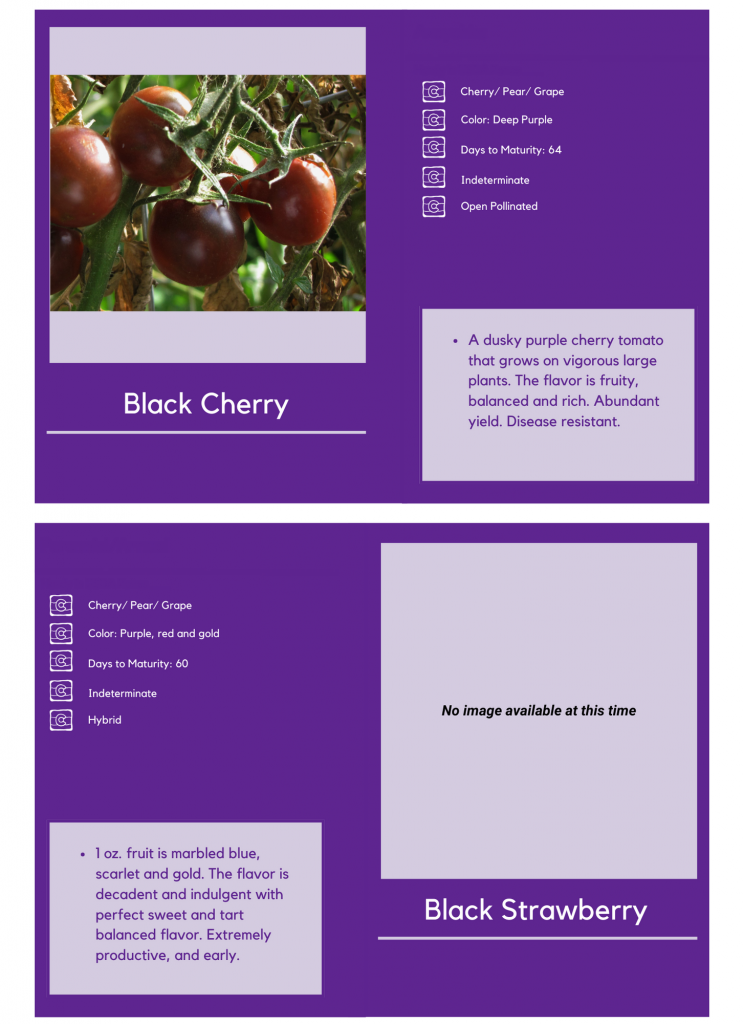
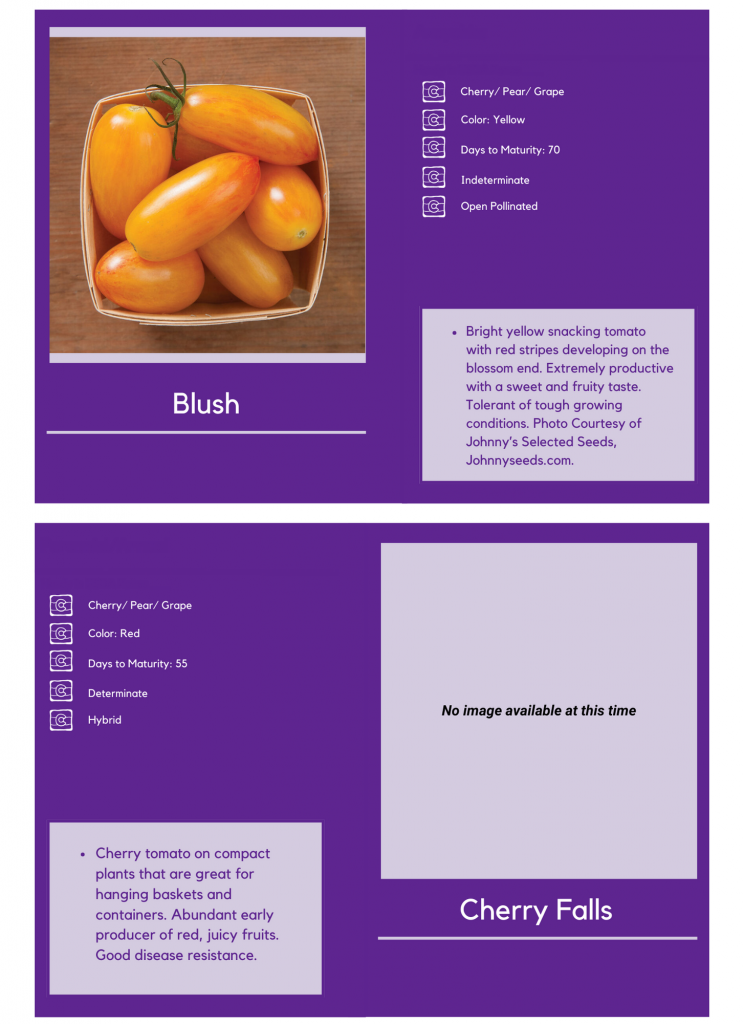
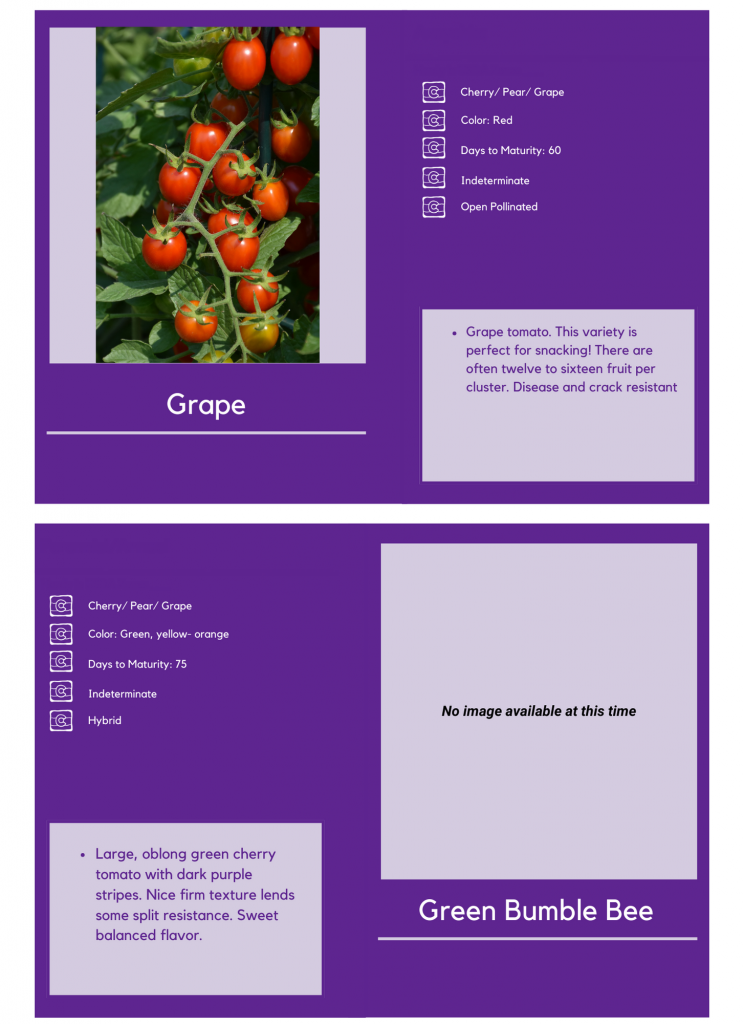
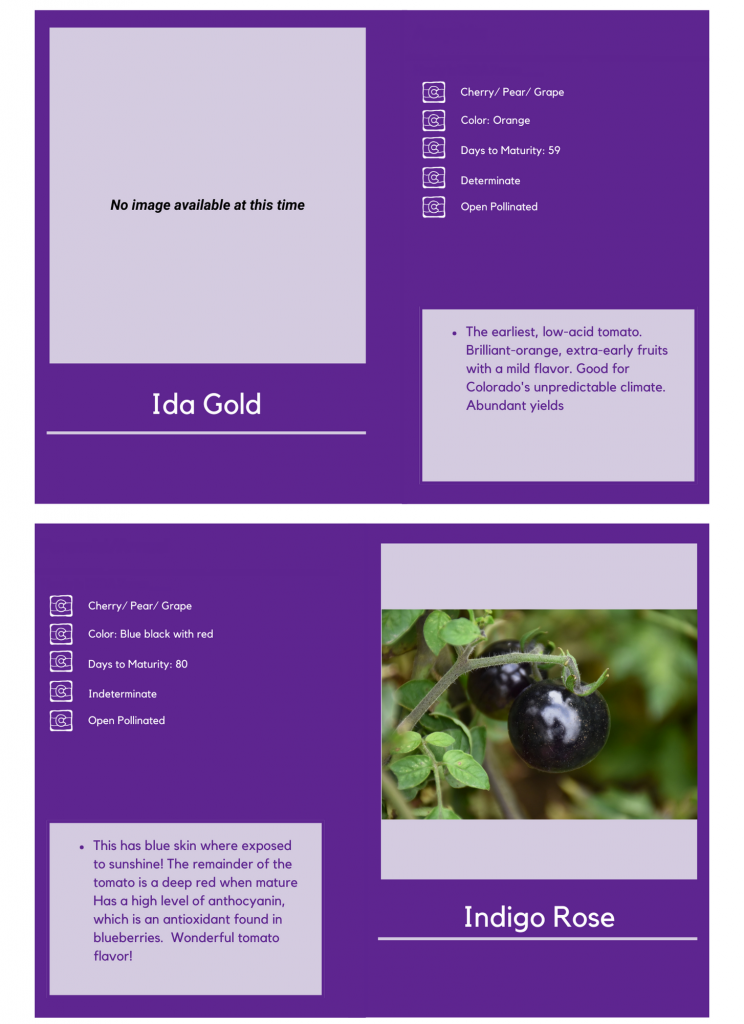
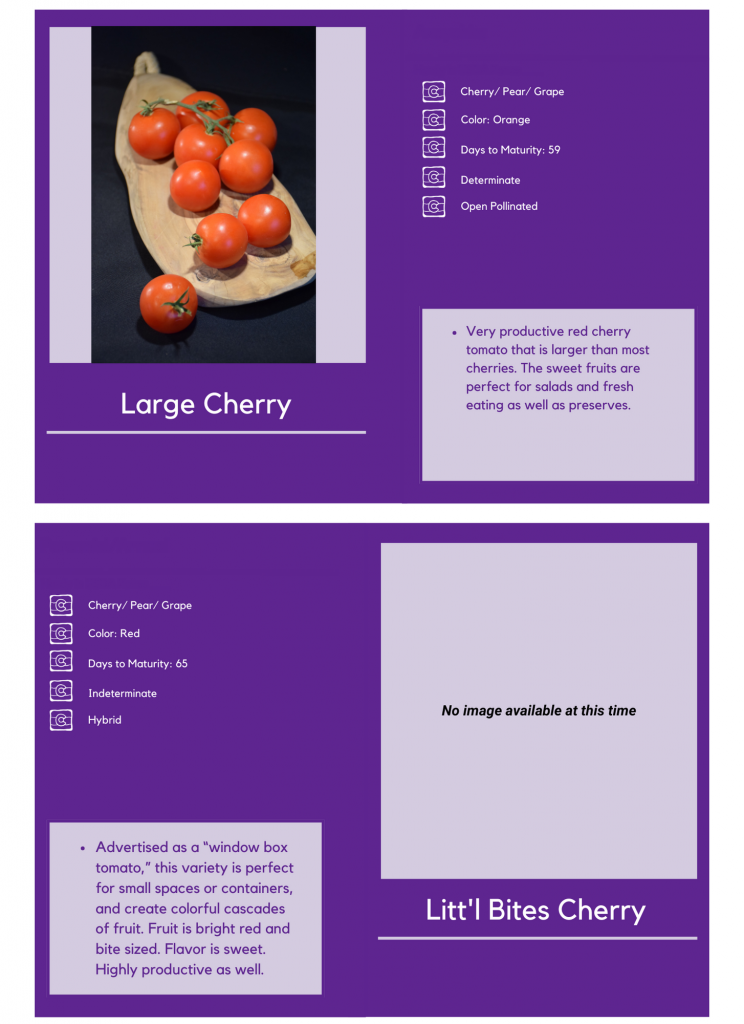
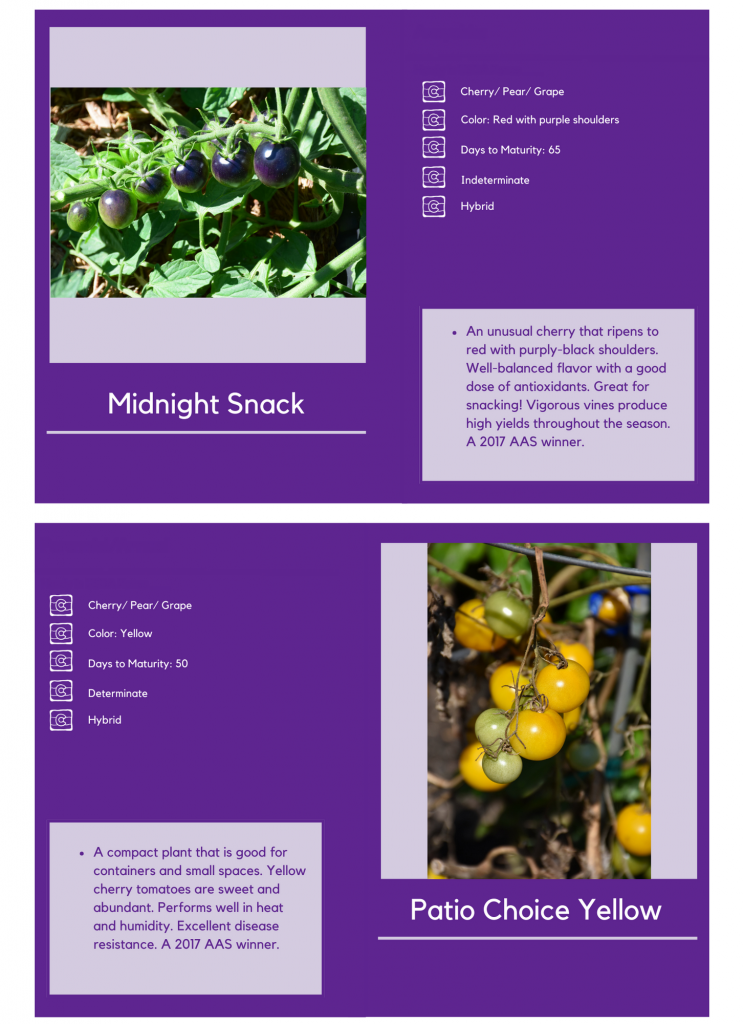
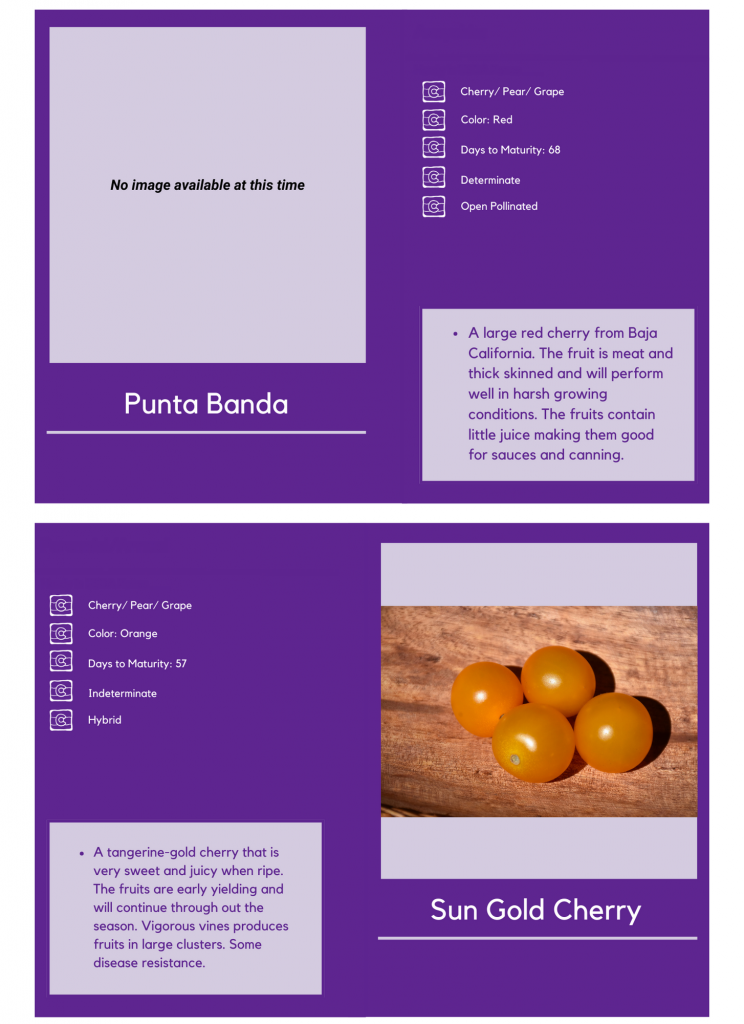
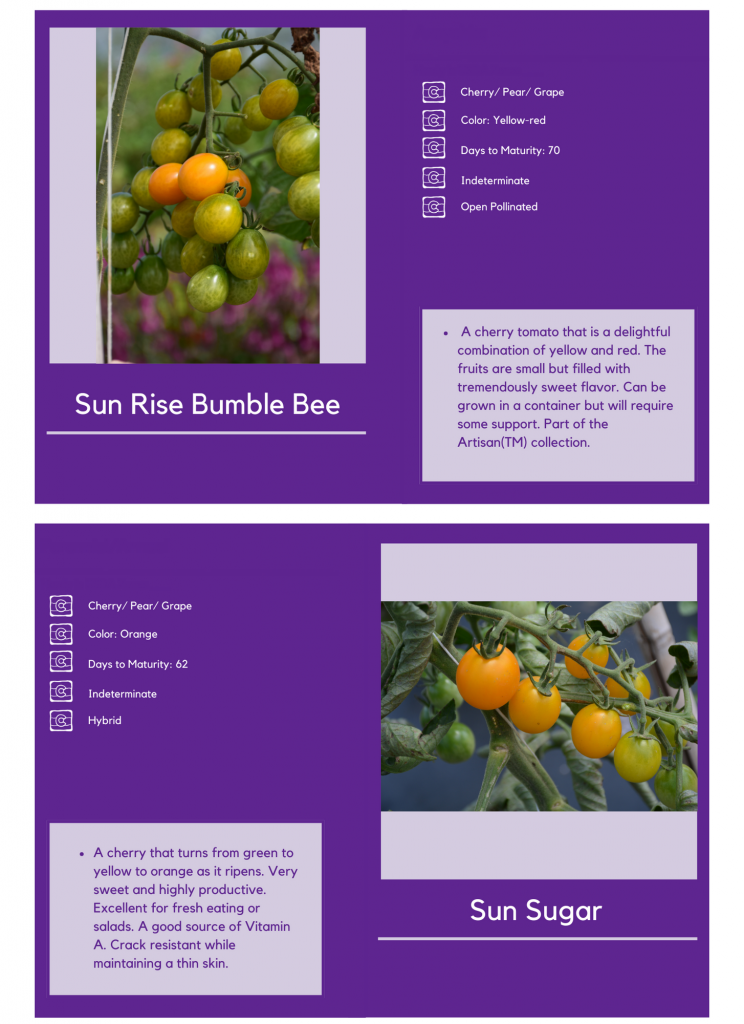
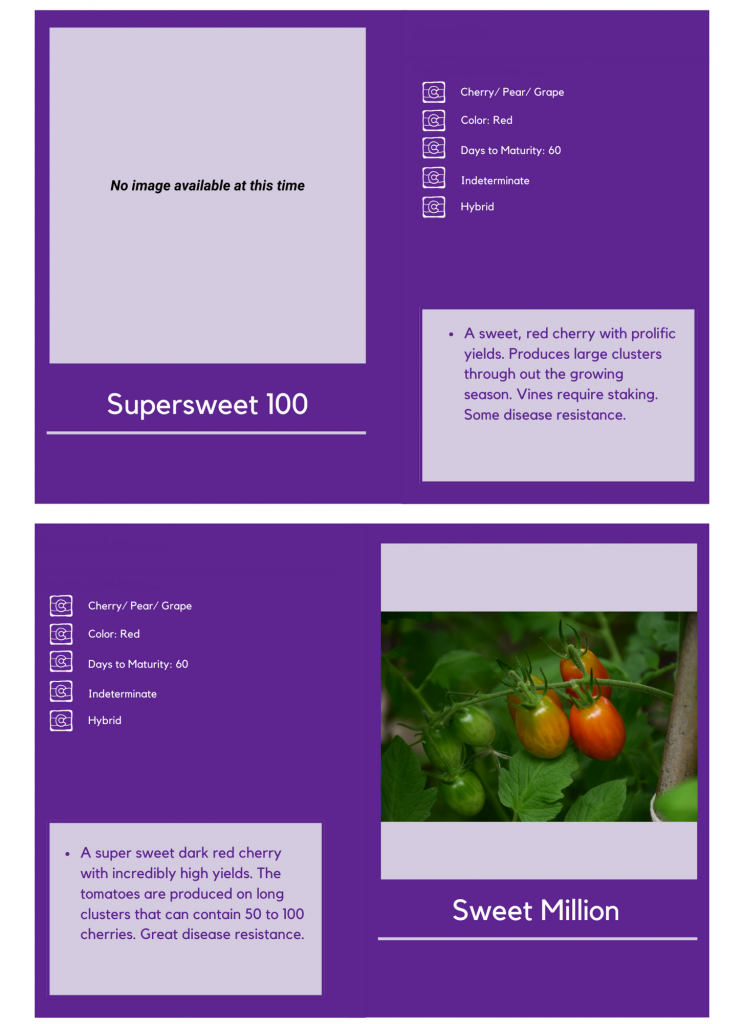
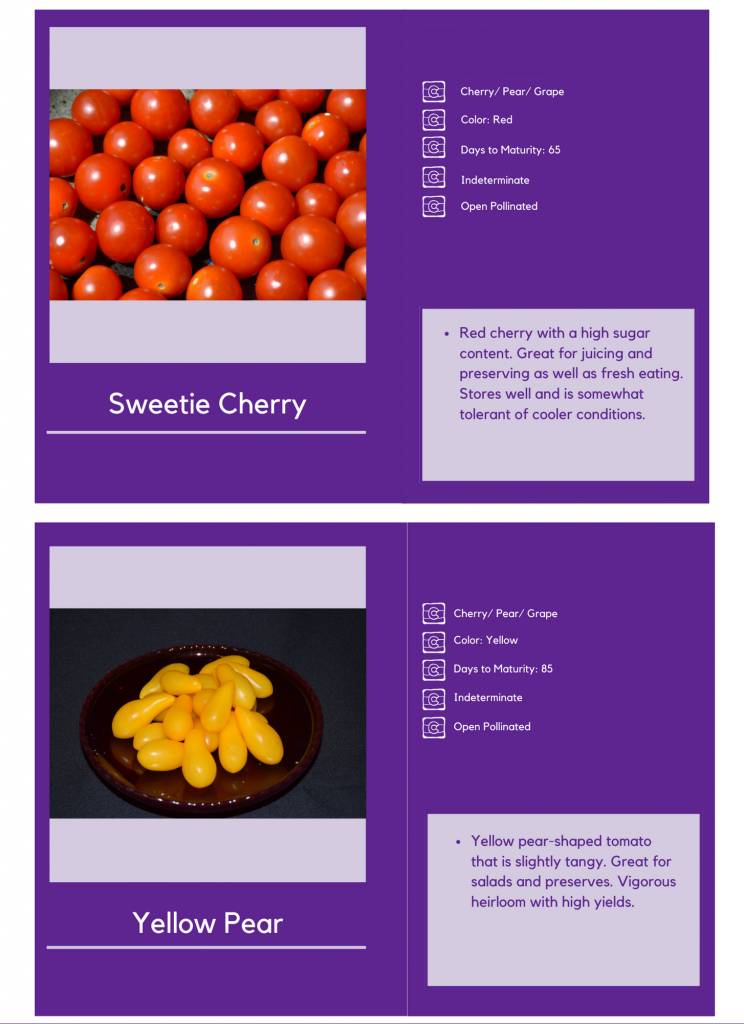
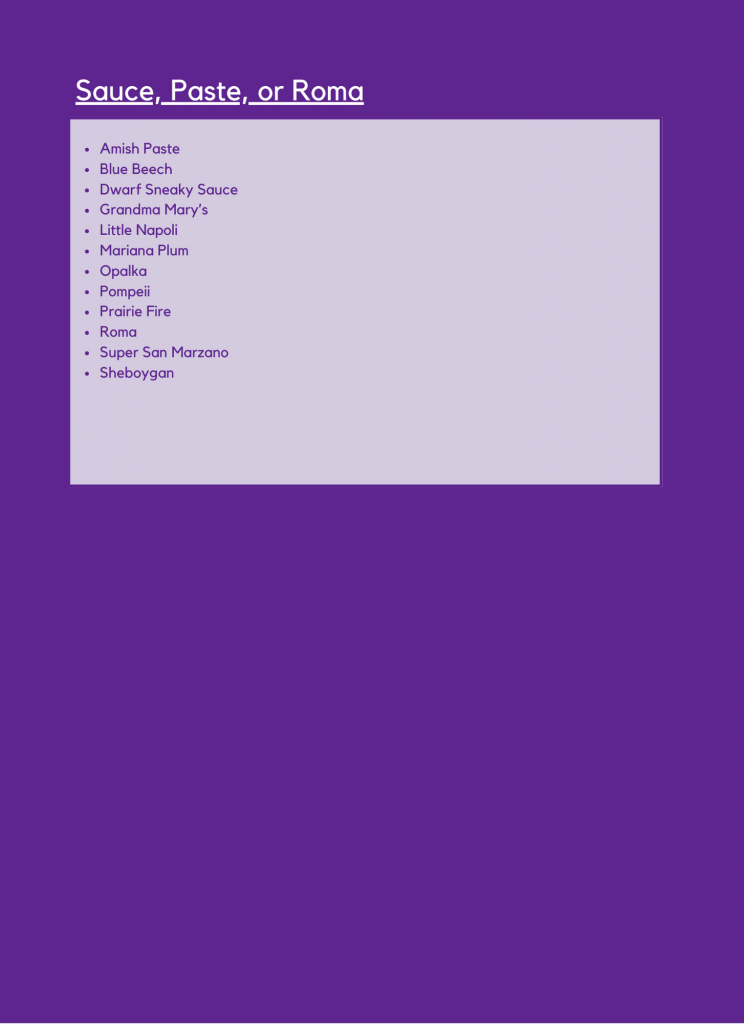
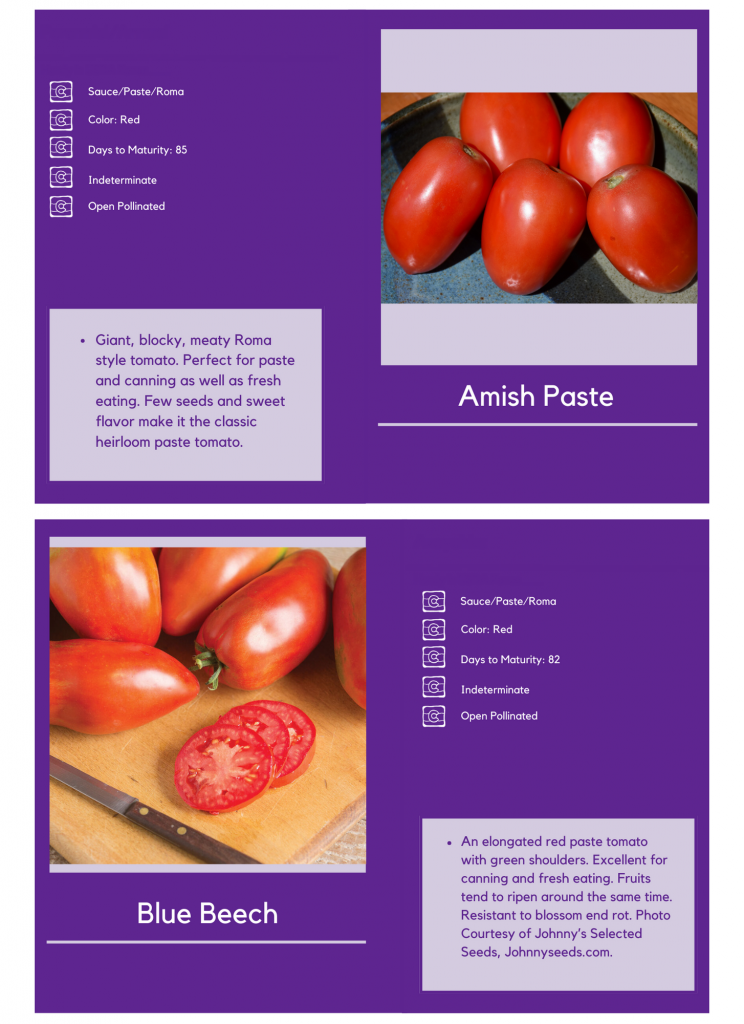
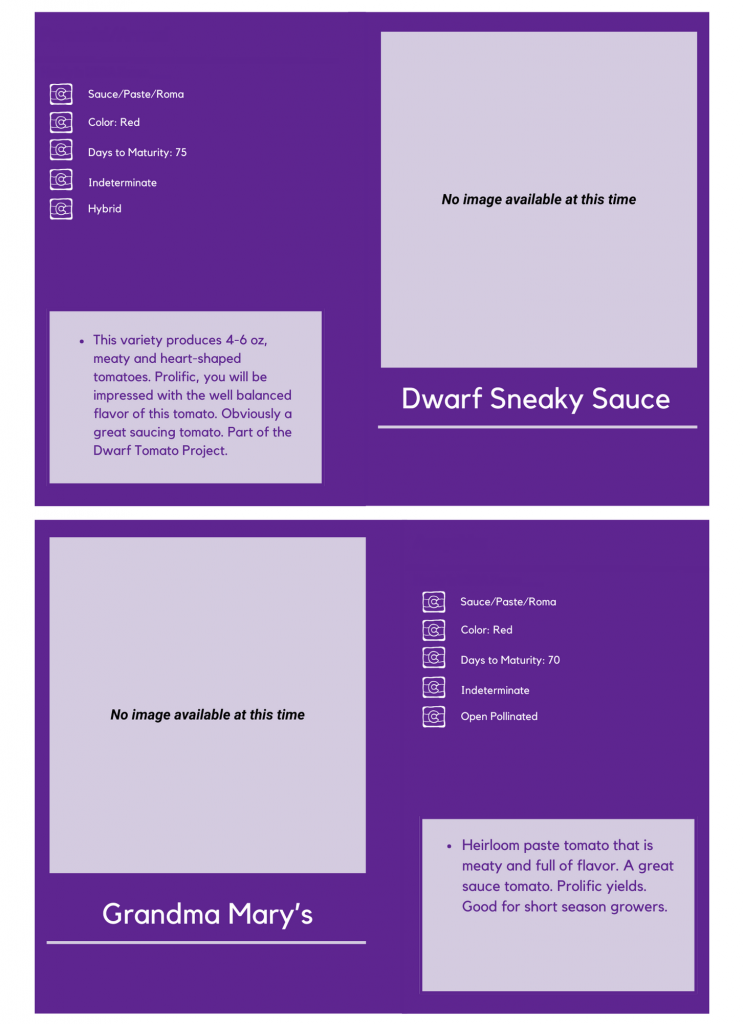
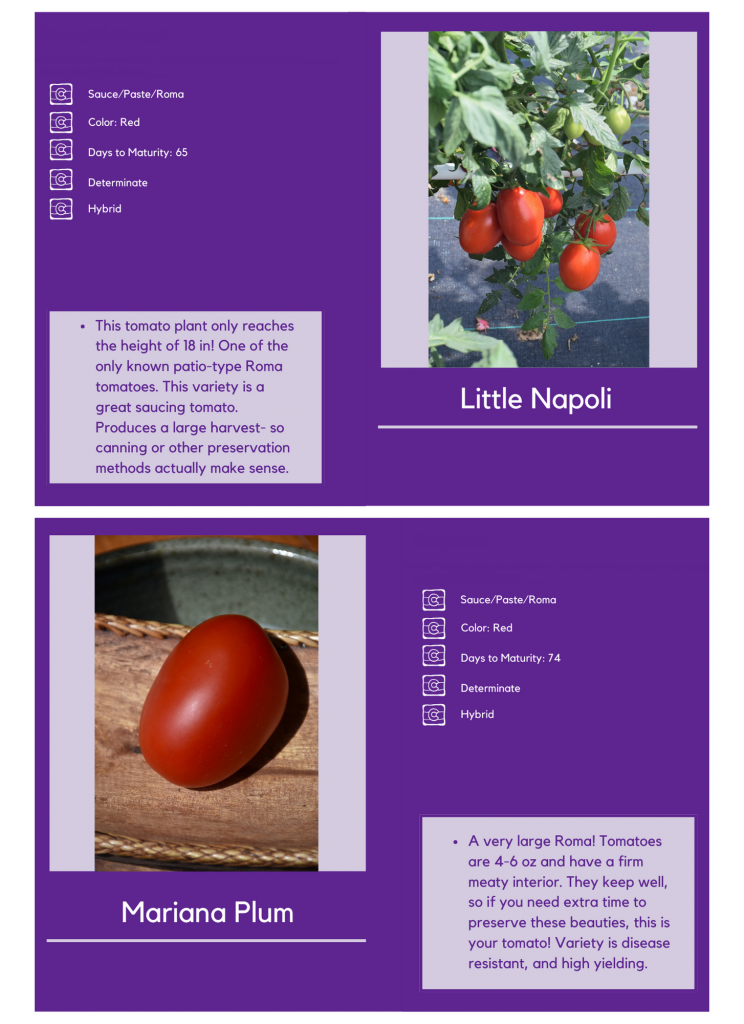

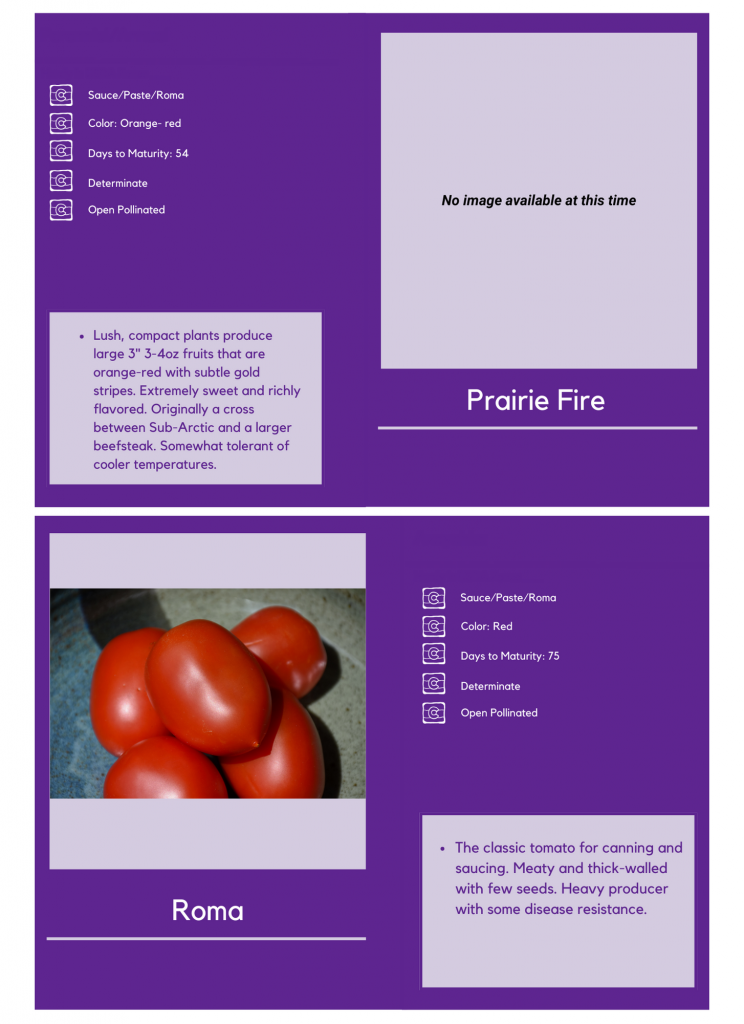
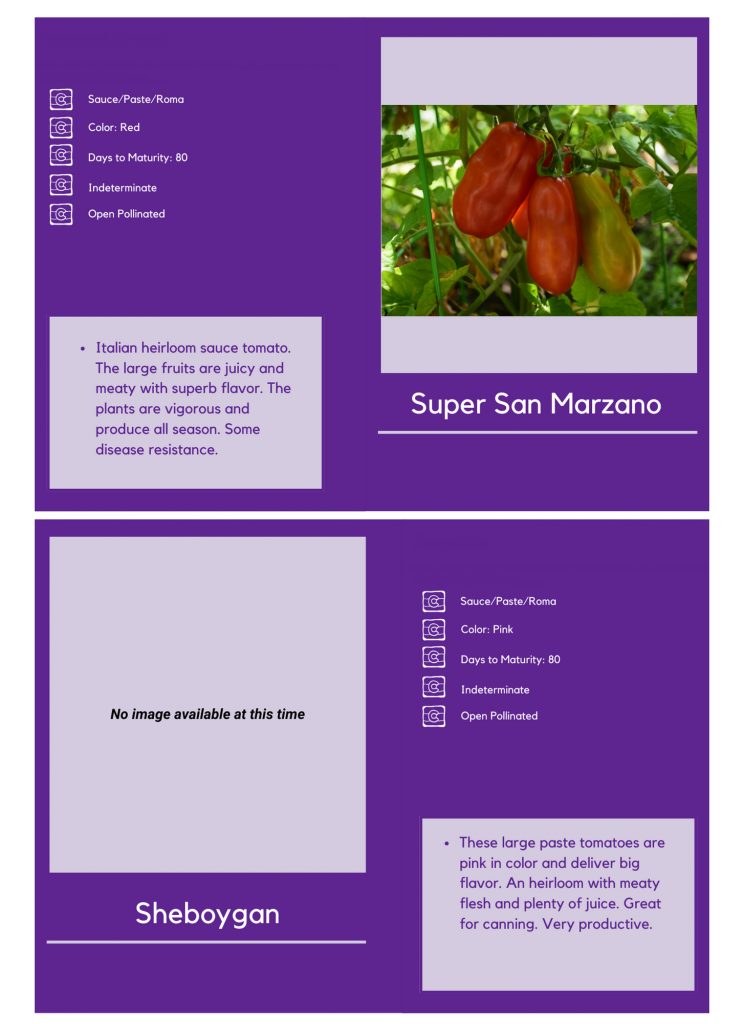
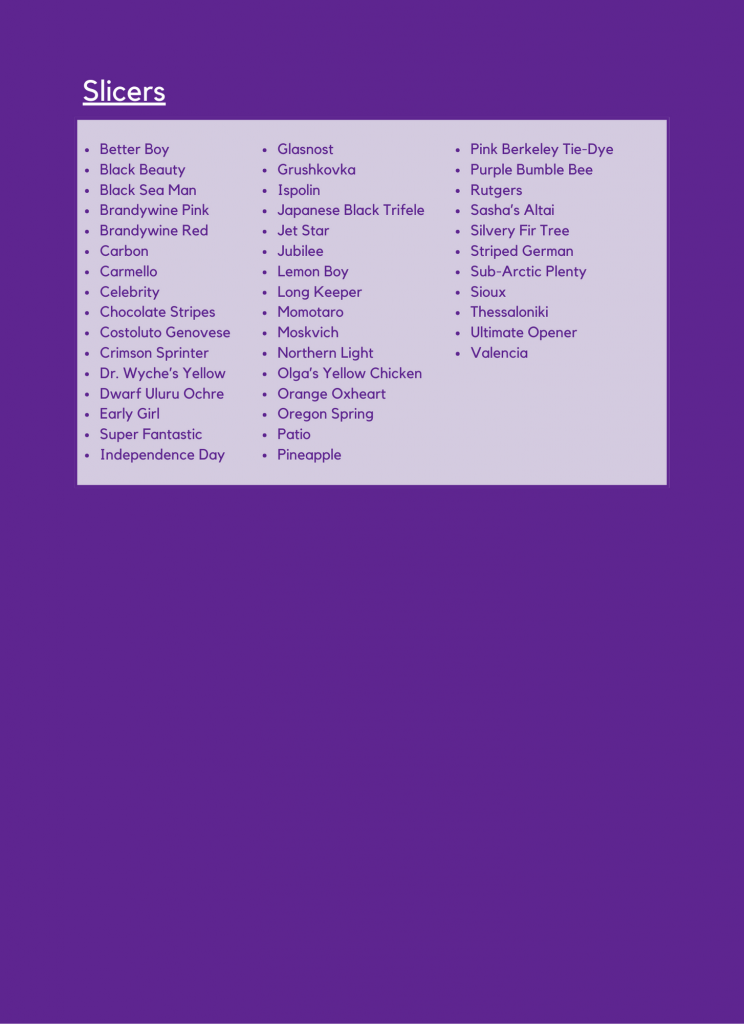
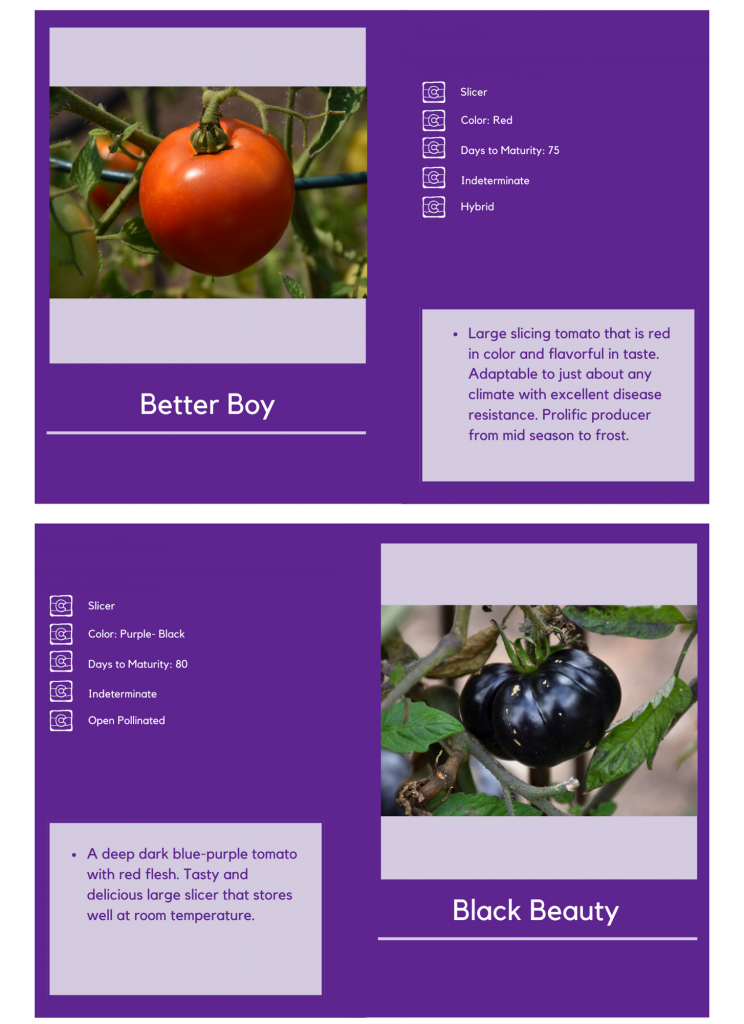
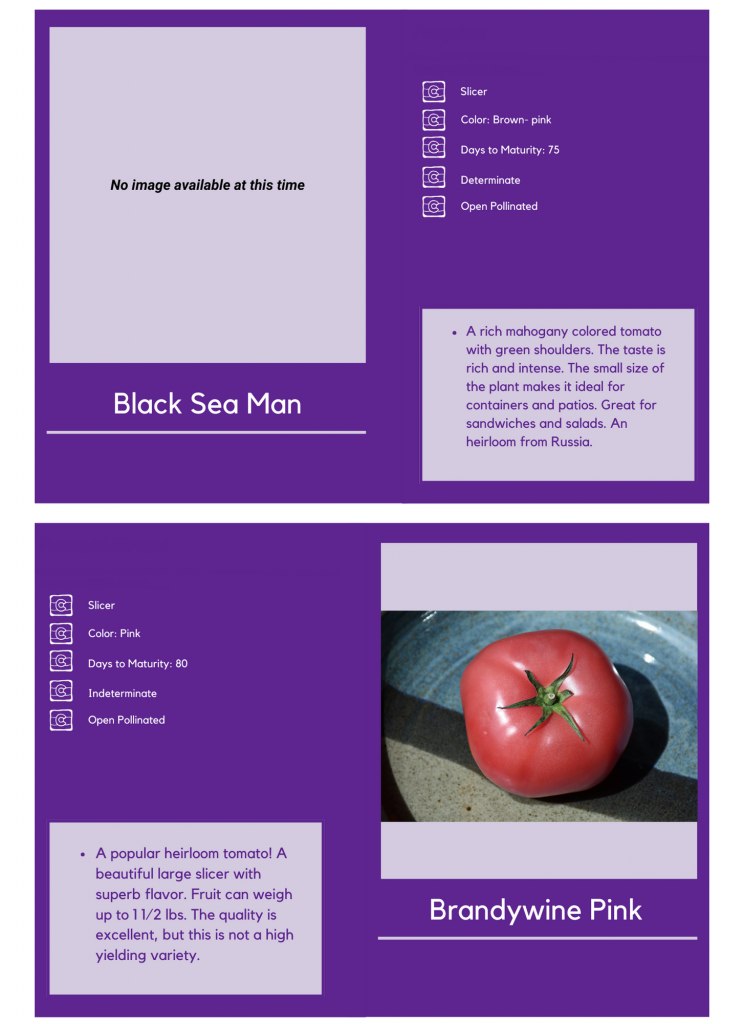
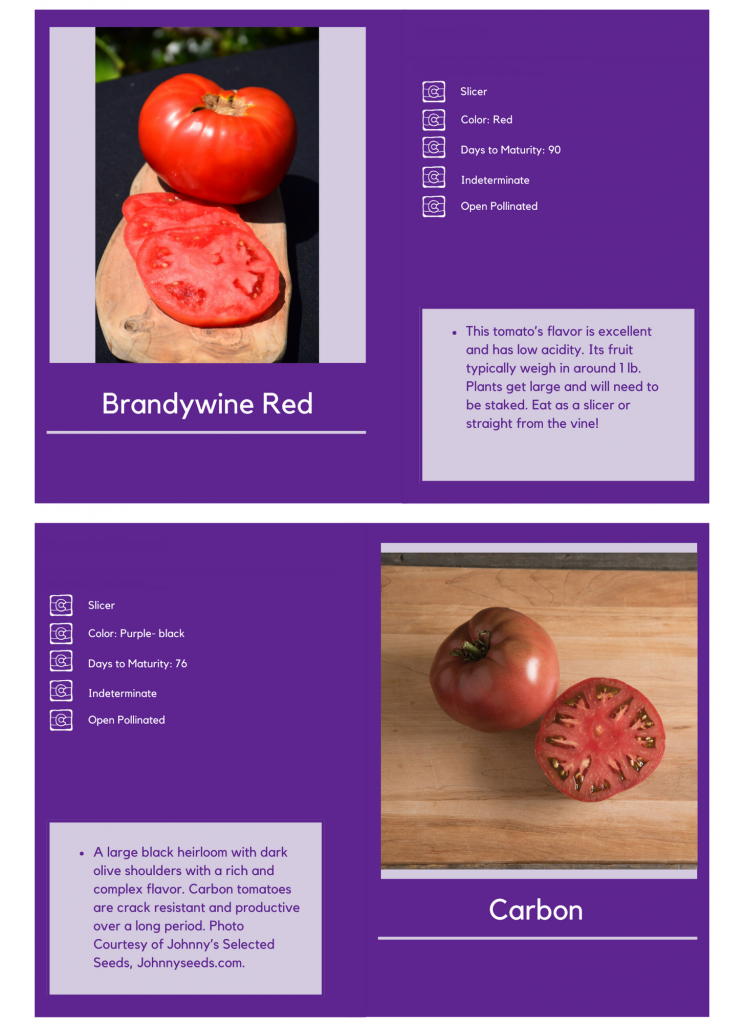
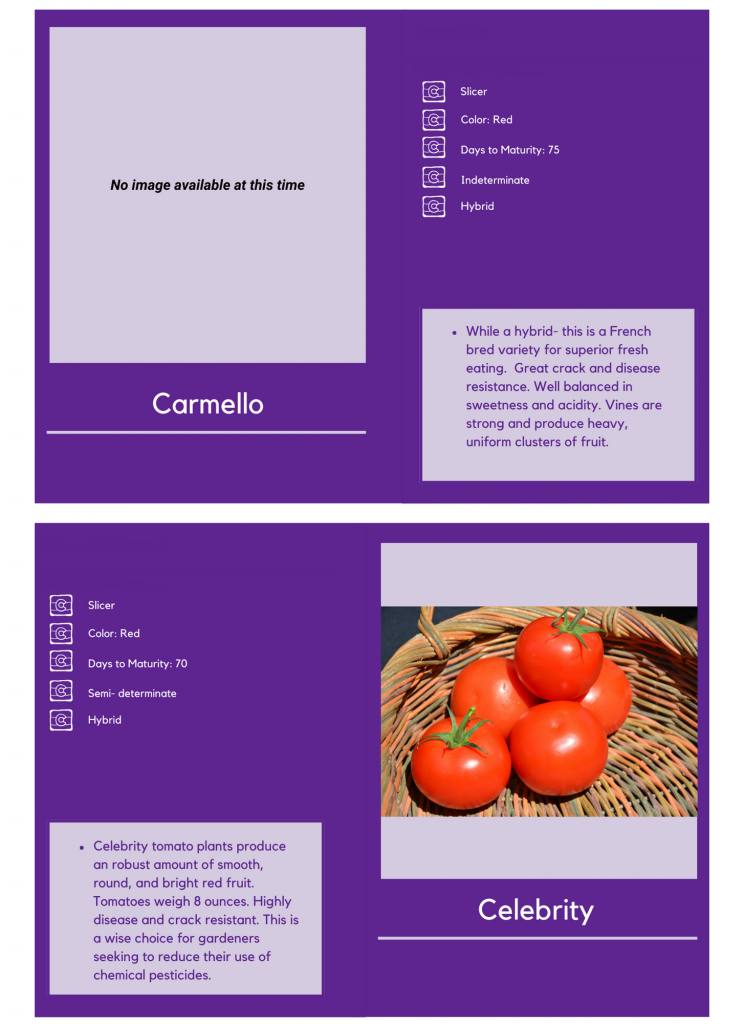
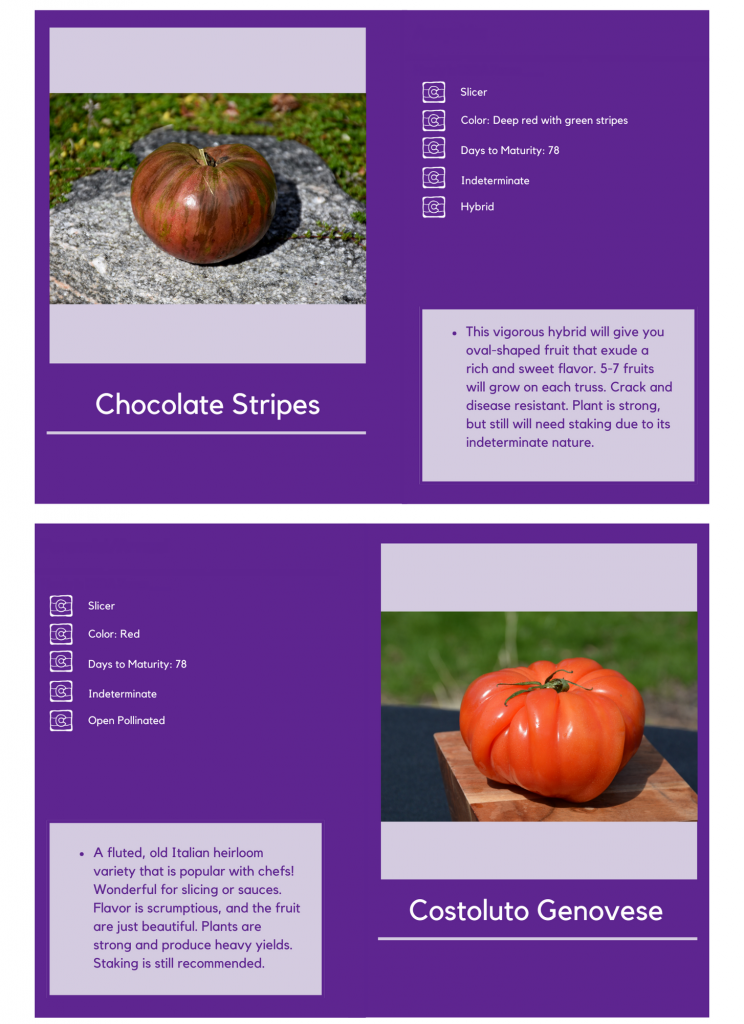

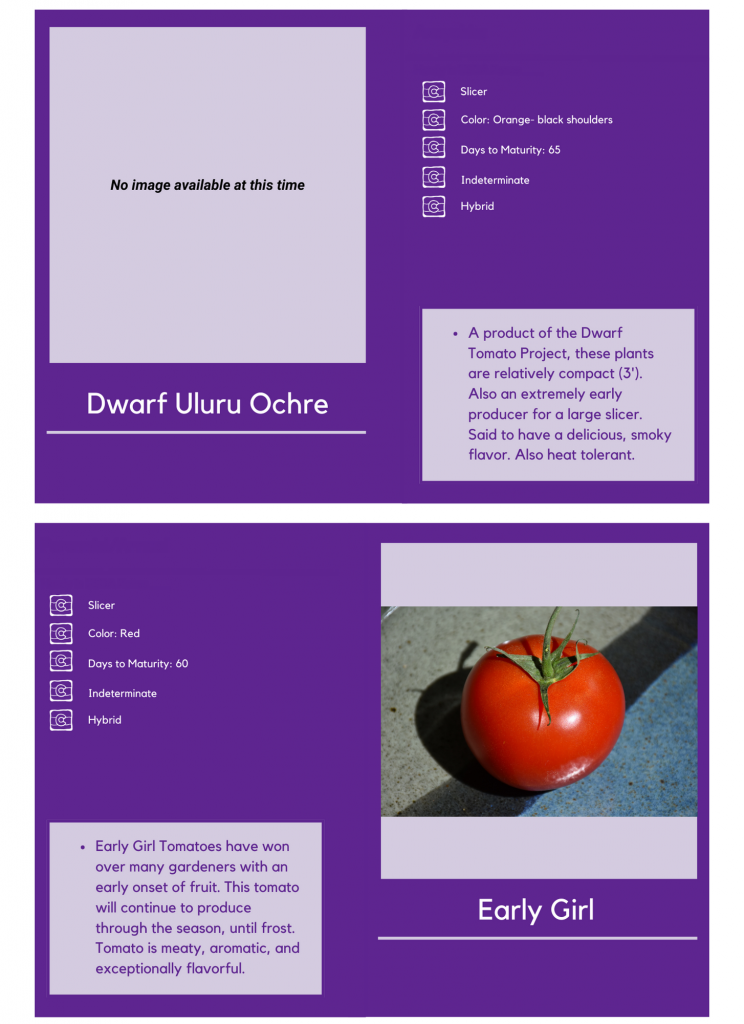
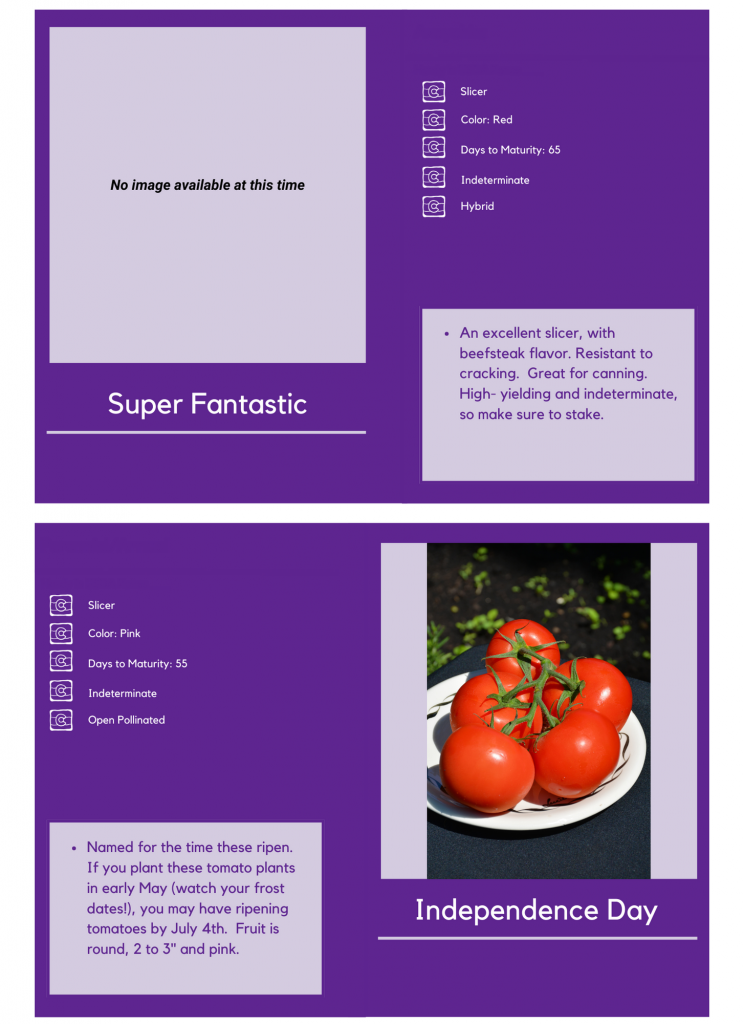

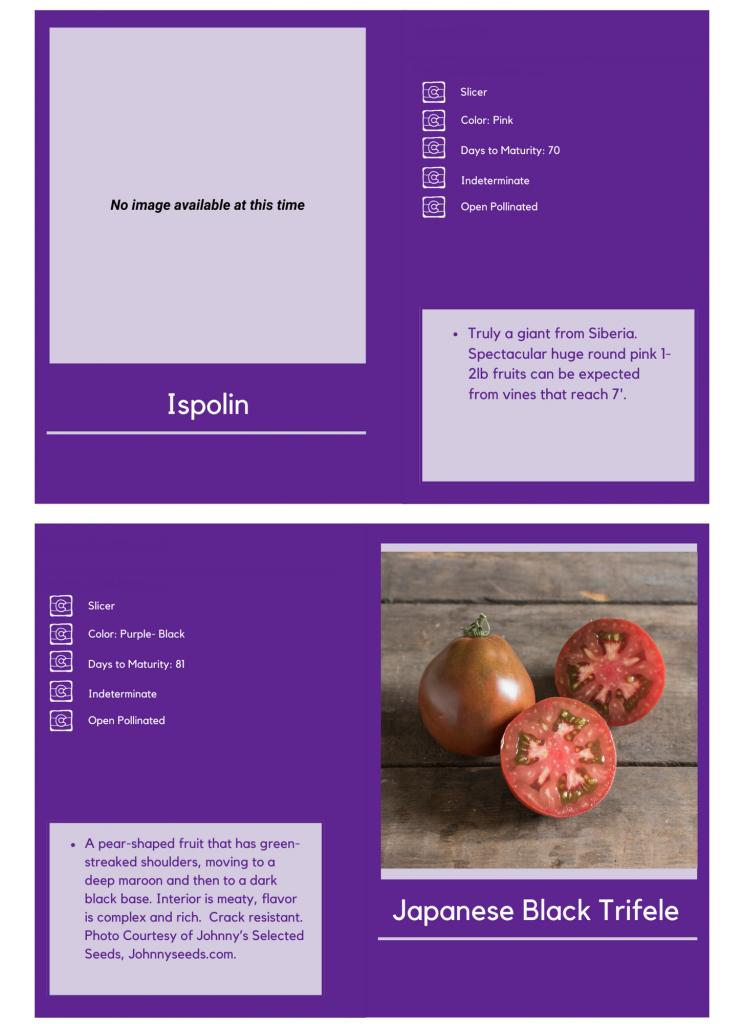
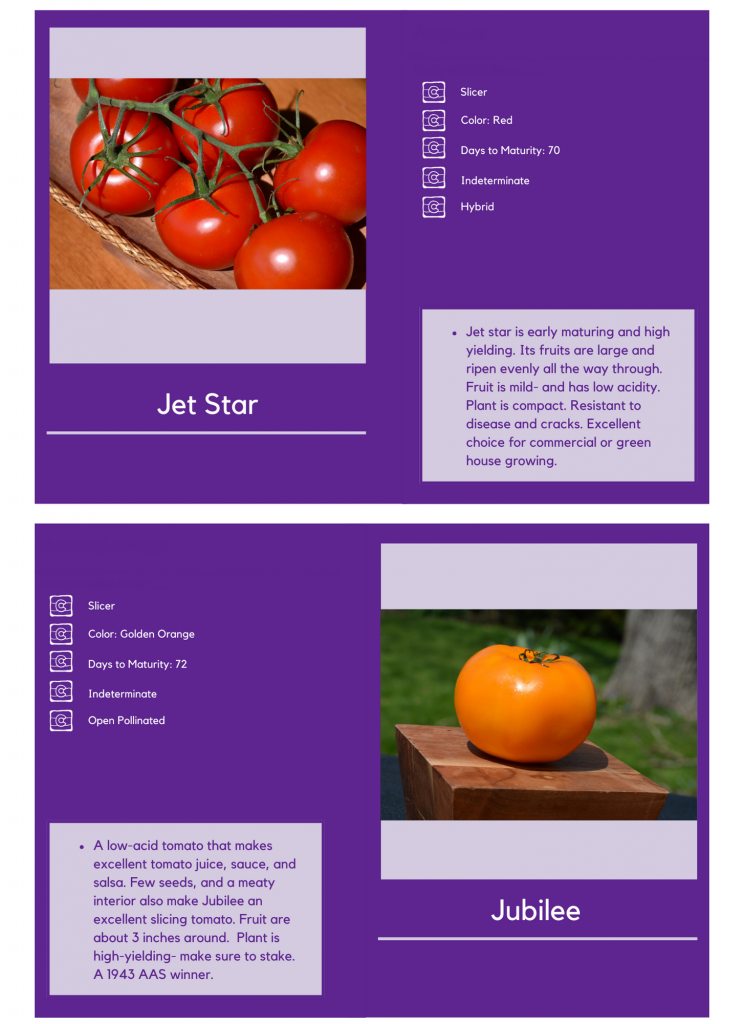
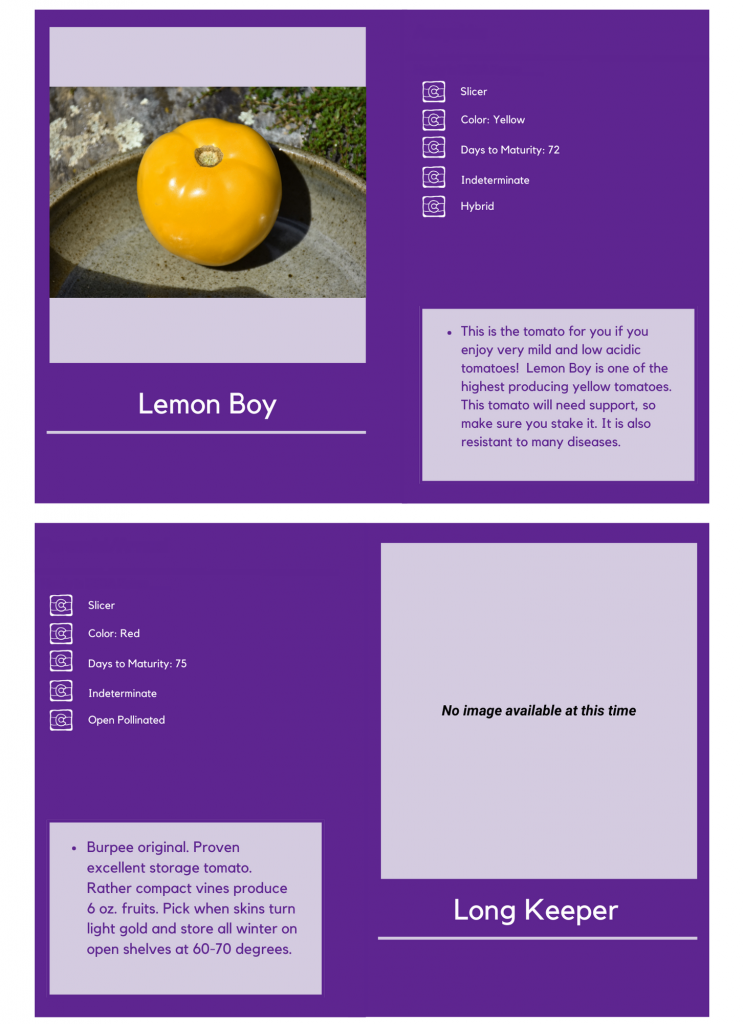

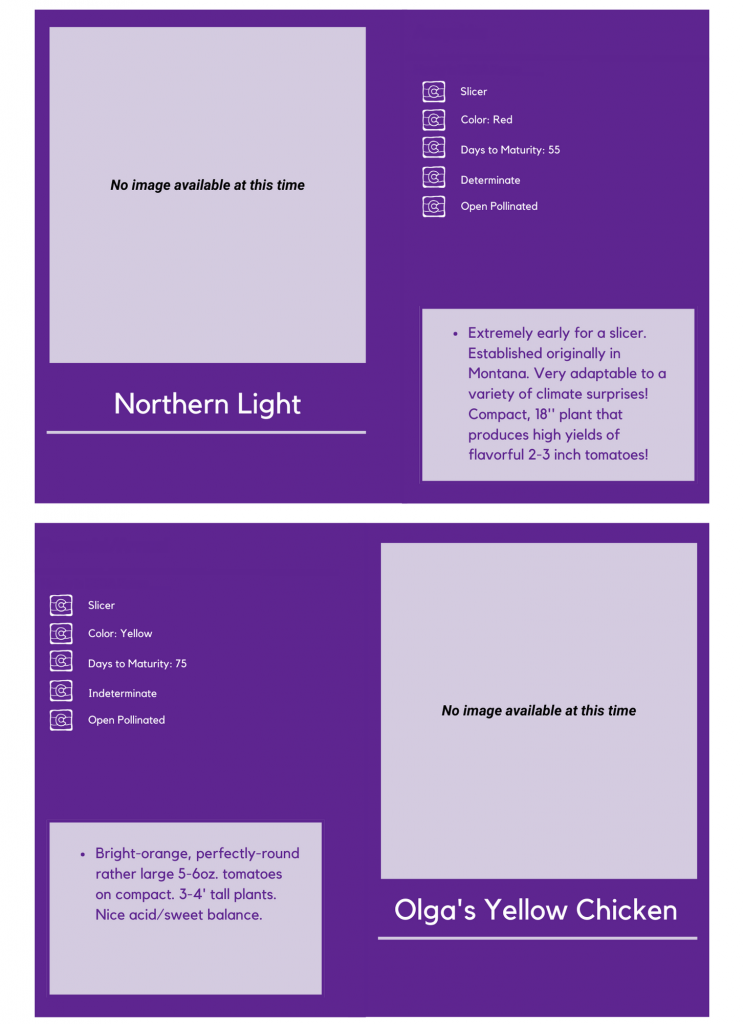
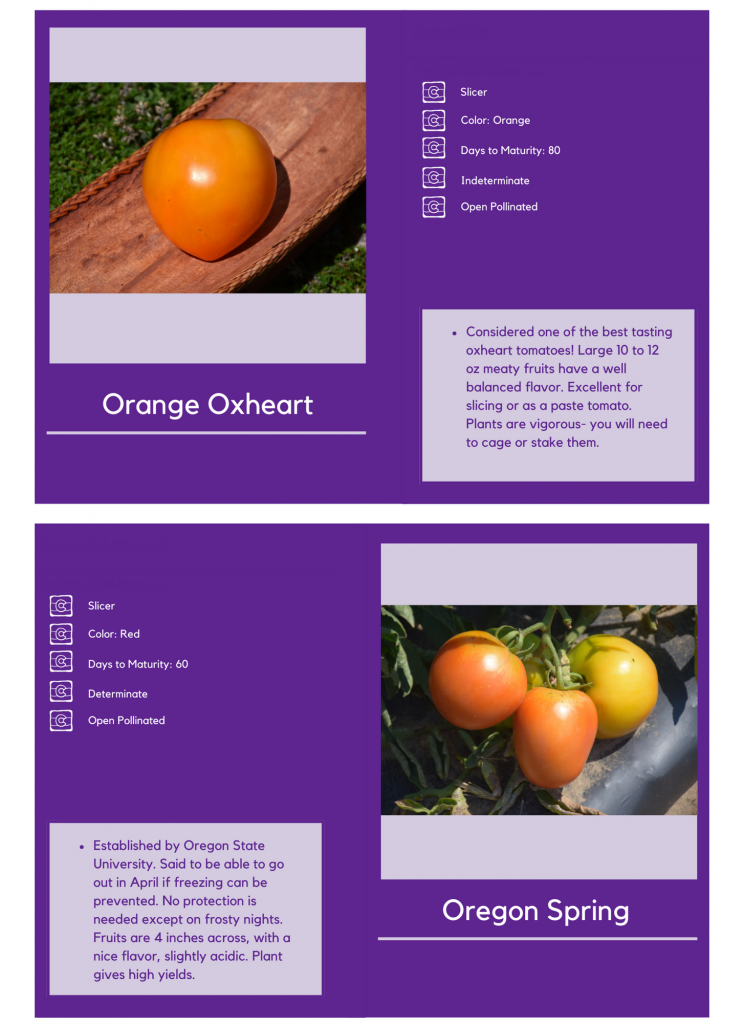
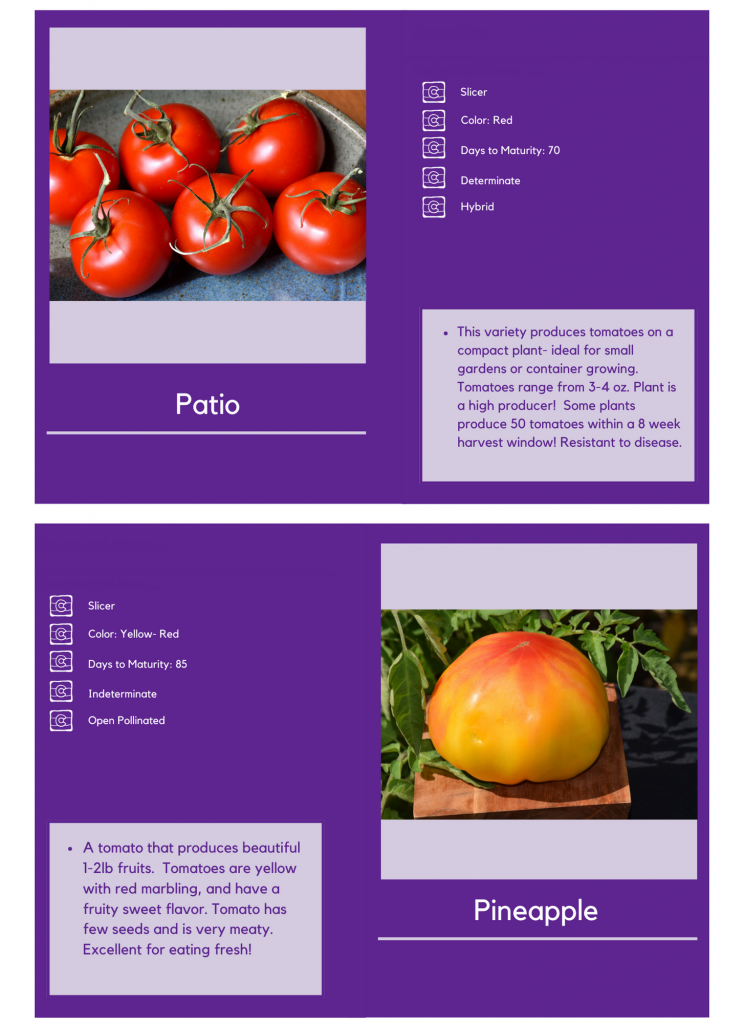
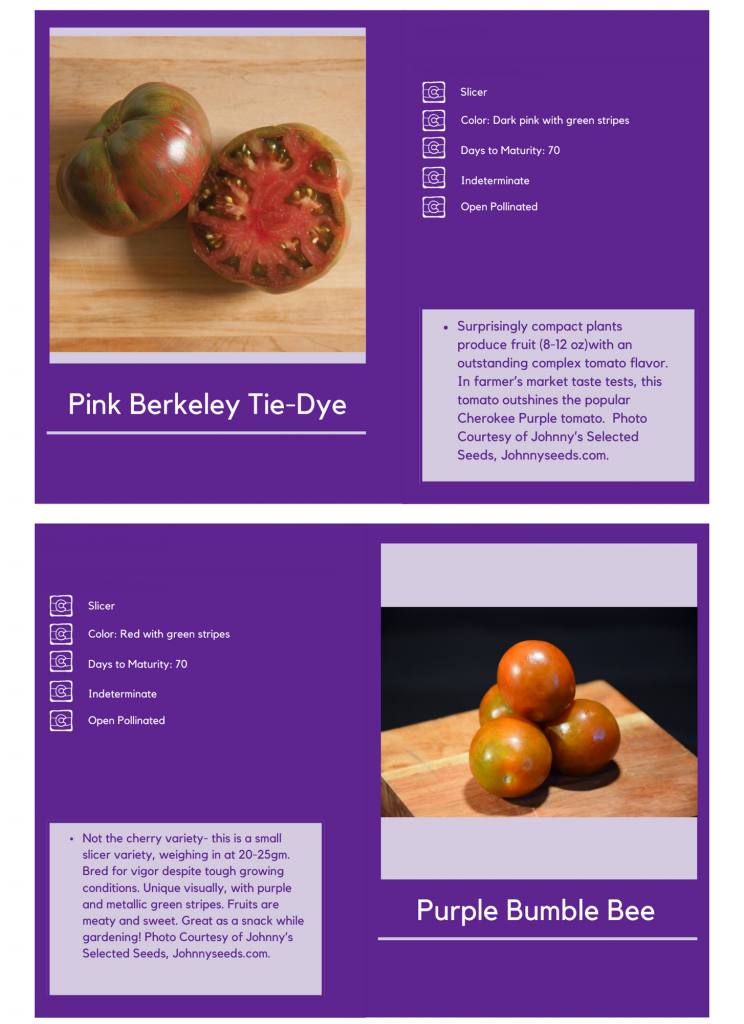
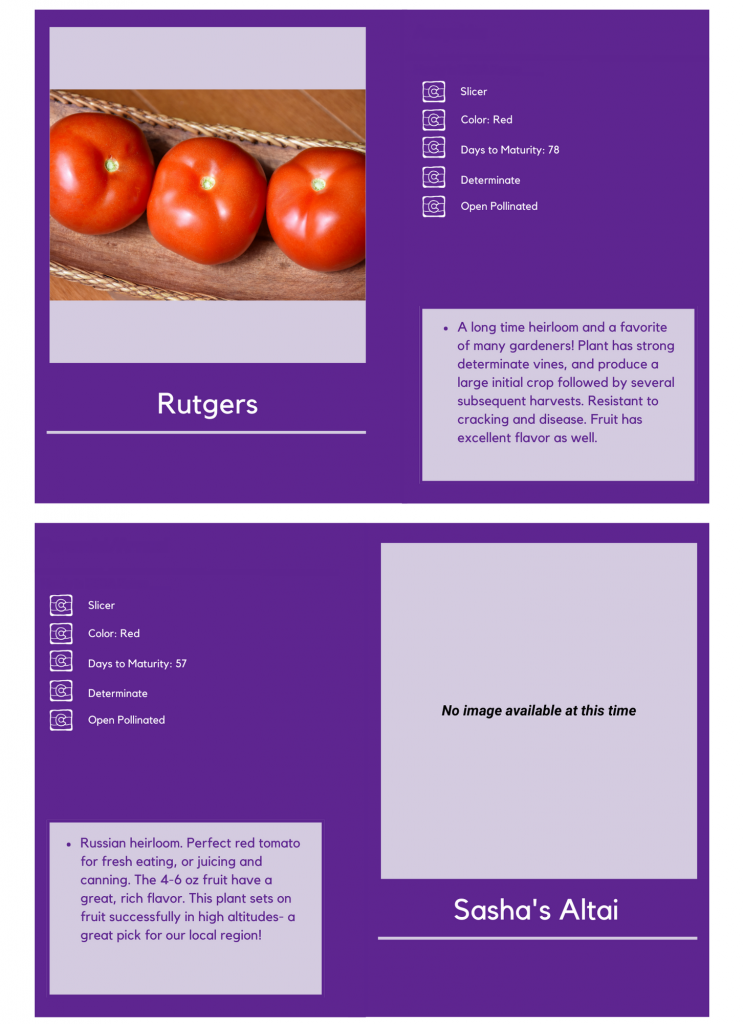
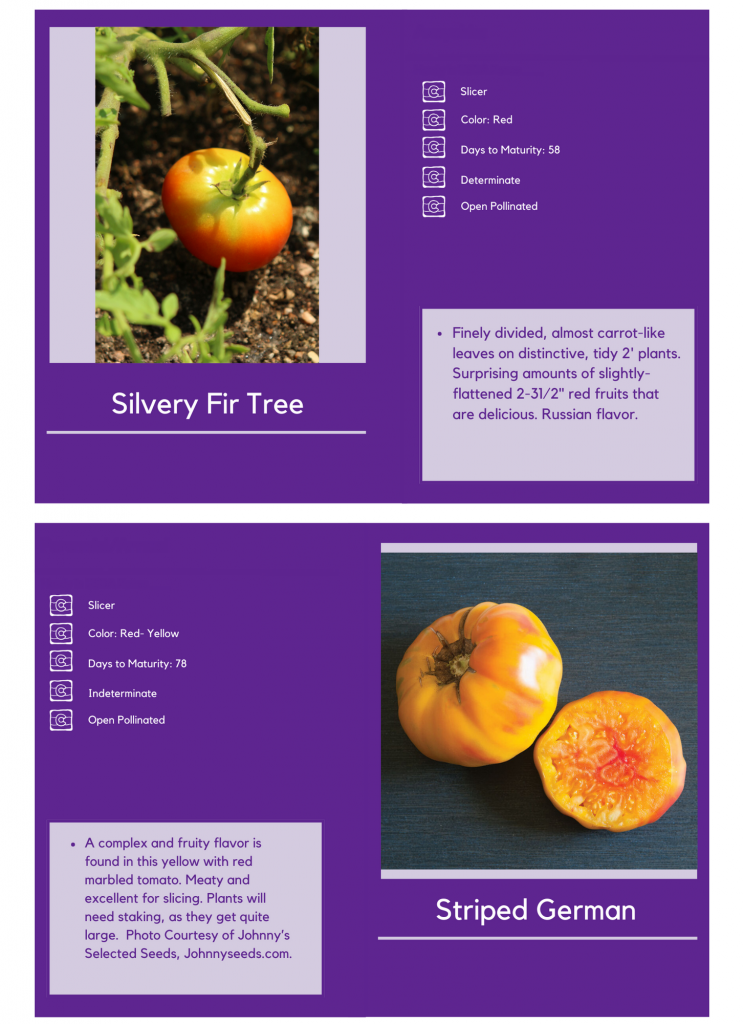

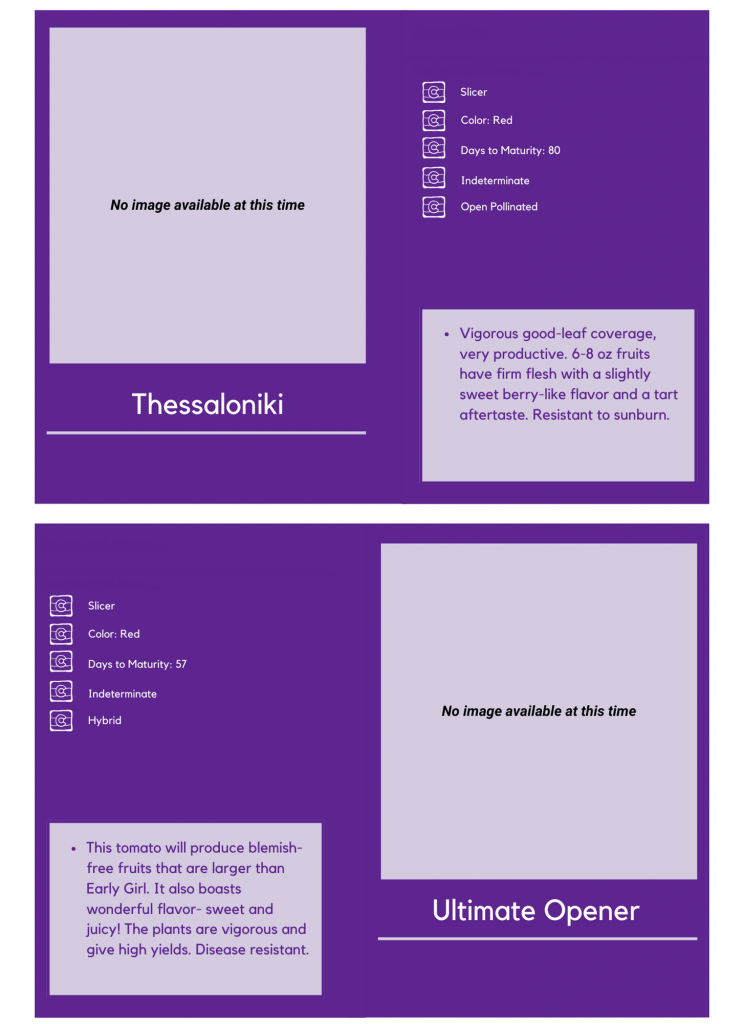
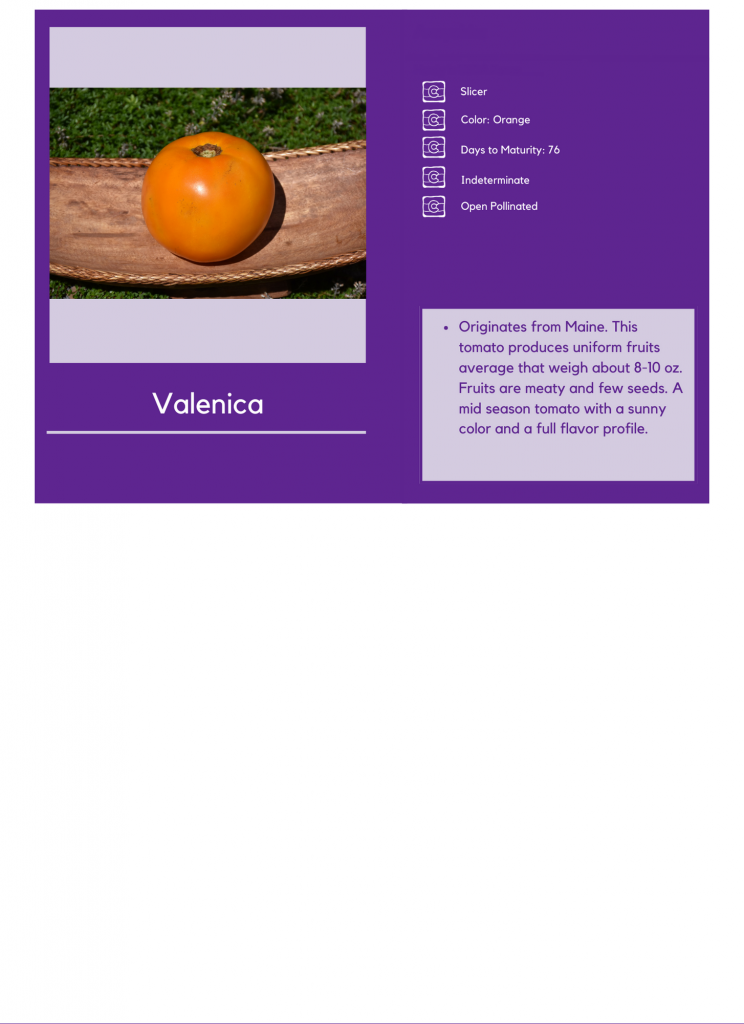
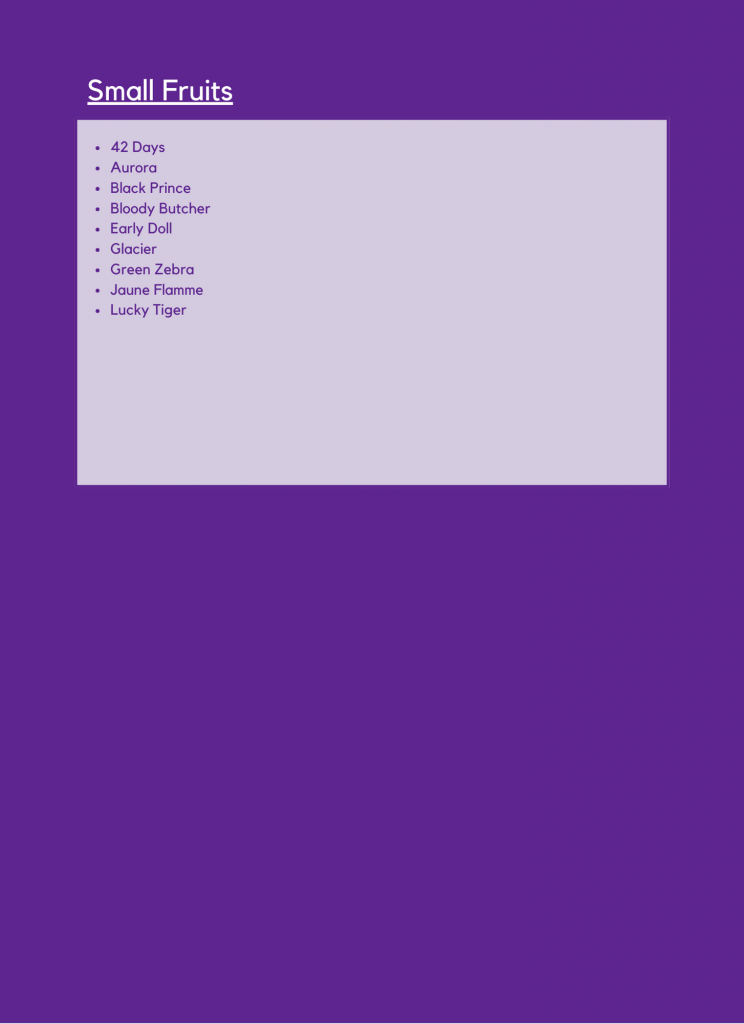
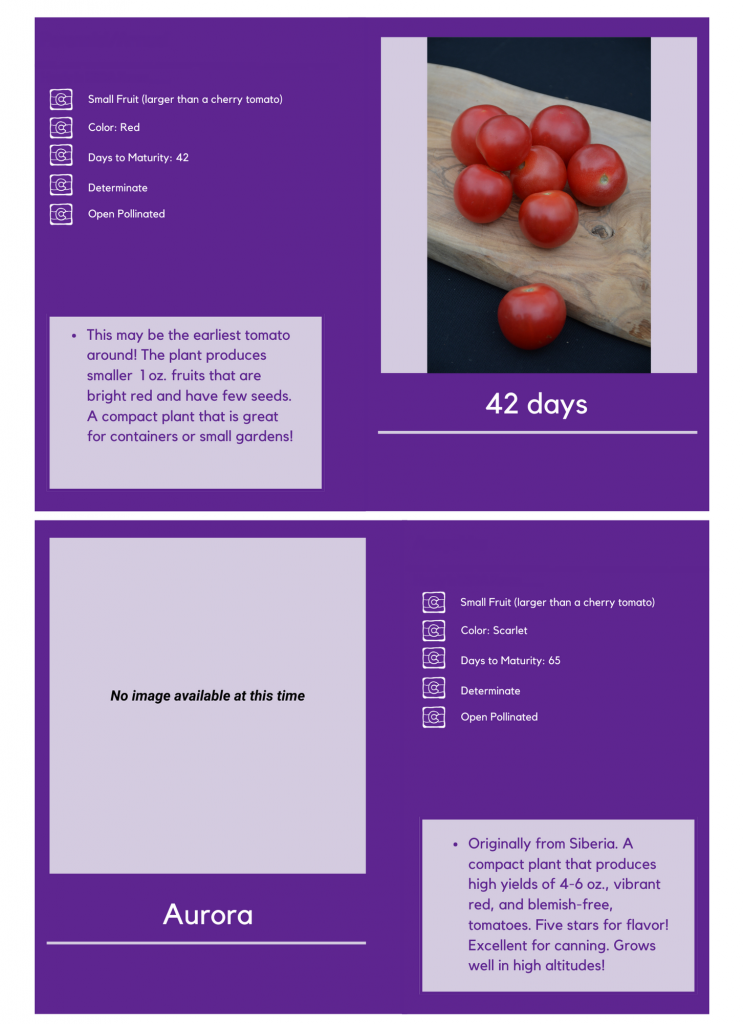
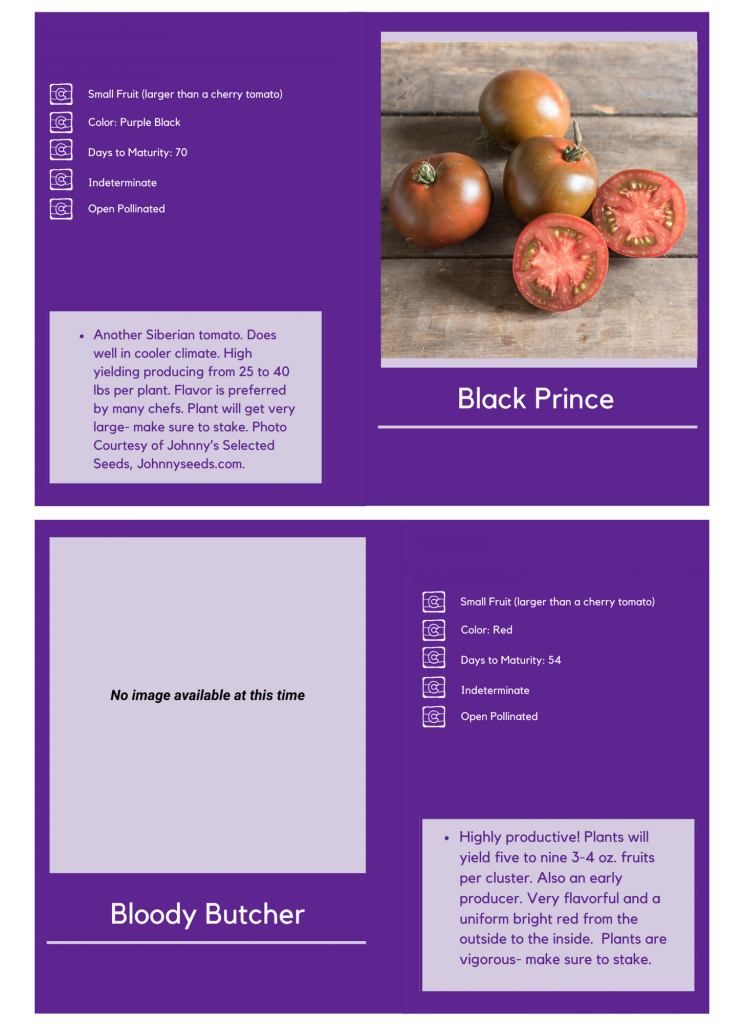

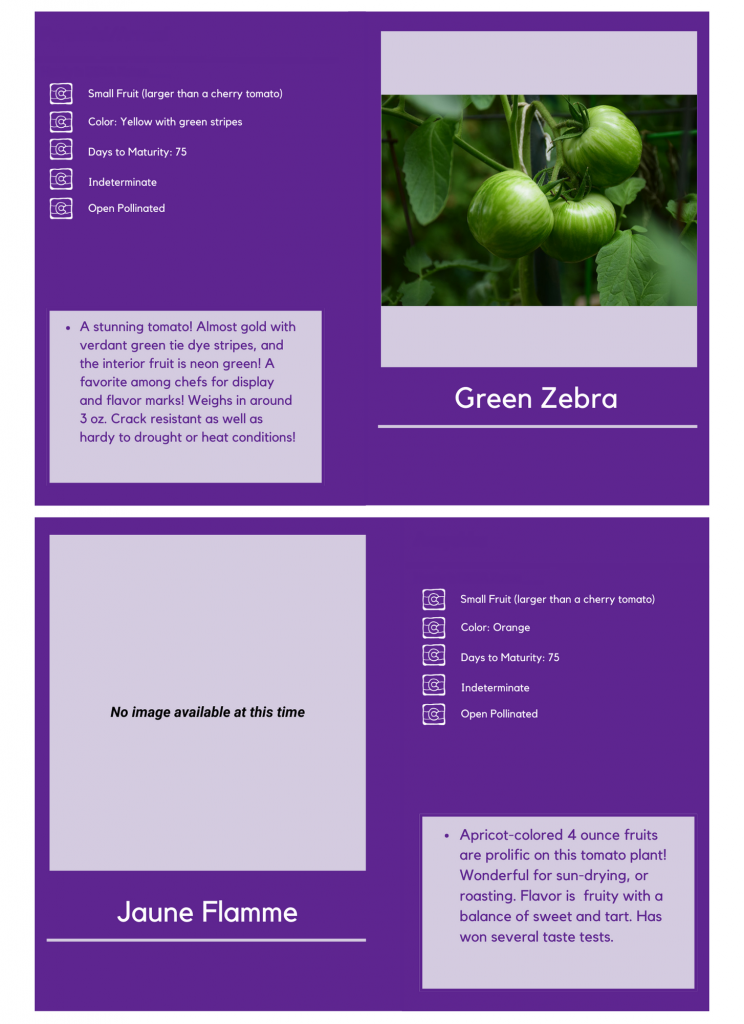


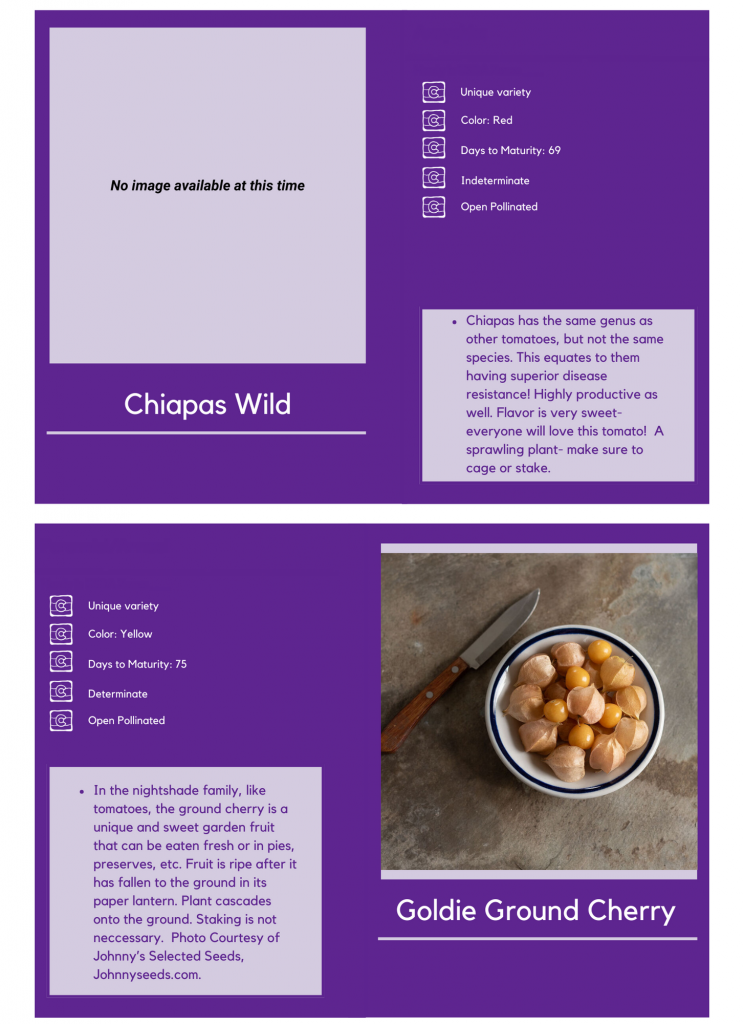
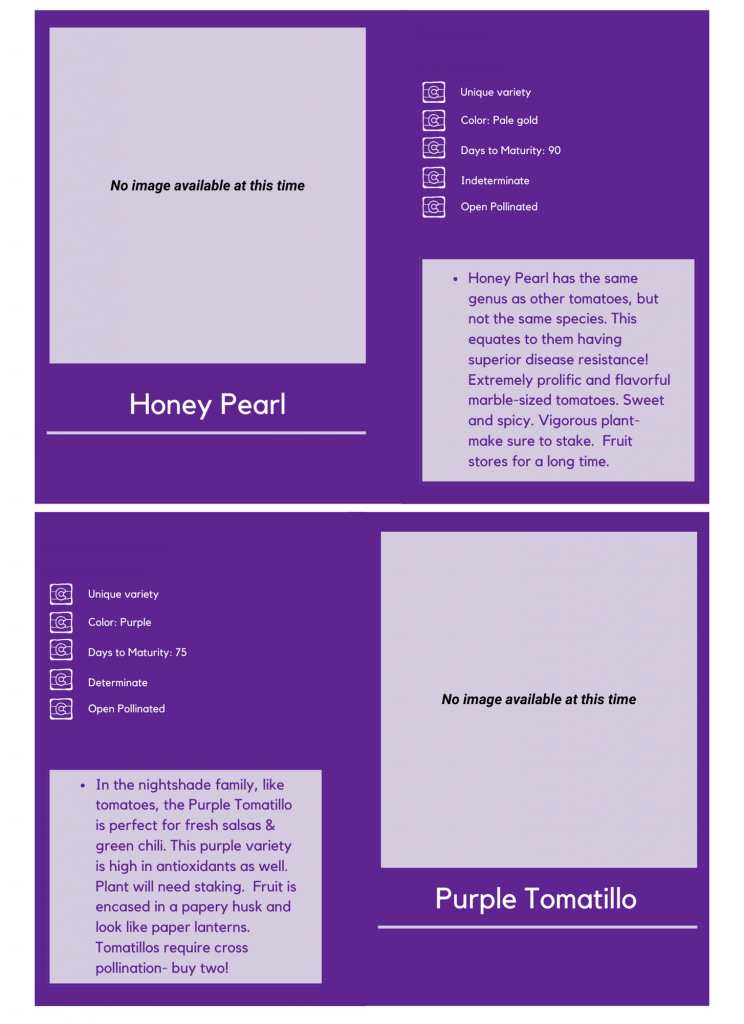
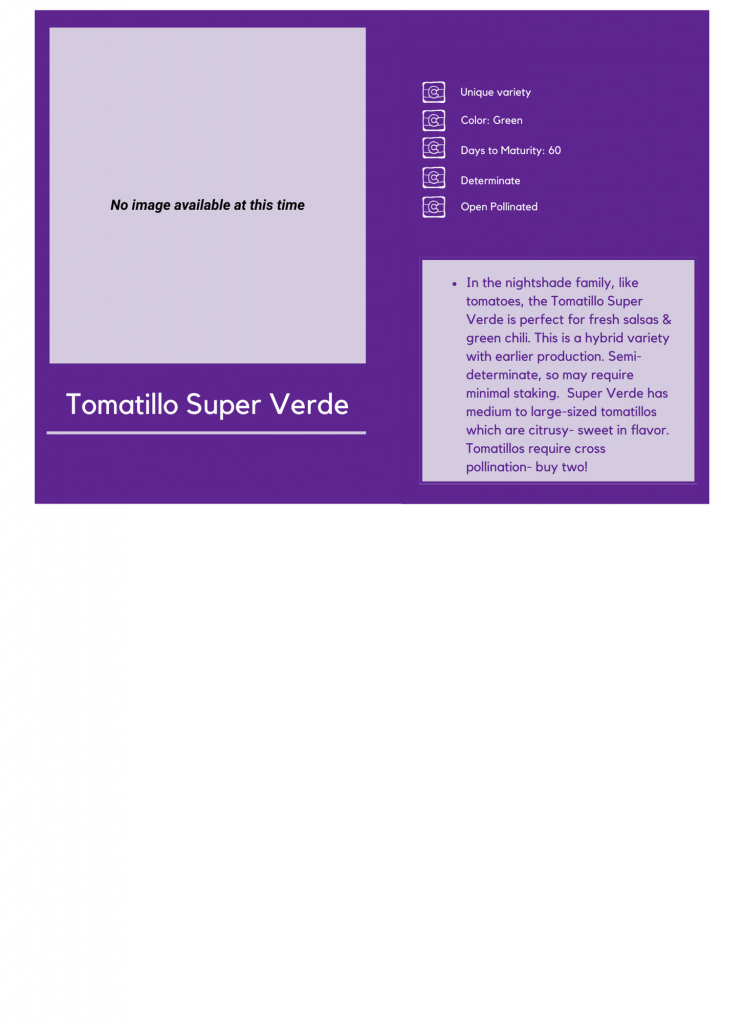
The Gothic Vegetable Garden
By Katherine Placzek
Black & purple vegetables are not only for someone who is looking for a fun or Gothic vibe in their garden. Purple-ish fruits and vegetables have higher antioxidants, which play an important role in protecting your cells against heart disease, cancer, and other diseases. So it is healthy for you to plant and eat these dark maroon beauties!
All of these vegetables are carried by us as seeds through the Botanical Interests or Lake Valley Seed brands (both CO businesses). There is a wide array of purple/ black vegetables so feel free to go down the rabbit hole and create the dark and mysterious garden of your dreams! Note that various seeds may be out of stock throughout the season.
Amaranth
Burgundy: These plants offer beauty and sustenance! The plants can get tall and have elegant and eye-catching burgundy plumes that can be used in flower arrangements. The seeds were a major crop of the Aztecs, and are very high in protein and other nutrients. Cook the beige seeds like rice. Young leaves are also edible- use them in salads or steamed. The birds will also enjoy the seeds!
Basil
Cardinal: Cardinal’s’ deep crimson blooms allow this basil variety to be utilized beyond its culinary qualities! Use it as a surprising accent in a mixed container, or use it as a cut flower! The fragrance is lovely. With its strong scent, a little goes a long way in the kitchen. A wonderful dual-purpose herb.
Purple Petra: A deep purple, this basil adds vibrant color to any dish! A more mild basil- great for those who just want the essence of basil in their cooking. ‘Purple Petra’ can be used to make an elegant pink-tinted vinegar also! Use it as a companion plant to your nightshade veggies or as a statement plant in an herbal ensemble or annual flower container.
Purple Opal: Opal Basil has eye-catching purple leaves, and will bloom during the summer with light pink flowers. Feel free to fall in love with this variety! Grow it just for its rich beauty or for its culinary uses. Highly flavorful, this basil variety has flavor notes of cinnamon, anise, mint, and clove!
Siam Queen Thai: This beautiful basil has a complex sweet and spicy flavor with a hint of anise. Broadly used in Thai and Vietnamese dishes- it is versatile! It is easy to grow and highly ornamental with its dark amethyst blooms. Flower farms also grow Thai basil, for cut bouquets. Include it in your garden flower bunch and enjoy the unique fragrance. Bees also love this stuff!
Sweet Thai: Thai basil is of course a popular herb in many Southeast Asian cuisines, and is most regularly highlighted in a warm bowl of Vietnamese pho. This variety holds its flavor and texture through cooking more than other basils. Lovely in salads or when eaten fresh. Sweet Thai’s dark purple flowers and intoxicating scent allow it to double as an excellent addition to the flower garden. Produces well in containers also.
Beans
Royal Burgundy (Bush): Royal Burgundy has yummy purple pods that are easy to spot among green leaves. A wonderful variety to grow in cool weather and is unlikely to be challenged by bean beetles. A good container variety, as well as disease-resistant.
Trionfo Violetto (Pole): Trionfo Violetto’ translates to “purple triumph.” This Italian heirloom will win your heart, with its crisp and flavorful purple pods. While highly ornamental the plants are also highly prolific! The plants climb 6’–8′, and have prolific light amethyst flowers that bloom against green leaves that sport purple veins and stems. Similar to other purple beans, the pods magically turn green when they are cooked!
Beets
Bulls Blood: Plant one row of this beet variety for the beautiful greens, and another for the flavorful roots! ‘Bull’s Blood’ is valued for its tender, sweet, and deep red– almost plum foliage. Originally selected from a French heirloom for the darkest colored leaves, the 16″ “greens” are rich in nutrients! The roots are delicious as well, especially so, when harvested small. Use in succession planting as multiple crops are possible throughout a season.
Broccoli
Burgundy: This variety of broccoli is considered a “sprouting broccoli” since it produces one small main head, but then produces generous side shoots. Purple broccolis tend to be tender, flavorful, and full of antioxidants! ‘Burgundy’; is tolerant of a wider range of temperatures, which allows a longer harvest period. Some gardeners prefer to pinch the main floret off early on, to encourage more abundant side shoots. Also resistant to the disease, Fusarium yellows.
Cabbage
Red Acre: Jazz up cole slaw or any stir-fry with this gorgeous, deep-fuchsia cabbage! This variety has a very fresh and sweet flavor. Solid heads form early and grow on compact plants making ‘Red Acre’ an ideal choice for urban gardeners who may have limited space. Resistant to splitting as well as cabbage yellows disease. The heads store very well, in the refrigerator or a root cellar. A variety you must try!
Carrots
Cosmic Purple Carrots: While various colored carrots seem to be the new fad, they have been around for centuries. In fact, the purple carrot has been around for at least 1,000 years! While previously unpopular compared to orange carrots, purple carrots have been rediscovered, and rightfully so! Besides being high in vitamin A, purple carrots contain anthocyanins (an antioxidant) that are common in blueberries. Kids will love them!
Eggplants
Black Beauty: A beautiful nearly black vegetable with lovely, lavender blossoms pretty enough to grow in the flower garden! ‘Black Beauty’ has set the standard since 1902 for large and high-quality fruit. When harvested at its peak, the skin is tender, so no need to peel it; making it perfect for eggplant parmesan, ratatouille, and grilling!
Finger Fruit Purple: Grow fast-producing clusters of beautiful eggplants on your patio or a sunny corner of your vegetable plot! These 4-6″ fruits contain few seeds and have thin, tender skin—perfect for stir-fries and roasting. A plethora of royal purple fruits on just 22-38″ tall plants make this variety a perfect fit for containers and small gardens.
Jewel Amethyst: ‘Jewel Amethyst’ is perfect for containers, since it has a tidy habit. You will also notice its growing pattern makes harvesting a joy! The oval, purple fruits are best harvested when about 3”–4 ½” long, to stay tender. Harvest regularly from this variety to keep eggplant producing throughout the season.
Long Purple: This long, slender variety, is not usually found in grocery stores, and is a treat! Sometimes called ‘Italian Long Purple’, this prolific heirloom will bring beautiful ruby-purple color to the garden and savory goodness to the table. Enjoy in a wide variety of dishes!
Kohlrabi
Early Purple Vienna: Early Purple Vienna kohlrabi is an easy-to-grow cool weather crop that forms a distinctive dusty lilac bulb with pale flesh above ground. A beautiful plant! Peel its crunchy bulb and enjoy it raw or cooked. Leaves are also edible- eat similarly to collards, or other steamed greens. Kohlrabi is high in fiber, making it an excellent veggie for overall gut health. Kohlrabi is also high in isothiocyanates and glucosinolates, which are powerful antioxidants, thought to lower the risk of certain cancers, heart disease, and inflammation. Keeps well in the fridge.
Lettuces/ Greens
Brentwood Lettuce: This variety produces pretty burgundy lettuce leaves making for some beautiful salads! The heads produce high yields in compact spaces, and their bolt resistance allows for a long harvest. Also resistant to downy mildew, lettuce leaf aphid, and Fusarium wilt.
Dazzling Blue Kale: You will be mesmerized by the beautiful colors of this extra-cold-hardy kale. It is even more cold-tolerant than other lacinato types. The purple midrib pops against the blue-green leaves, some of which may take on more purple hues in the cool temperatures of fall. Lacinato kale is ideal for kale salads. Pick tender, baby greens for fresh salads, chips, or sauteing, in just 30 days!
Marvel of Four Seasons: Tasty and attractive, this 1800s French heirloom is also known as Merveille de Quatre Saisons. The variety has sweet and tender leaves that are chartreuse green at the base, turning to a beautiful cranberry-red, and forming a crinkly rosette! Gorgeous! Rosettes are 8″–12″ in diameter and good for large containers.
Red Russian Kale: Typically, kale gets sweeter after the first fall frost. ‘Red Russian’, on the other hand, is sweet and tender all the time. The lavender veins are part of what makes ‘Red Russian’ as attractive as it is delicious. Harvest baby greens in just 21 days!
Truchas Mini Romaine: This deep-merlot, mini-romaine is a game-changer for salads! ‘Truchas’ is compact and easy to grow in small spaces. It also creates gorgeous contrasts with green lettuce. Uniform leaves stay upright in the garden and make for easy plant cleanup. Has disease resistance to downy mildew, lettuce die-back, and lettuce mosaic virus.
Nasturtium
Black Velvet: These edible beauties add glamorous, ruby-black color to your salads and cheese plates! All parts of the flower (leaves, seeds, stems and flowers) are edible! Garnish tacos, avocado toasts, and pasta dishes with these beauties! Excellent as a companion plant to your tomatoes, and they repel several pests. Gorgeous in containers as well.
Tom Thumb Black Velvet: Tom Thumb features velvety, nearly black flowers with contrasting bright green foliage! Compact plants make this an outstanding choice for the border and containers. All parts of the flower (Leaves, seeds, stems and flowers) are edible! Add flowers to charcuterie boards, gazpachos, strewn on roasted root veggies, or create vinegar from them, for various culinary experiences!
Okra
Red Burgundy: Whether you eat okra or not, this plant is worth growing, just for the beauty of it! The pods are deep crimson edging toward maroon and are preceded by gorgeous yellow flowers that the bees love. This is the most productive red variety and will produce tender, 6″-long pods that are delicious in soup, gumbo, and stew, or deep-fried.
Shiso
Green and Red Shiso Perilla: An absolute must for herb gardens! Also called Japanese basil or the beefsteak plant, shiso’s incredible flavor can be described as a combination of cinnamon, mint, and clove with notes of cumin. A beautiful, heat- and drought-tolerant bedding plant that attracts pollinators, and is excellent for containers. This packet provides 75% green shiso and 25% red (shows up as a deep mulberry color).
Snap Pea
Sugar Magnolia: Wow, a purple snap pea that is tender and delicious! Enjoy the pretty purple blooms first, then the purple pea pods. Eat them without shelling, dipped in hummus, in a salad, or in stir-fries! Long hypertendrils (vigorous, multi-branching tendrils) support the 6′-7′ vining plants. This growing pattern creates an airy structure that helps prevent mildew. Some of these open-pollinated peas may be flecked with green, or be fully green.
Tomatillo
Purple: A purple tomatillo! Not only delicious but alluring also. The purple fruits are much sweeter than the green types and rich in antioxidants. Let the fruit remain on the plant as long as possible until the papery husks split for the best flavor and color. Tomatillos grow best in conditions similar to tomatoes (because they are related) but will handle a lot more heat. Tomatillos require cross-pollination so plant at least two plants in your garden to ensure good fruit production
Tomatoes
Black Krim: This Russian pole heirloom originated in Krymsk on the Black Sea in Russia. Baseball-sized fruits weigh 10–12 ounces and have dark reddish-brown flesh filled with a rich, slightly savory flavor. Fruit sets well in heat and is a reliable “black” tomato, producing even under adverse conditions from summer to fall. Make sure to stake or cage, as the plants can reach 6′ or more!
Cherokee Purple: Cherokee Purple’ is said to have been given to a Tennessee family by the Cherokees over 100 years ago. This dark maroon tomato has just the right balance of sweetness and even a hint of smoke, making it a winner in taste competitions. From summer into fall, you will harvest lots of 10–12 oz. tomatoes from this well-regarded heirloom variety. Make sure to stake or cage, as the plants can reach 6′ or more!
Chocolate Cherry: Chocolate Cherry tomatoes—Yum! These 1″ purplish-red, delicious tomatoes are great for snacking on and add a bit of sweetness to salads and pasta. The prolific vines bear seemingly endless trusses with 6–8 ounce fruits that will bring you back for harvest after harvest. Fruit is crack-resistant! Make sure to stake or cage.
Watermelon
Sugar Baby: The taste of summer? Watermelon! As the name suggests, ‘Sugar Baby’ is sweet, sweet, sweet! It is also small enough to easily fit in the refrigerator. This plant produces a bountiful crop of 8–10 pound deep dark emerald green orbs that have juicy red flesh.
Zucchini
Black Beauty: Black Beauty is an early maturing zucchini-type squash that features delicious deep black to green fruits with pale flesh. A very easy-to-grow bush variety that is highly productive all summer long. Enjoy grilled, sauteed, fresh, in soups, or zucchini bread!

An Interview With Allisa Linfield
While I spoke to Allisa Linfield in November, you cannot sense the time of year as we begin our video chat. Her office space is filled with warm Colorado sunshine and she has plants filling the space. There is a happy jade plant to her right, and pictures of native plants pinned to the back of her cubicle. Allisa greets me with a warm smile, and I immediately feel welcomed by her.
Allisa’s journey as a plantswoman began in the backyard, gardening edibles. She started noticing that when she observed plants, she learned even more about the world around her. This included small variations in weather patterns from year to year. As she continued to garden, she met other plantspeople. With these new connections, she realized that “We all could have this shared experience where we remembered periods of time based on what happened to the plants and how the weather affected them, or if there was a particular insect that was of interest that year.” She eventually began the Master Gardener program, and after completing her volunteering component, Linfield realized this was what she wanted to do as a career. She eventually joined the staff at the CSU Extension Office for El Paso County. Her current role is the Horticulture Program Coordinator. Her primary responsibility lies with coordinating volunteers, especially those who work within the Master Gardener program. Her enthusiasm is evident, even when describing the Extension office’s role. “Through Extension, we are the outreach arm of the university (CSU), so we get to take research-based information to the people, and have conversations… I love coordinating our Master Gardener program.” She is quick to share gratitude for the ones who are around her, doing similar work, and those who have mentored her in this field. “I am really lucky to have a colleague and mentor, Irene Shonle, who also shares a love for native plants.” Irene works in the Extension office with Allisa. “She (Irene) has brought back the Colorado Native Plants Master Program in our county.” Irene and Allisa are a couple of the trainers at the extension office who are increasing the native plant courses that are offered in El Paso County. “These courses provide an opportunity for the community to learn field botany and plant identification. We talk about how to use botanical keys, and we talk about the impact of invasive plants and noxious weeds. And then we also talk about human uses and landscape uses of plants.”
Allisa’s relationship with native plants began similarly to many, with little to no knowledge about native plants. “Like many people, I did not fully understand what a native plant was. Many people have an idea about what native plants are; that they are good for pollinators and that they may not require very much water. Frequently people will tell me that they love native plants and that their favorite flower is coneflower, Echinacea purpurea. It is a North American native plant but it is not native to Colorado. Or they’ll say that Russian sage is their favorite native. I always just smile. Everyone starts from this place, where there is this plant in the landscape and it is surviving somehow when everything else seems to not be doing well. And there are bees around it. What they are telling me, is they are noticing these things for the first time. They want to learn more and do more. Then they notice, ‘Oh yeah, Russian is in the name, Russian sage. Oh, that’s not native. These bees buzzing around this plant are European honeybees.’ But it’s a gateway. It gets them interested. And I think that similarly, I started out growing my food plants and I started noticing things like bees, and interaction with other insects. Then I started looking into plant identification. I do a lot of trail running through the mountains, and so I get to see these really cool alpine plants that aren’t around in the foothills and the plains.” When she first began to identify plants in the field, Linfield encountered frustrations. Gaps exist in guidebooks, either description-wise or image-wise. She was lucky enough to cross paths with Irene at the Extension office within her Master Gardener program at this time. Serendipitously, Irene was beginning to restart the Native Plant Master Gardener program again in El Paso County. Allisa jumped at the opportunity and completed three native plant courses. This led her to become a trainer in the program and instruct others in the program the following year. From there, her world has been “all about the native plants.” Allisa grows many from seeds, and she even has a fridge dedicated to stratifying these seeds! Her trail runs are now called “speed botanizing” because she spends just as much time running as she does documenting any of the native plant species she sees along her runs, through pictures and the popular citizen science app, iNaturalist.
Her current native plant crush is hard for her to initially pick out. Allisa sits back in her chair with a happy and contemplative smile. “Ok. So, it’s really hard to pick. I was just thinking about this the other day…. I was organizing all of my seeds by plant family, and realizing that I have certain plant families that are my favorite and other plant families that are not…One plant family that I am very intrigued by right now is Polemoniaceae. And common plants in that family that people might know are Ipomopsis– a genus that they might know. Or Gilia. People may have heard of Fairy Trumpet or Skyrocket Gilia (there are a lot of common names for it). But that is one in the horticultural industry that they see, Ipomopsis aggregata. I would not say this plant is my crush but the family Polemoniaceae is. In addition to Ipomopsis, it has Polemonium, which is Jacob’s Ladder, and there are a lot of alpine Jacob’s Ladders, like Sky Pilot (Polemonium viscosum), is a common name for one that I love. I guess you could say Sky Pilot is my native plant crush! It has these really cool…feathery leaves and these beautiful blue flowers. It grows in the harshest areas… It is so cool. You will be going through alpine tundra where nothing will grow and you’ll see this pretty luscious plant growing out of nothing.” She shakes her head in wonder at this statement. Linfield creates space for awe in a niche field that has been underappreciated and unpopular in the past.
It was shortly after completing her Master Gardener certification that she decided to embark on a master’s degree in horticulture. When Linfield began to decide on her research focus for her graduate program, she felt the draw to native plants. “But within horticulture, it is such a small niche, within the green industry that there are not a lot of people researching native plants. Therefore it is hard to find mentors, or faculty who can support research in that area.” She was able to connect with Dr. Jennifer Bousselot, who had the perfect research project in mind. Her master’s thesis and research are exciting, especially for nursery production. Her research focused on the nursery container production of native plants, by “using different substrate amendments in containers, to see if there was any impact on plant growth response.” Finishing protocols for growers is an outcome of her research that will help growers be more educated about native plant production. One of Linfield’s main objectives is to bring “recommendations to growers, so plants look the best that they can, so they can compete at retail.” This is noteworthy research. In the industry, there is a continual conversation about the visual performance of native plants compared to non-native ornamental plants.
The learning points of this extensive research indicate that native plants do not have significant growth results due to different substrate amendments when the main growing medium is a peat moss mixture. While not seemingly earth-shattering, this is groundbreaking and is guiding her future research. This conclusion opens a frontier of the vast capabilities of native plants’ resiliency and implicates more sustainable growing substrates for future research. This new research may allow Allisa “to be able to tell growers this (peat moss soil mixtures) is not going to have a significant impact on growth of the plant, and then you can market your native plants accordingly, and show people that you are producing these by using more sustainable practices…The people who are buying these plants are often doing this because they want to reduce their water usage and create habitat and forage for native wildlife.” Since native plants and kinder landscaping practices are a trend in gardening, this research may encourage growers to change to a different production medium for their plants.
Allisa Linfield appreciates the label, plantswoman. Her face lights up, and she smiles as she explains, “Partly because I think we so frequently hear ‘plantsmen,” and I think that women sometimes have a bit of imposter syndrome when using the term plantswoman to describe themselves. We should own it!” When she announced that she was graduating from her master’s program, in December 2023, and that she would be carrying on for a PhD (also in horticulture), we both celebrated. “One more plantswoman in academia, right?” The world of plants can be very isolating as a woman, and we discussed further the importance of women who had come before her. She seconds her appreciation for Irene, who continues to mentor her with their common roles at the Extension office. “Many think of her as a state-wide specialist in native plants.” They collaborate a lot together, and Linfield jokes that they are one full-time person combined, as they both fill part-time roles at the Extension office. “Someone else who has been doing the work in our community is Catherine Moravec. She works for Colorado Springs Utilities and has been the force that made the demonstration garden on Mesa happen and continues to be such a resource for the community.”
Within the Master Gardener program, there is a required volunteering component. This past year, Linfield recorded the highest number of applicants for this portion. This is exciting and speaks to how necessary the Extension’s programs are for our community. “We would like to be able to take everyone, but we are not always able to, because we only bring on so many apprentices each year.” She recognizes that the community probably does not see the substantial work that her volunteers and apprentices commit to. Many components of the Extension office are completely operated by volunteers. The Extension office’s help desk is staffed by these unpaid volunteers. They answer your questions on the phone, over email, or even in person. They are very informative; identifying insects, and plants, supplying gardening advice, etc. One of Allisa’s future benchmarks is to make the help desk more accessible to the community. “Not everyone can come in during business hours, and sometimes people want to have a real conversation, not send an email and wait a couple days for a response.” Coming in the future is a virtual help desk with designated “open office” hours that will fall outside of their normal business hours. You may have seen another venue for master gardeners’ volunteer hours; Rick’s and other garden centers around the city have welcomed these volunteers during the height of the gardening season to answer community members’ questions and concerns. Another main thing that these volunteers do is help facilitate and teach classes taught through the extension office. Some of these classes are taught online or at the extension office, but the vast majority are special requests by gardening groups, clubs, schools, or other interested parties. There are a myriad of other ways volunteers can get involved, and the breadth of support that the extension offers to the community, with these energized volunteers, is breathtaking.
As for the future of gardening in the El Paso County area, Allisa has enthusiastic aspirations! The Master Gardener program is growing by 30% this year. People who are applying are not just retired people, which has been the case historically. Linfield encourages people to look into and apply for the program, even if they work full-time since more volunteer opportunities are increasingly flexible. The learning portion can be completely online for the benefit of those who are busy. One possible reason why this growth is occurring is many young people want to give back to this community. Allisa has a vision for the Master Gardener program in the future. “I would love the Master Gardener program to be a reflection of our community. That means we have lots of people from lots of different backgrounds, experiences, and thoughts. That we have people of all ages, that we have people of different races and ethnicities, genders, and different sexual orientations. I want to make sure that our volunteer group reflects our community so that we can serve the community to the best of our ability.” About the future of gardening in El Paso County, Linfield beams, “I love El Paso County; where we have so many different kinds of people who come to plants for different reasons, and with different motivations. I think we can be leaders in increasing gardening education, for youth, and having greater collaboration with all the little groups in our community.” She mentions there are new conversations, collaborations, and synergies between distinct groups of local farmers. This is an excellent start. “I think if we are all just open to collaboration, and that we are welcoming– that we can help serve the community better. And that gardening is the thing we have in common with each other”
Allisa wraps up our interview with the importance of natives, and why planting natives is an important form of habitat conservation and climate activism. “We have the exciting opportunity to use our own yards and landscapes as corridors for pollinators and other native fauna. We have these open spaces in Colorado Springs. West Colorado Spring is really lucky to have lots of parks and open spaces, but these spaces can become islands. We have lots of urban areas that might separate the islands, so we can plant natives so that we can make a corridor for pollinators and other wildlife to have both habitat and food and forage.” She goes on to explain the second main reason natives are so important. “Another reason is just out of necessity because water is becoming scarcer and scarcer. Our climate is hard to grow in, even when we have plenty of irrigation.” Linfield approaches her work with natives with an incredible amount of hope, a contagious hope! “That’s the really beautiful thing about native plants! You as an individual can make an impact. Sometimes in this world, things happen and we are like ‘Well, what can I do about it?’ And this is one thing you can do!”
Resources:
CSU Extension office for El Paso County: Native plants (this is an extensive resource- please check it out!): https://elpaso.extension.colostate.edu/native-plants-for-el-paso-county/
Master Gardener Program:https://cmg.extension.colostate.edu/
Native Plant Master Program: https://conativeplantmaster.colostate.edu/
Sign-up pages for Extension events: epcextension.eventbrite.com
Colorado Springs Utilities Demonstration Garden: https://www.csu.org/Pages/DemonstrationGarden.aspx
Plant Select: https://plantselect.org/
Resources through Dr. Doug Tallamy (a leader in the research being done on insects, birds and the nutrition/ habitat gained from native plants)
Book: Nature’s Best Hope (the Pikes Peak Library carries this in audio and book form)
Homegrown National Park: https://homegrownnationalpark.org/
